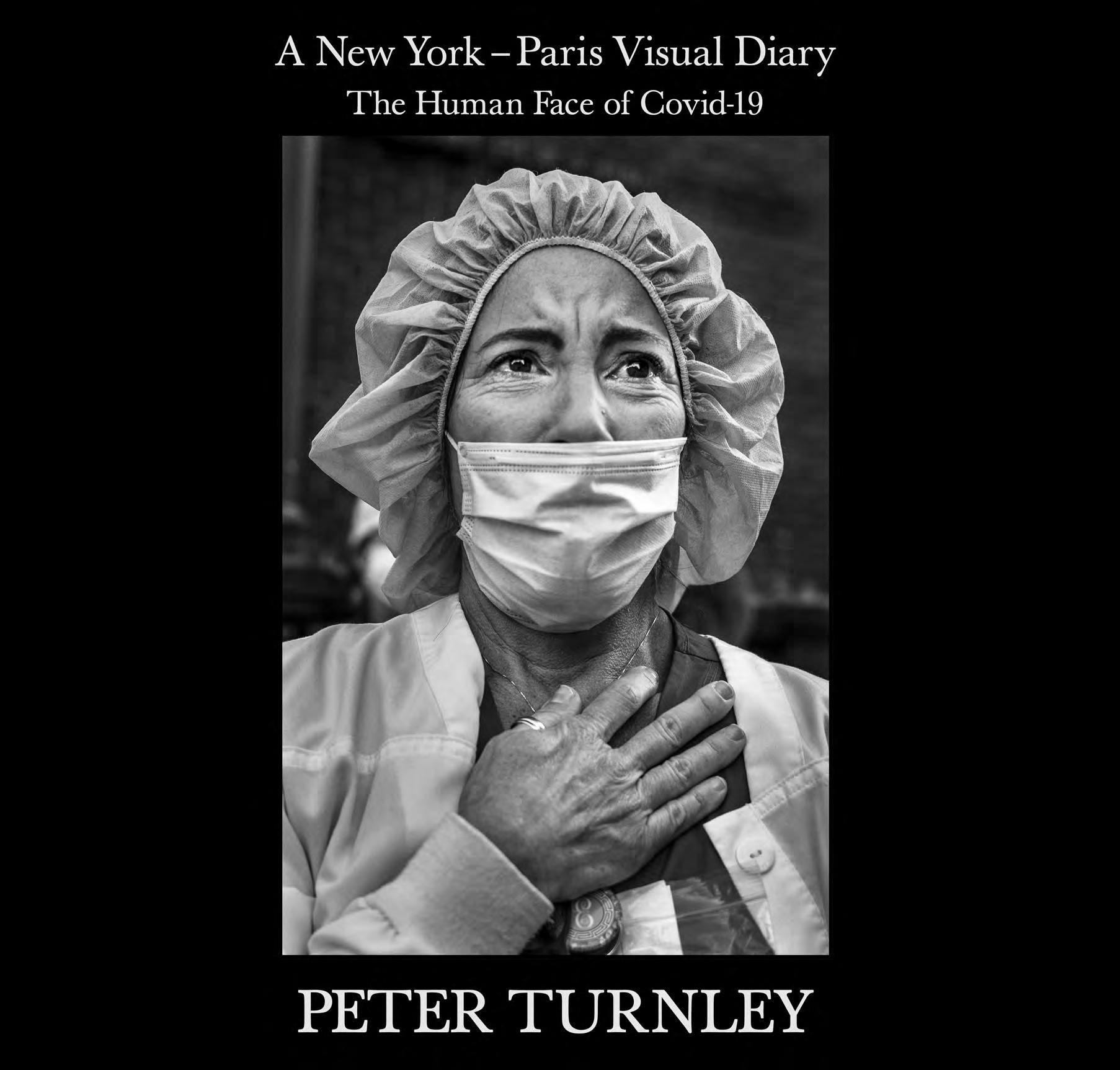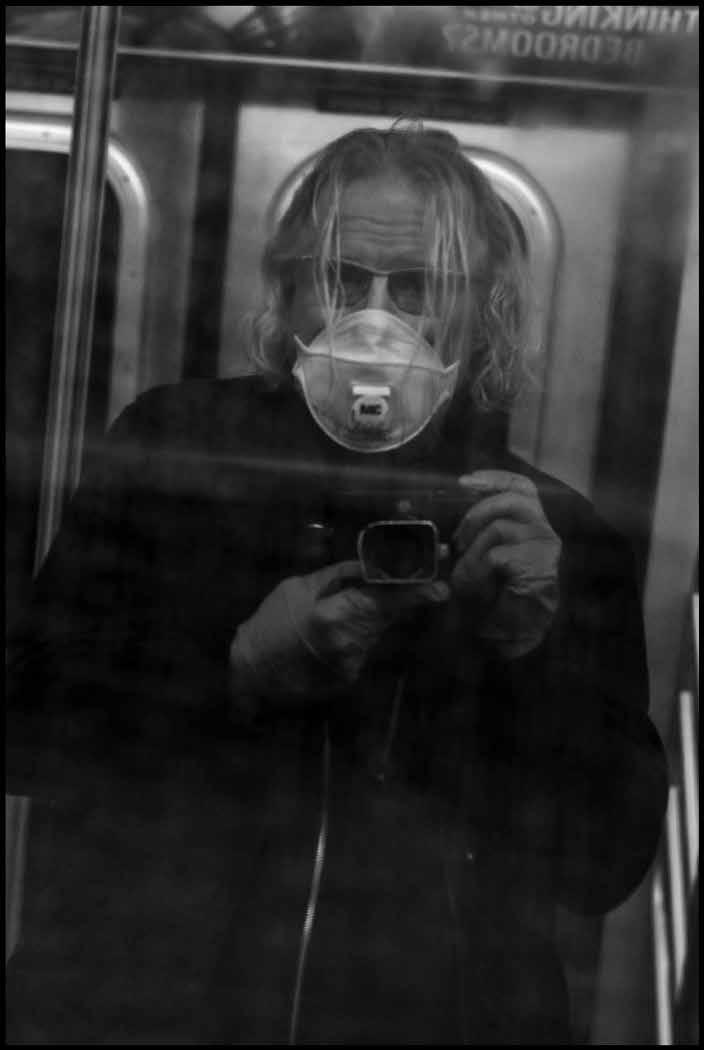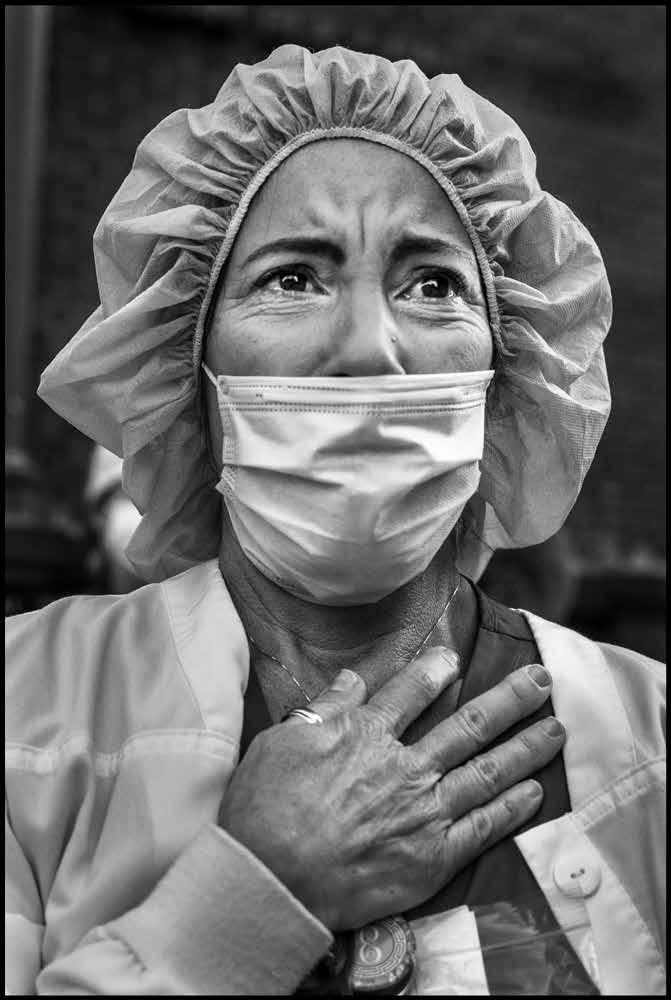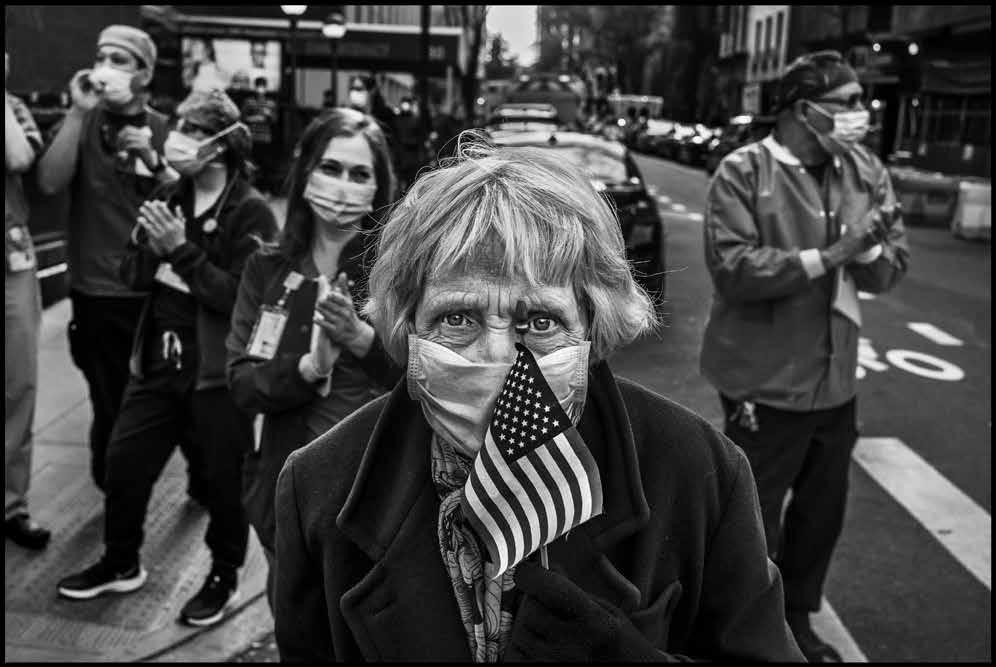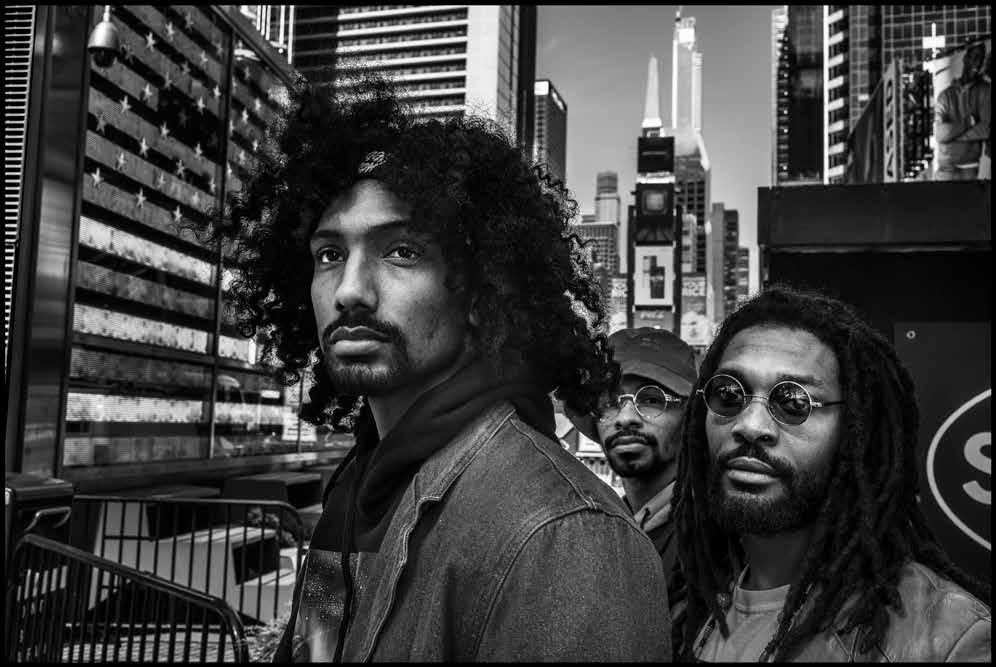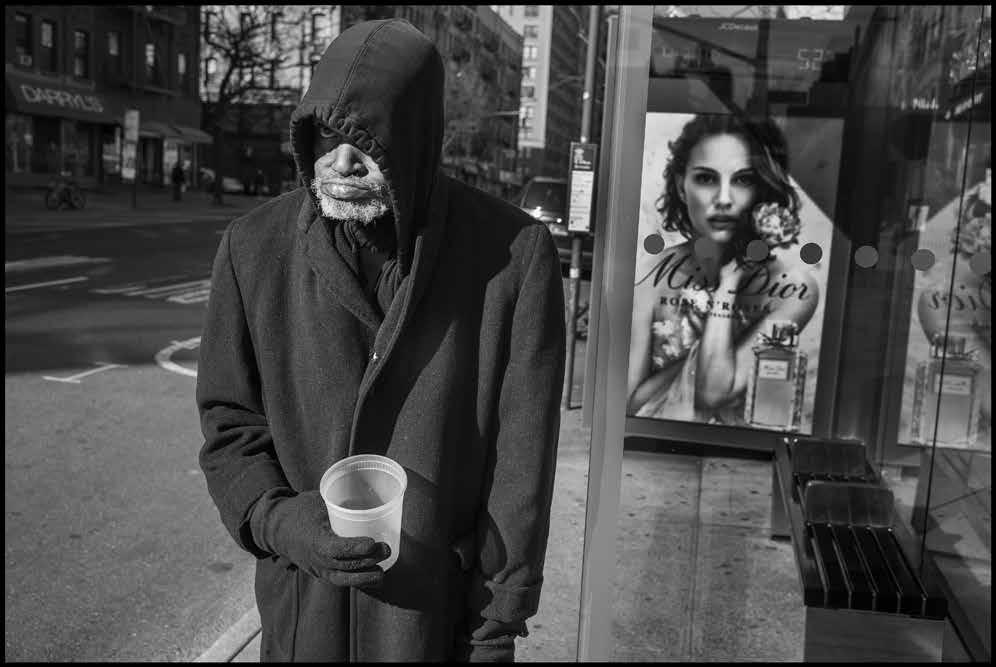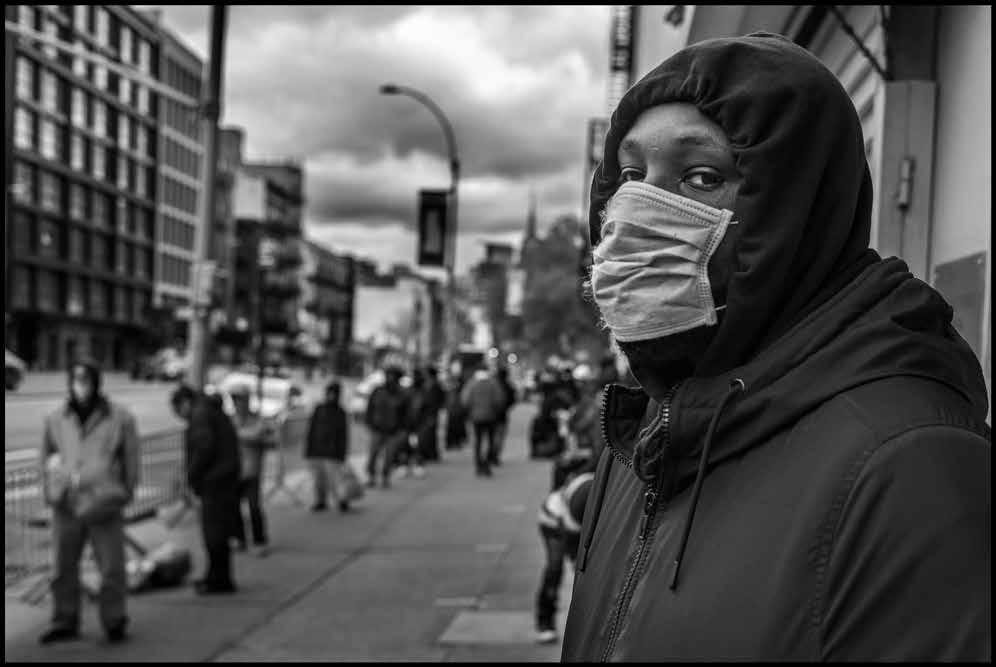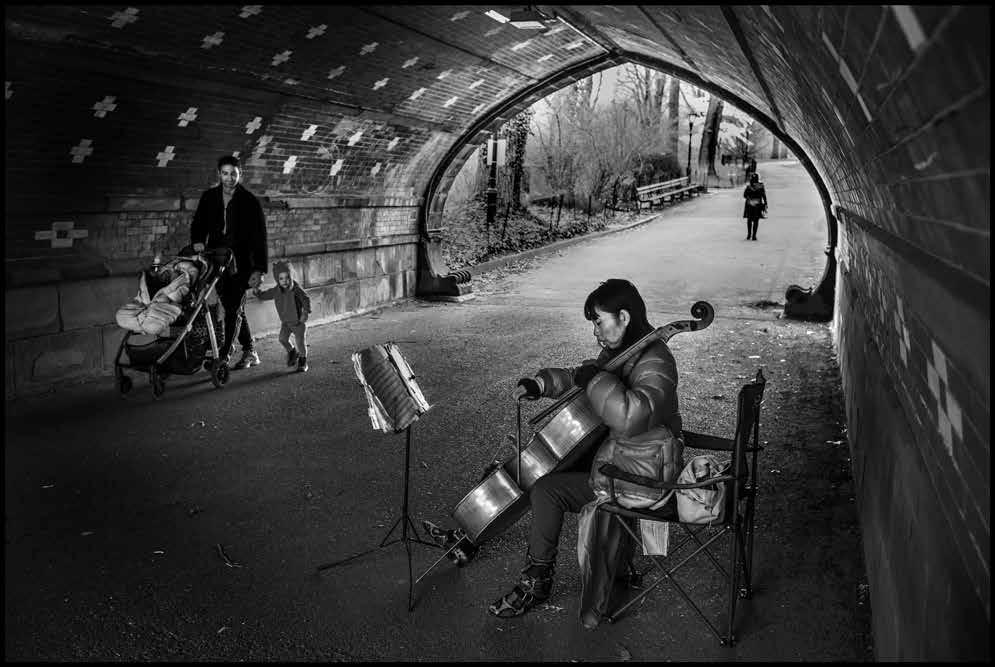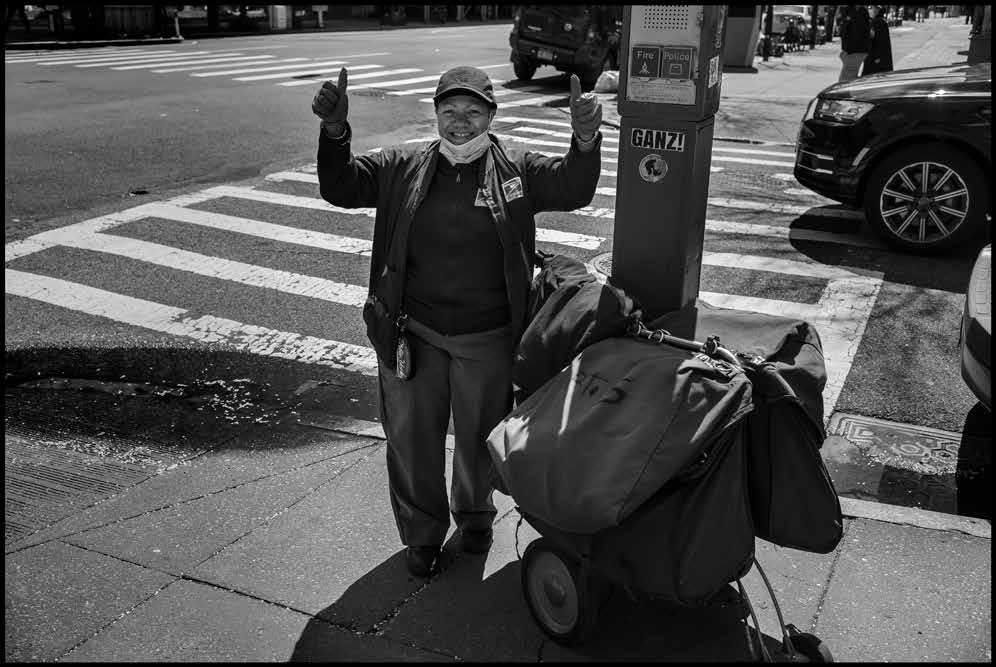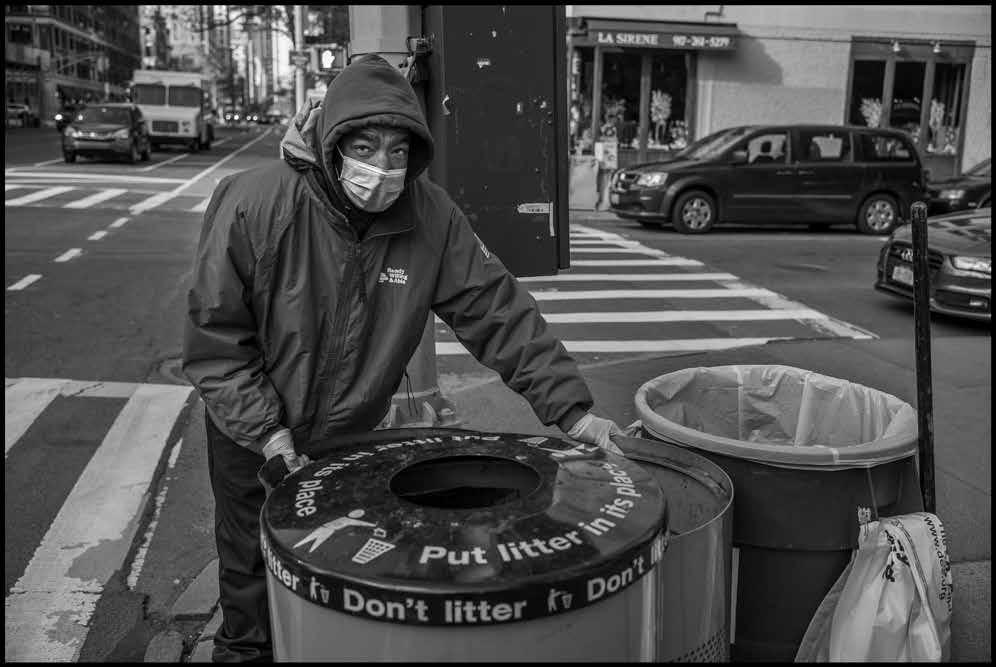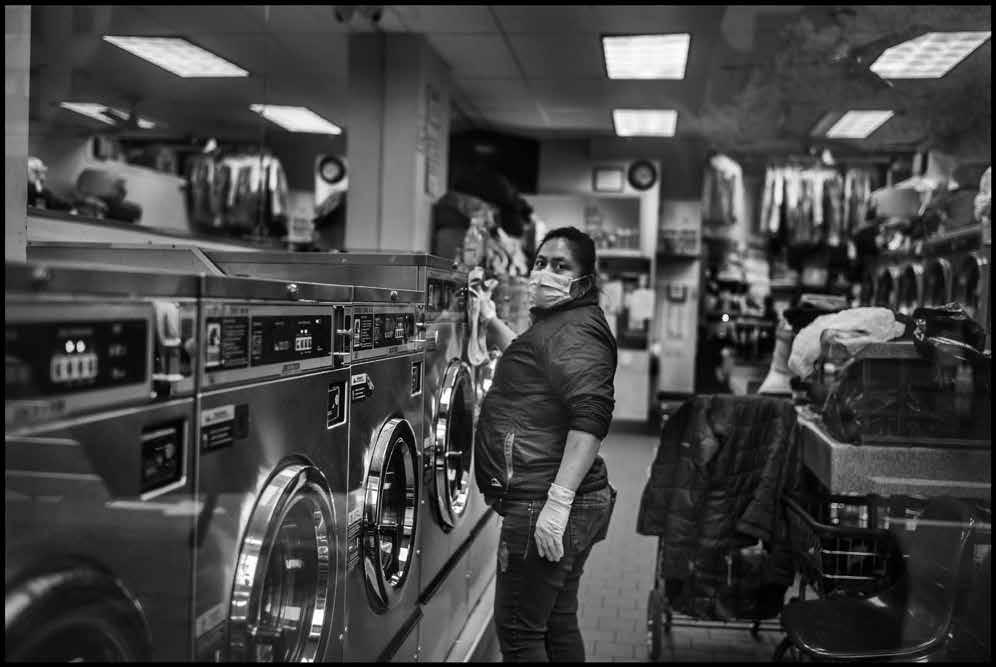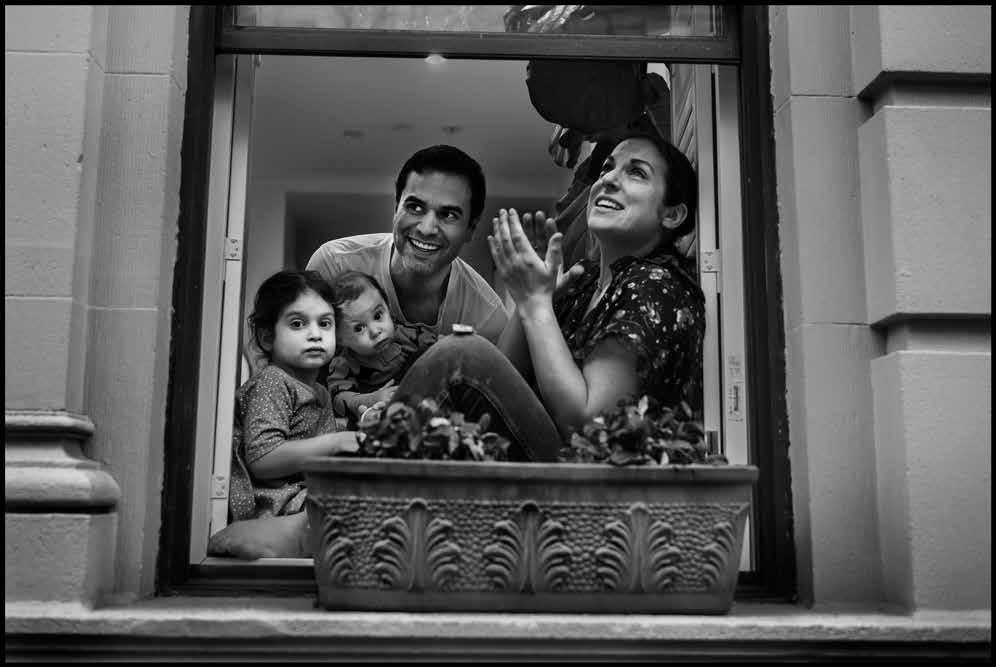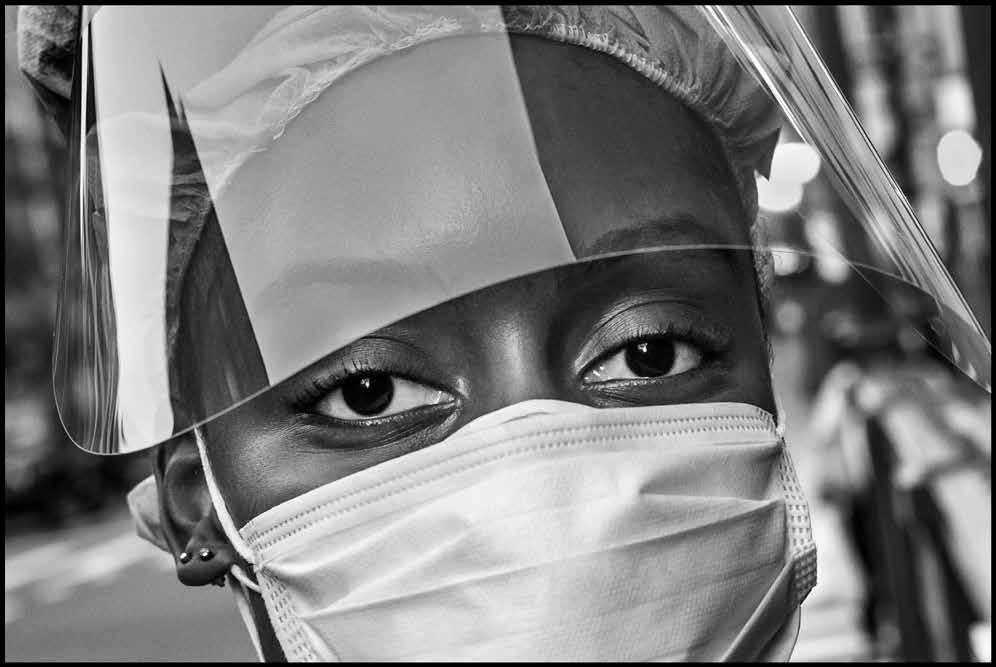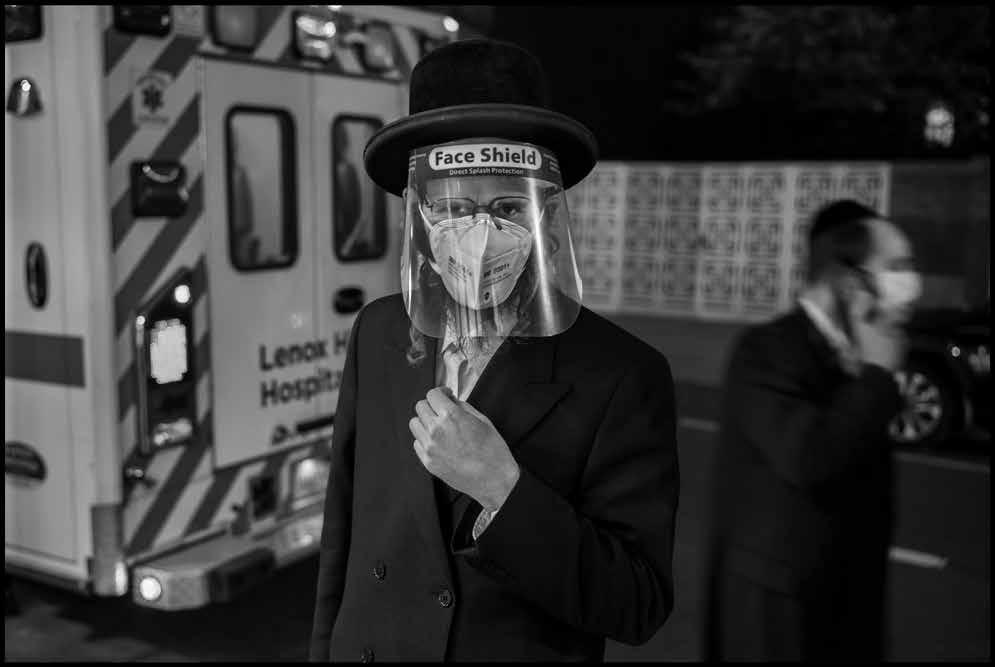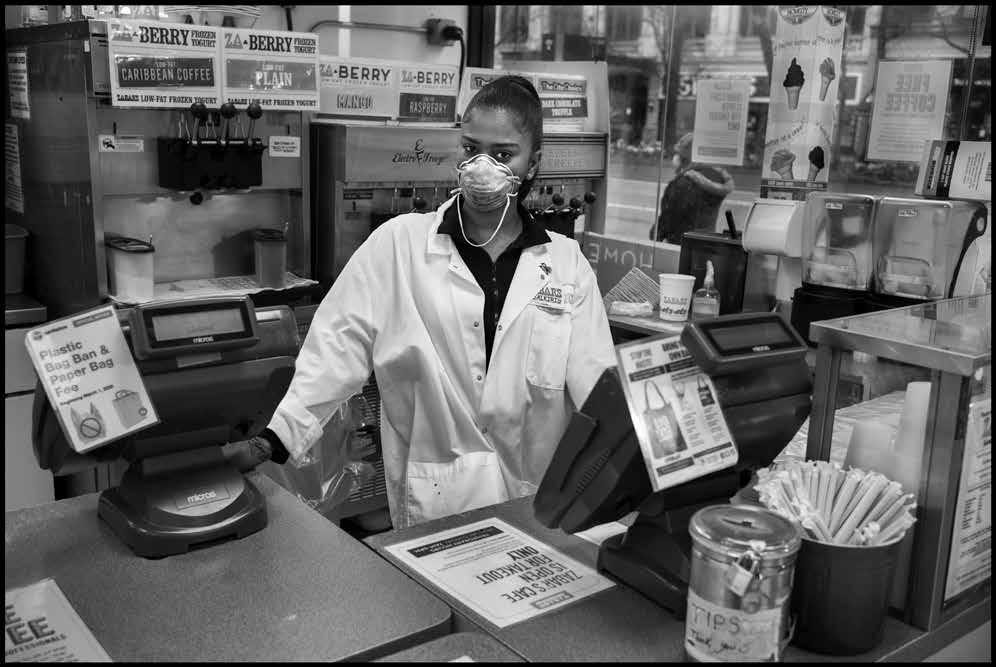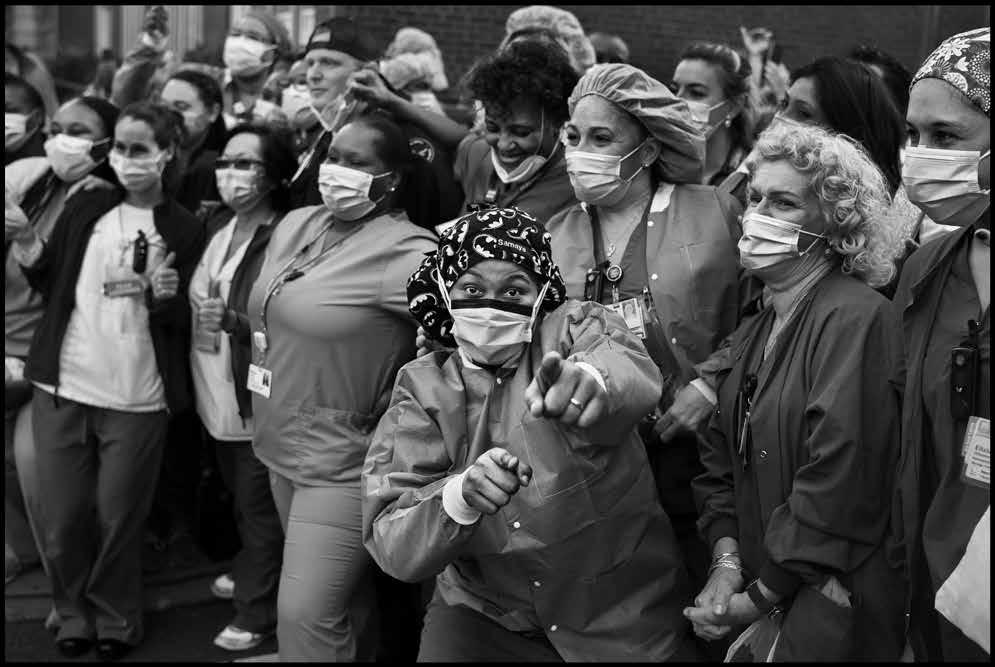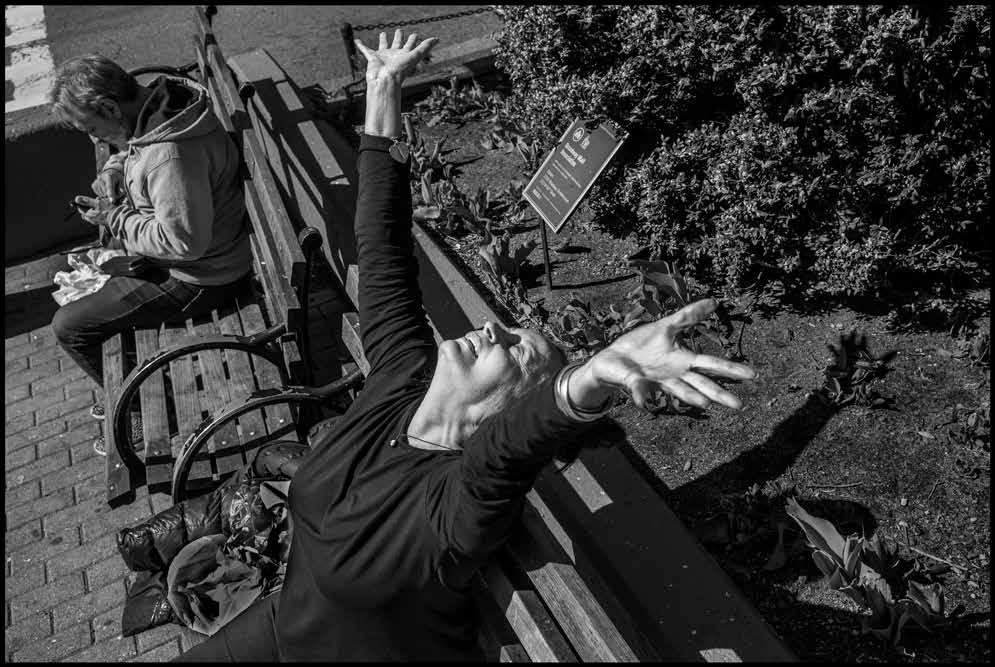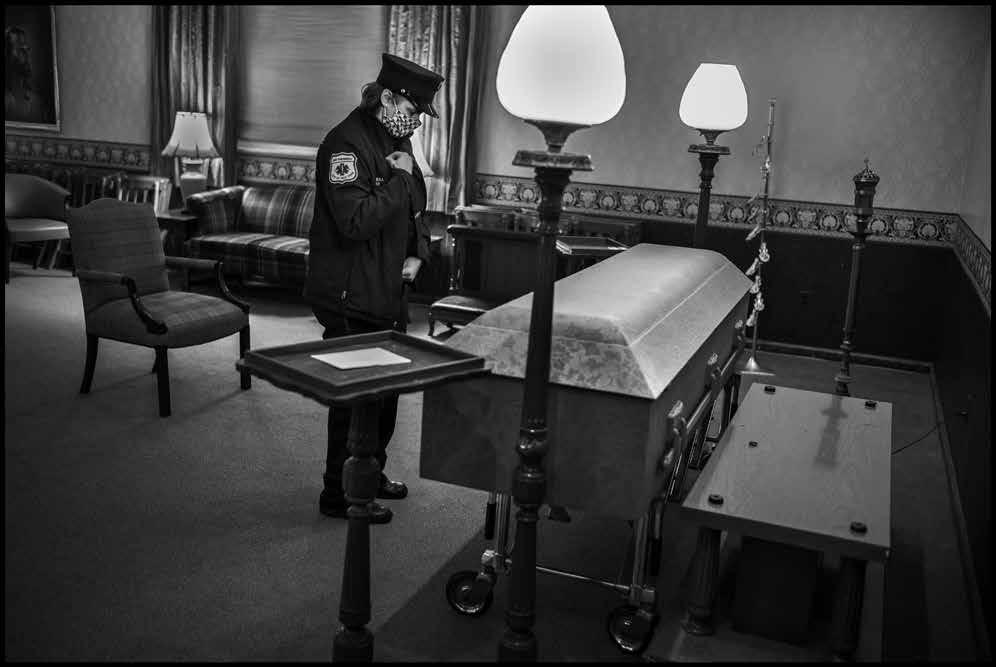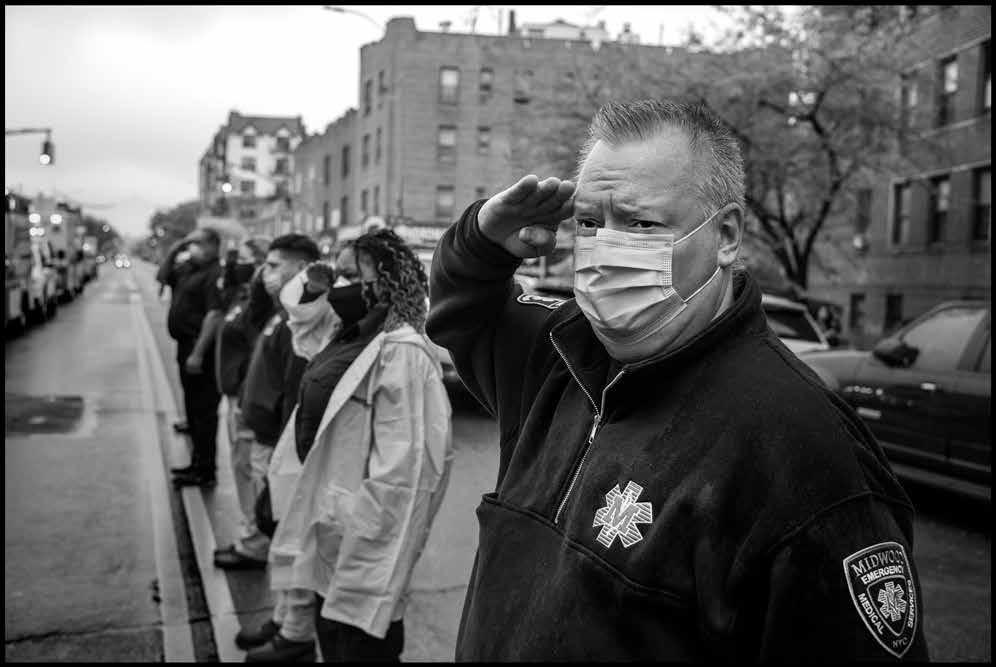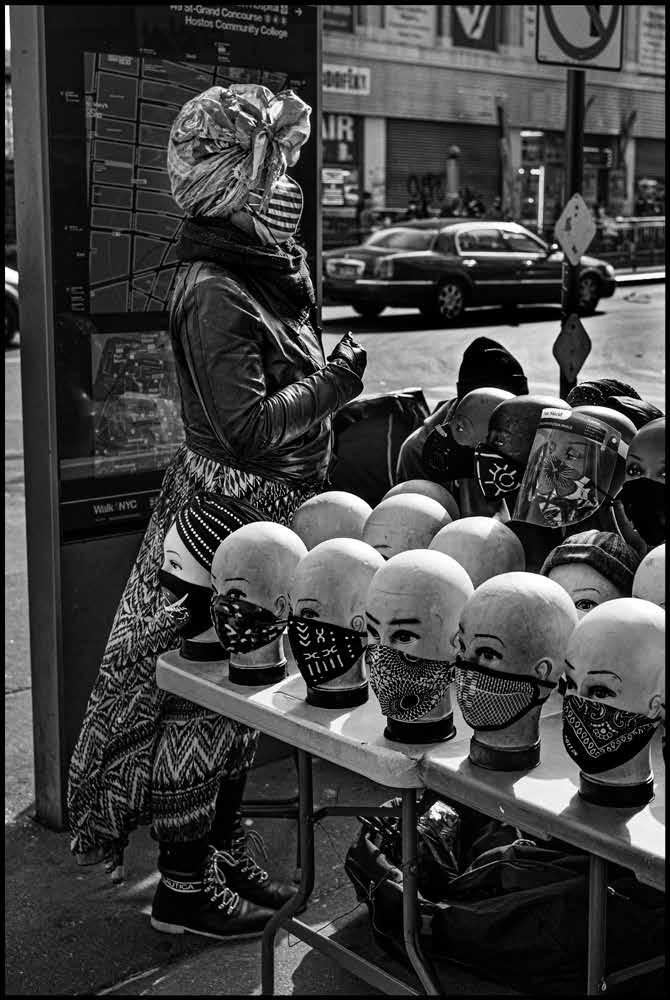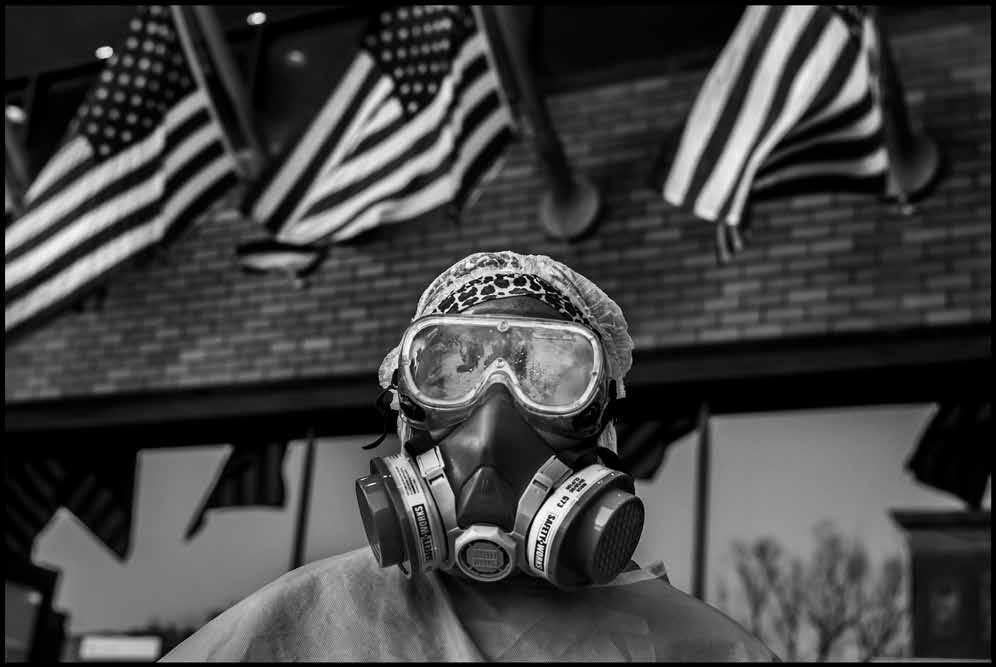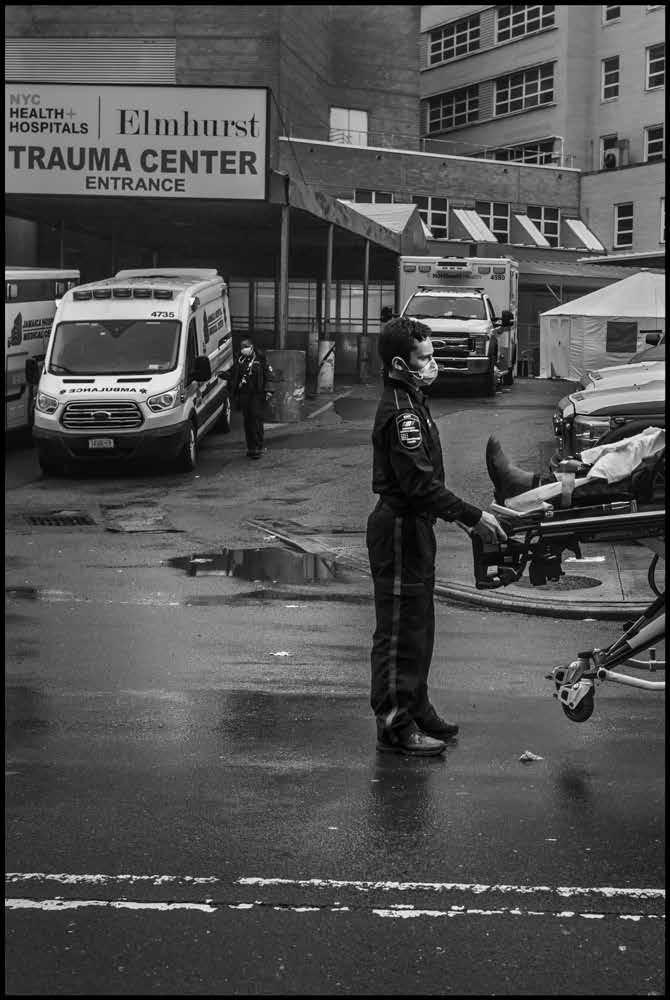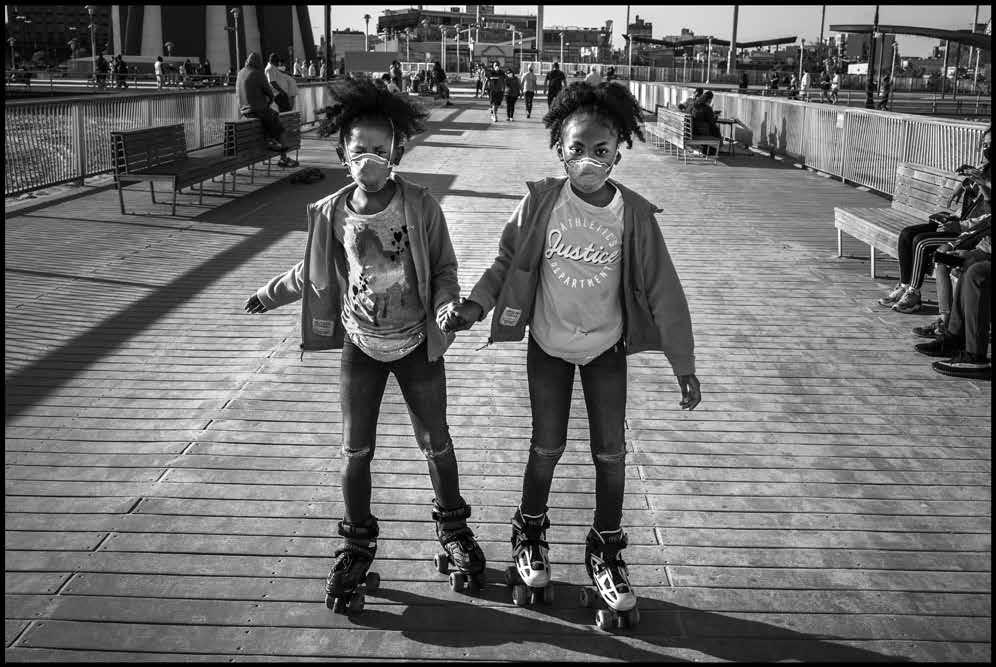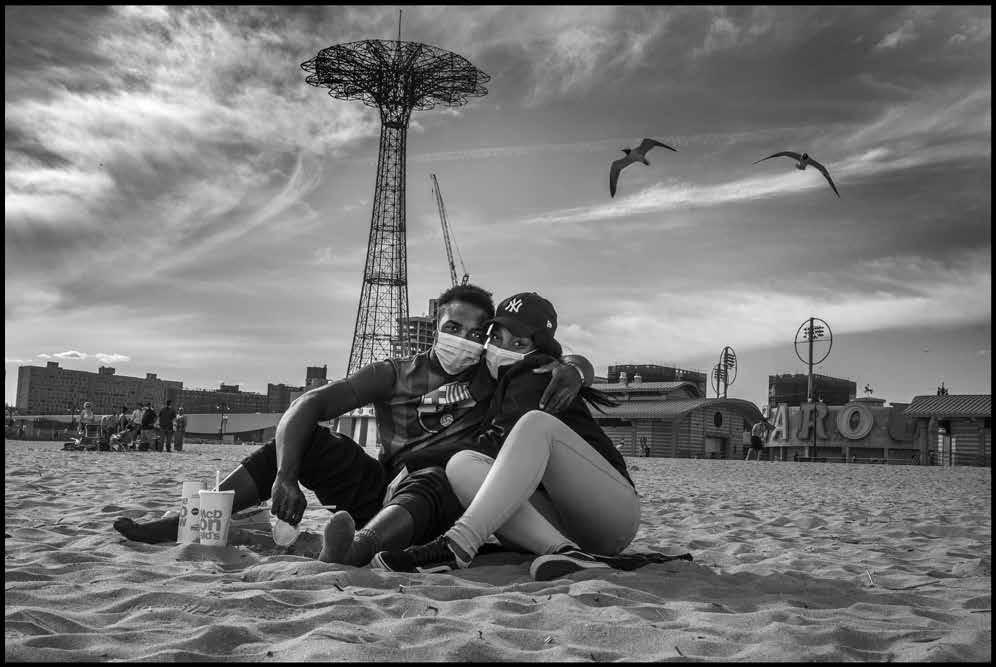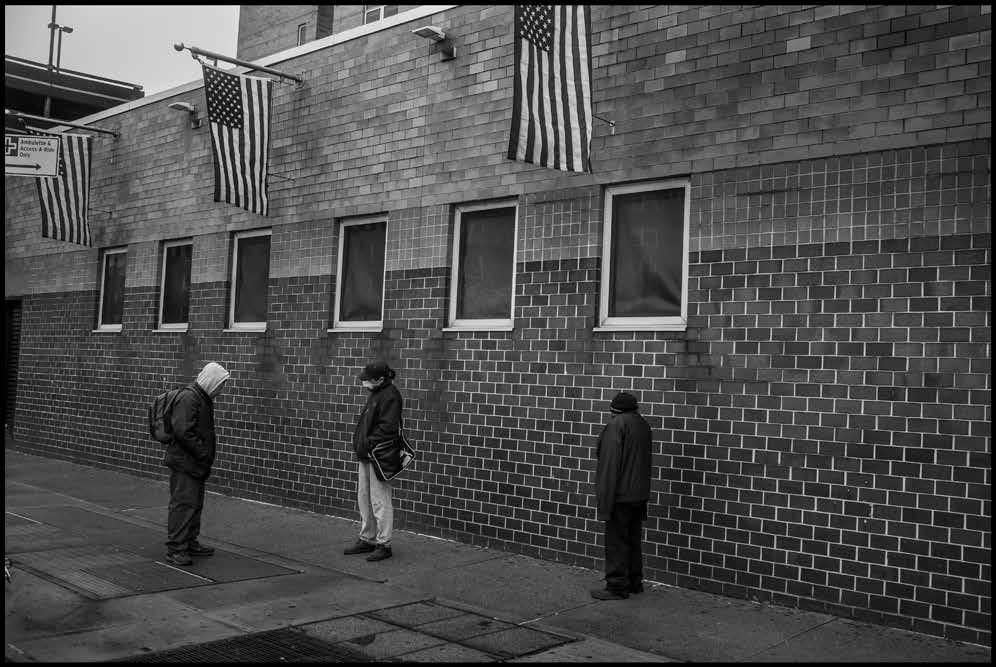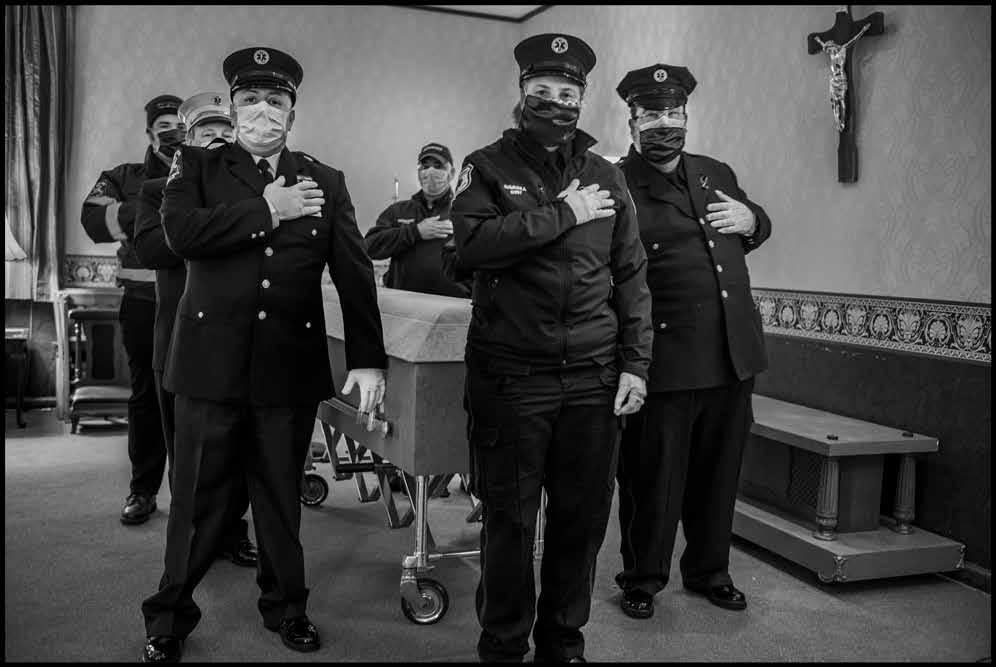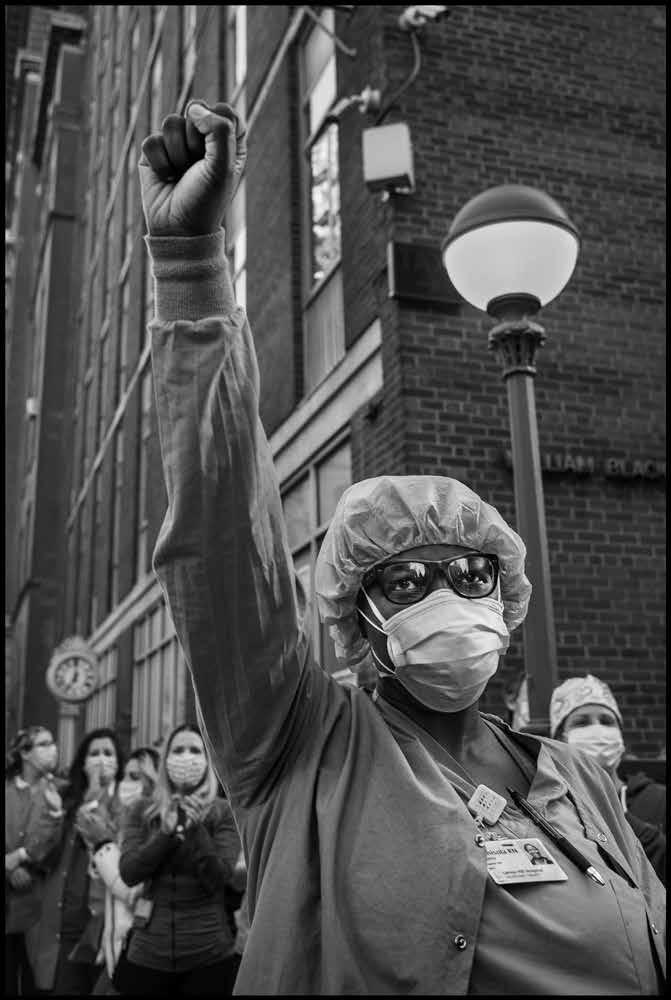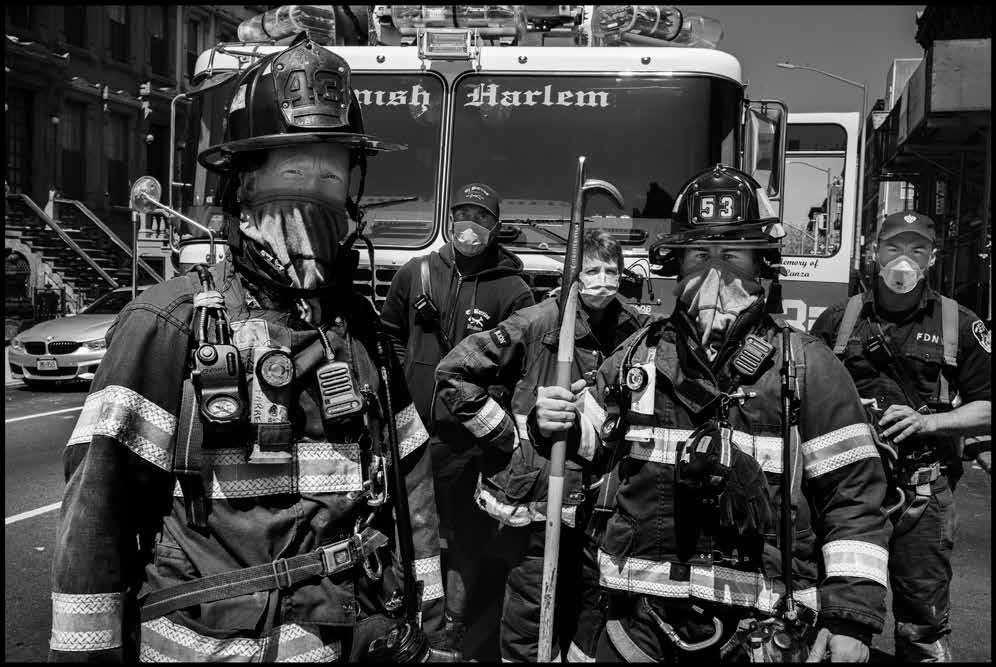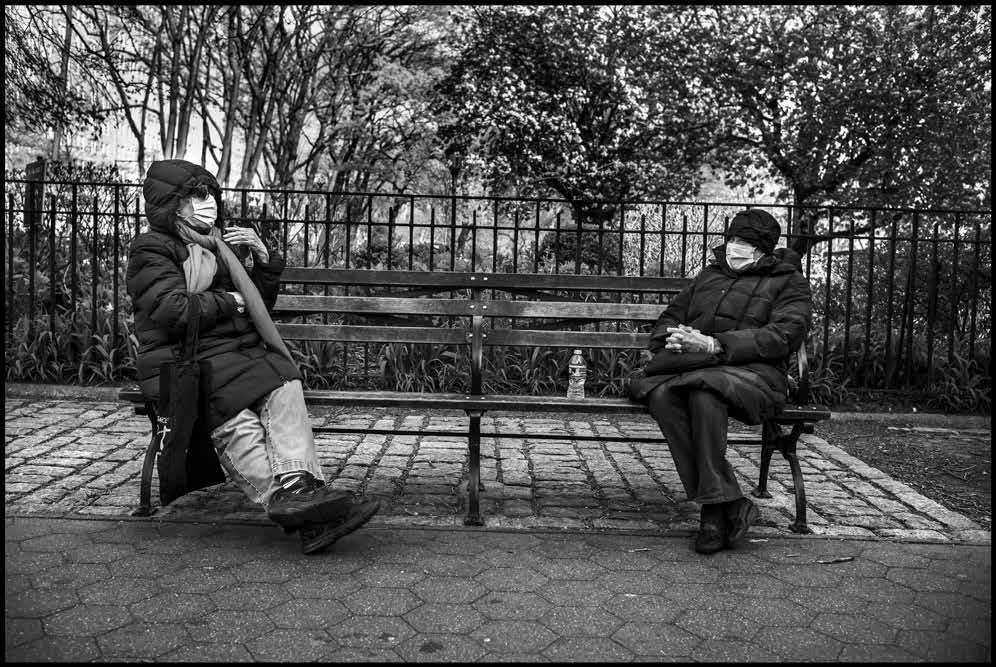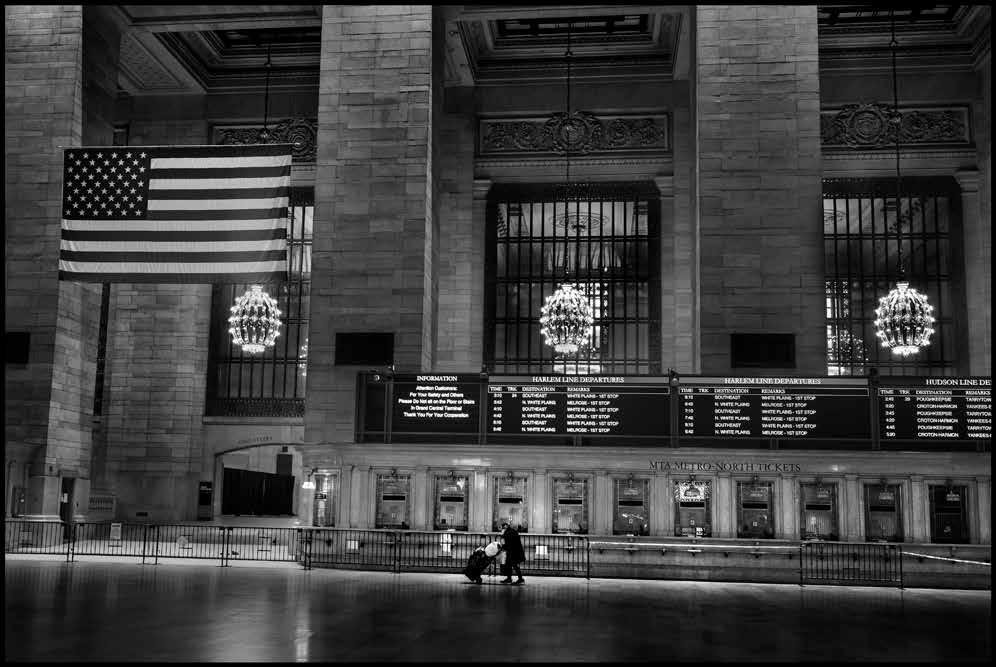Paris

65
Marie-Rouge, May 26. Paris diary 3.
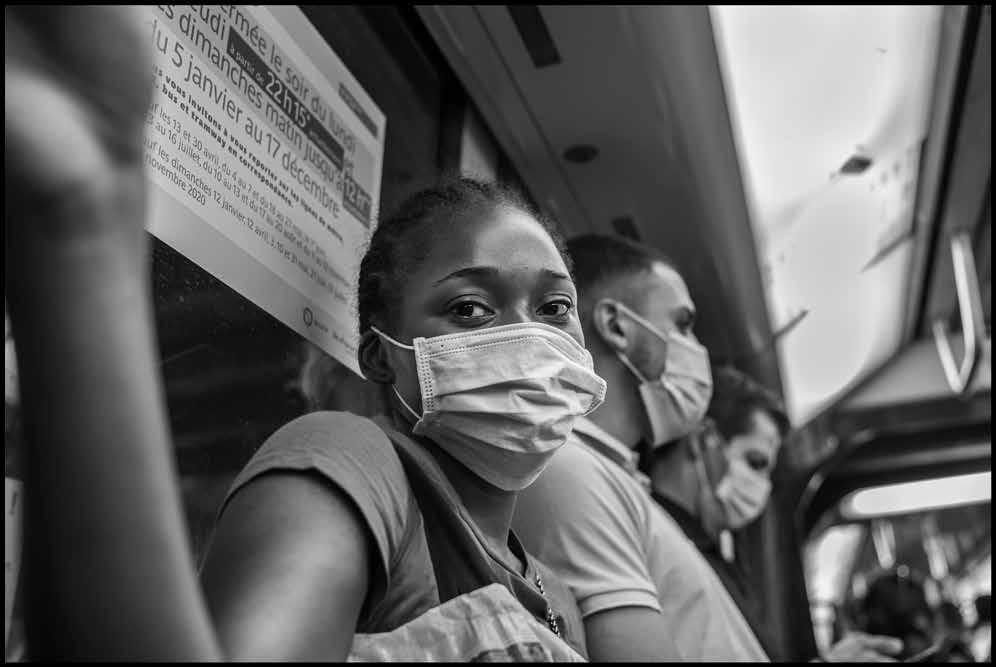

66 67
Inés, 18, Paris métro. June 25. Paris diary 43.
Abdelaziz, 64, at the grave of his mother, a victim of Covid-19. St. Denis, France. May 29. Paris diary 8.
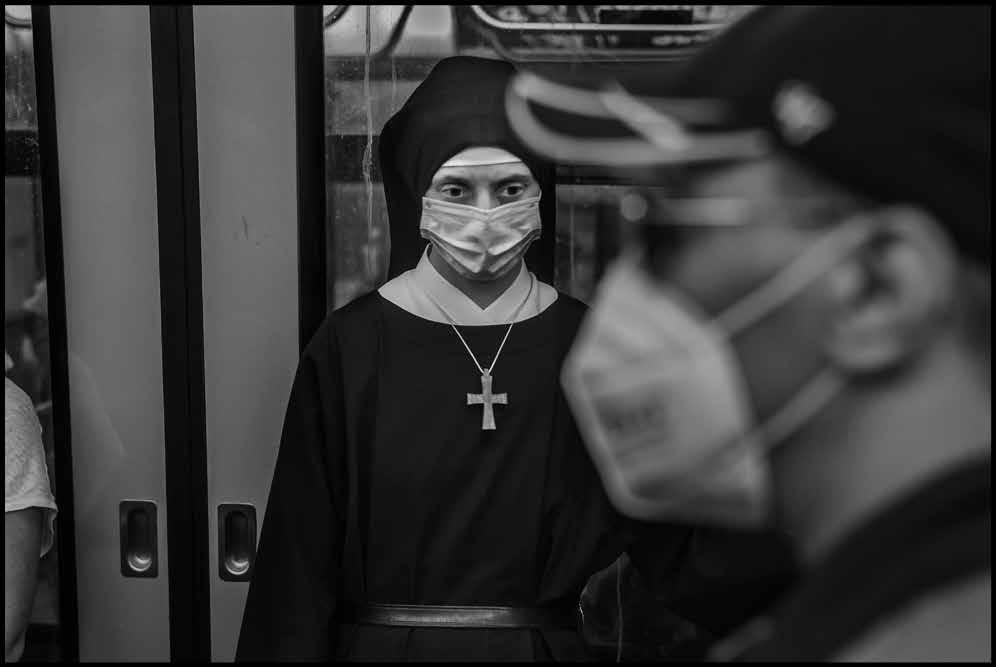
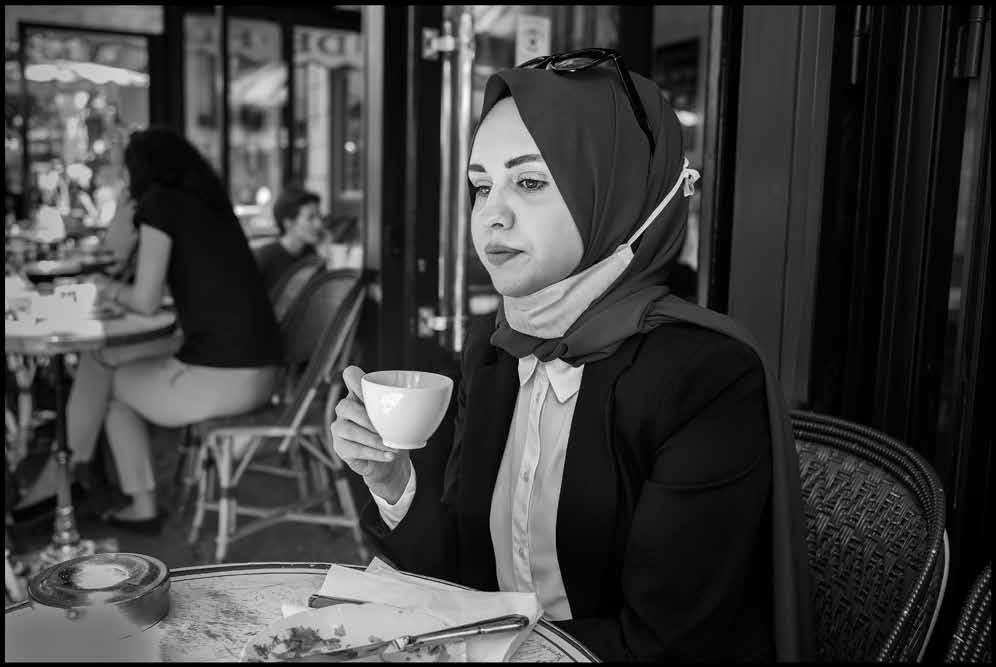
68 69
Paris métro. May 26. Paris diary 4.
Nur, Café de Flore. July 9. Paris diary 58.
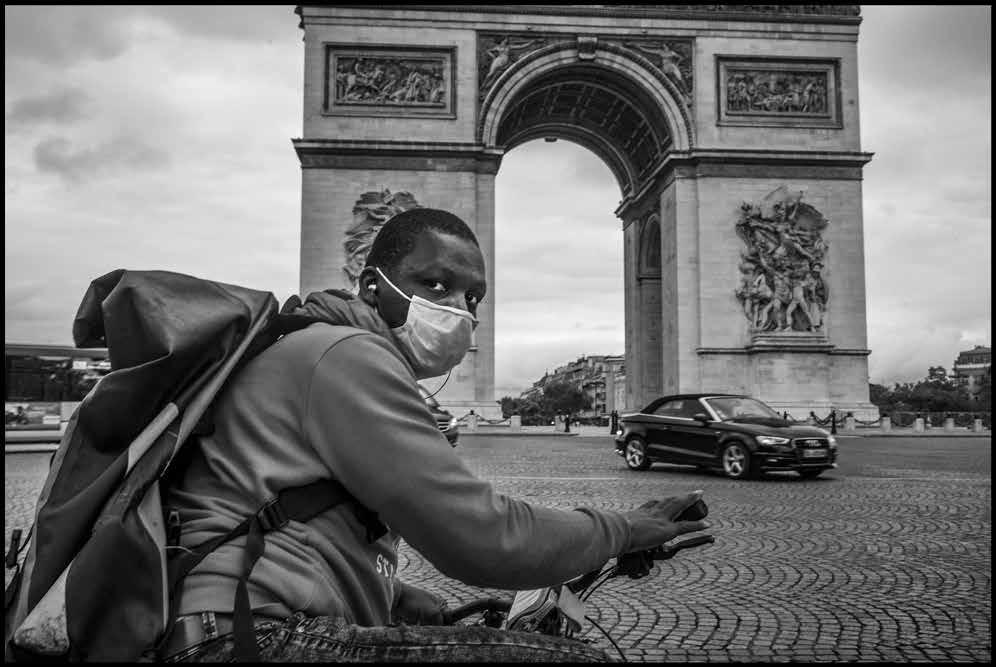
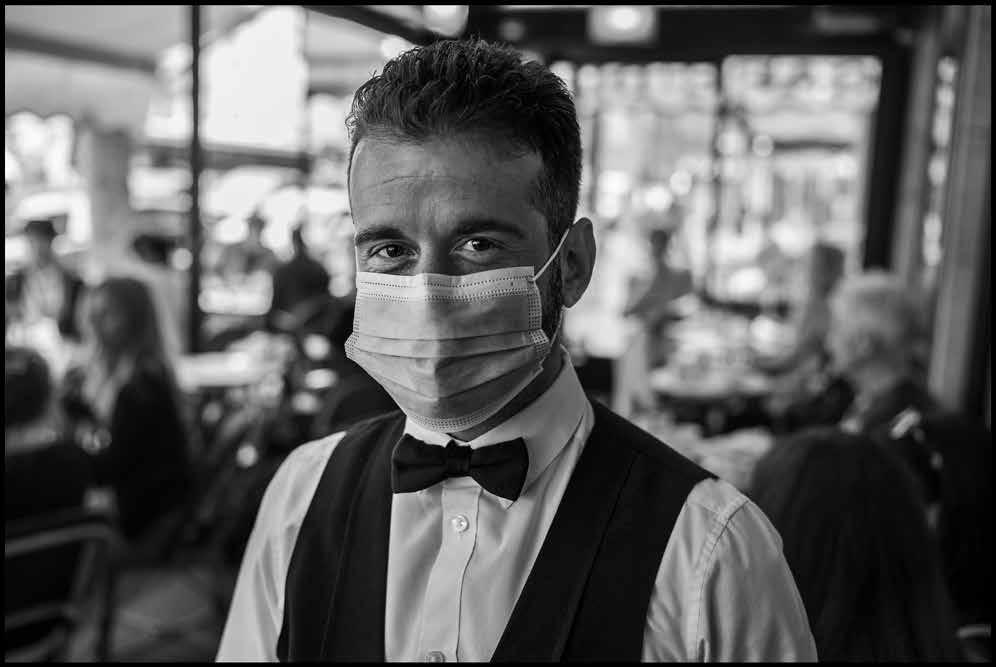
70 71
Touré, a delivery person, Arc de Triomphe. June 4. Paris diary 15.
Philippe, Café de Flore. June 28. Paris diary 46.


72 73
Paris métro. May 26. Paris diary 4.
André, Boulevard St. Germain, June 28. Paris diary 46.

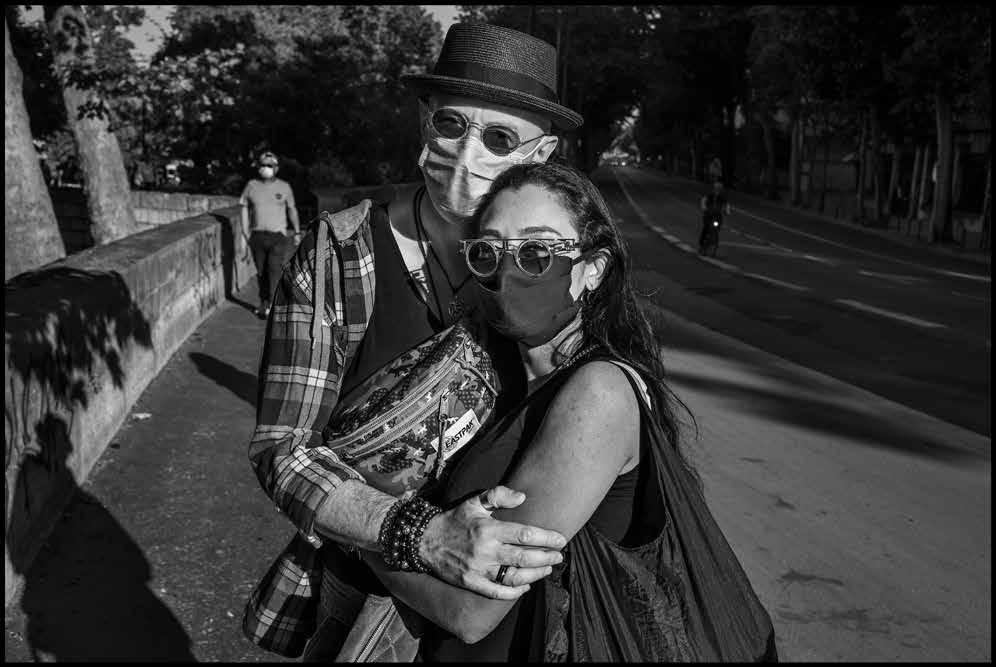
74 75
Eugenie and Jean, 90 and 92, married since 1952. June 28. Paris diary 46.
Sara and Eric. May 31. Paris diary 11.


76 77
Mamours, banks of the Seine. July 14.
Alice on a train to Paris. July 11. Paris diary 59.
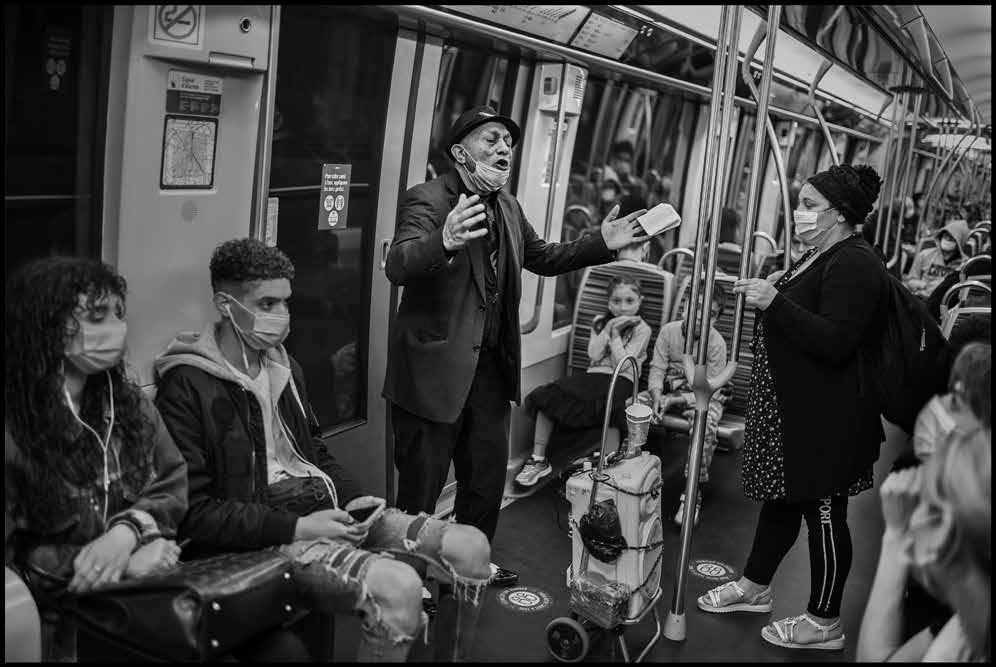

78 79
Ditl, from Moldova, sings in the métro with his family. July 5. Paris diary 53.
Tango. Banks of the Seine. May 31. Paris diary 11.
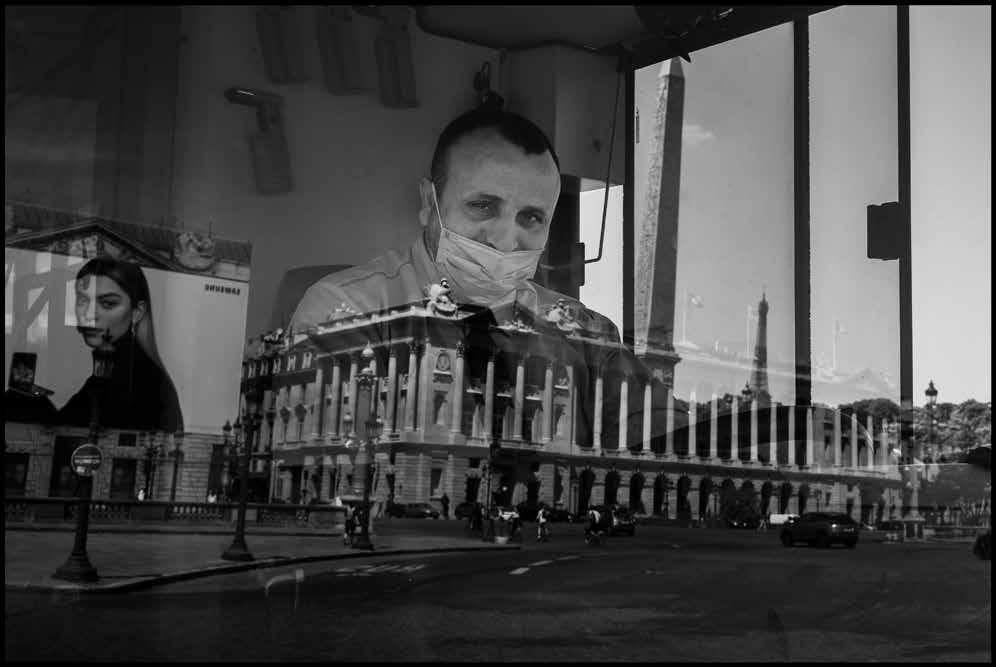
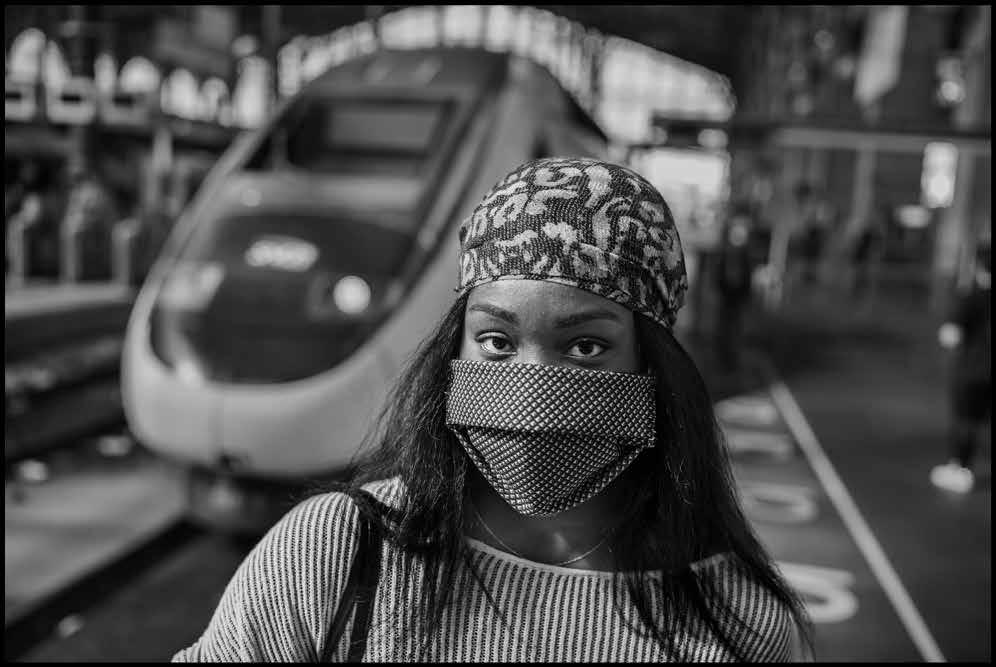
80 81
Mustafa, bus driver, Place de la Concorde. May 26. Paris diary 4.
La Gare du Nord. June 29. Paris diary 47.
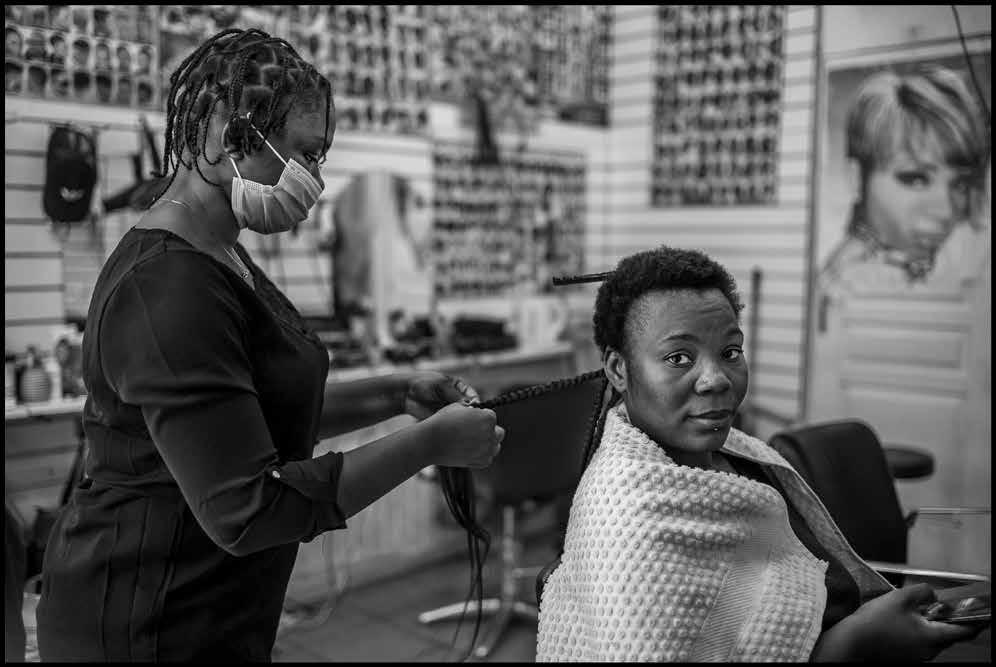

82 83
Josephine and Ange, rue Poulet, near the Chateau Rouge métro. June 29. Paris diary 47.
Odette, 94, with her daughter Chantal. June 28. Paris diary 46.

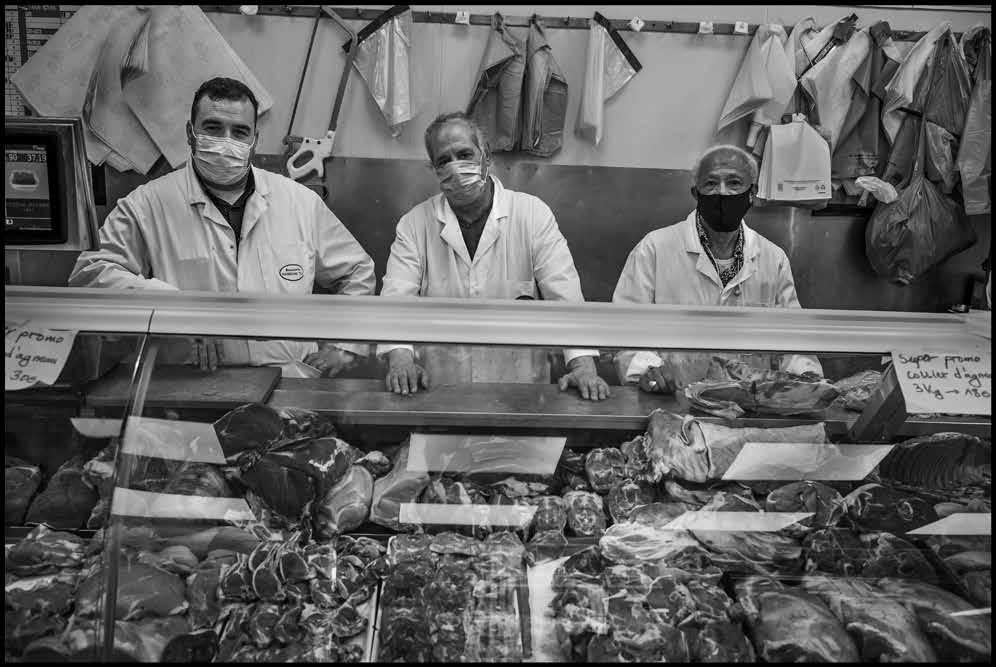
84 85
Safia, on the first day the Louvre reopened. July 6. Paris diary 55.
Butchers Ahmed, Djilali, and Said, Boulevard de la Chapelle. June 29, 2020. Paris diary 47.

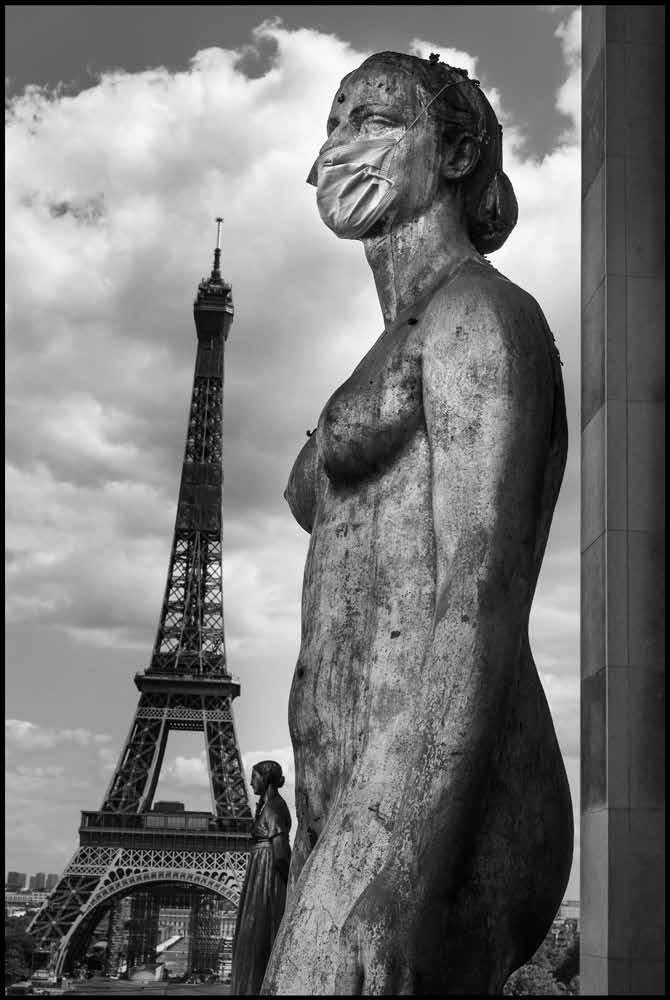
86 87
above: Maria, 25, and Alex, 30, at the Louvre the first day it reopened. July 6. Paris diary 56.
opposite: Esplanade du Trocadéro. May 25. Paris diary 2.
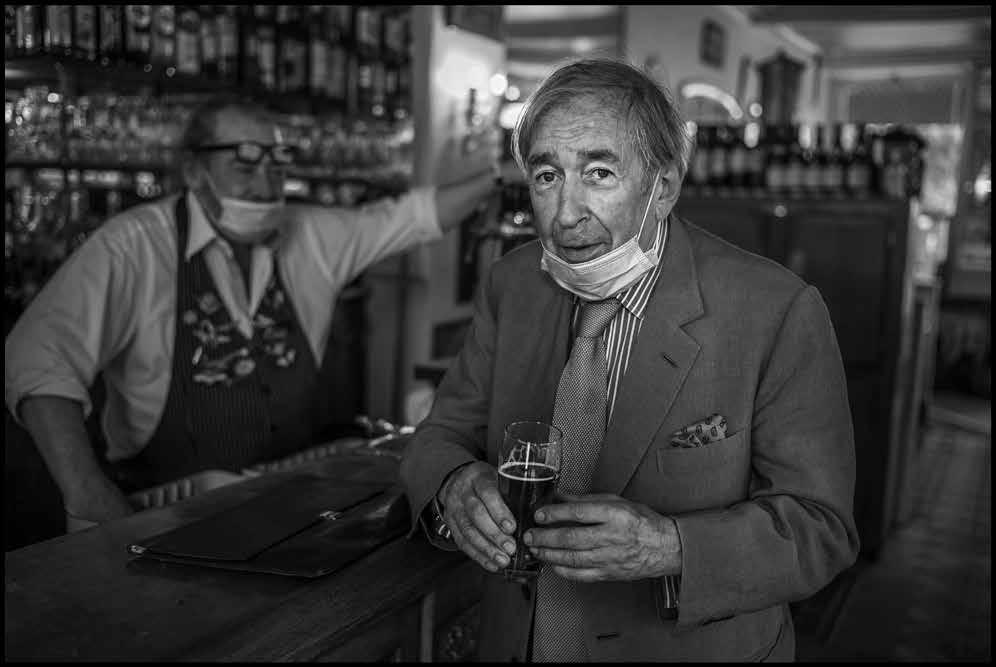
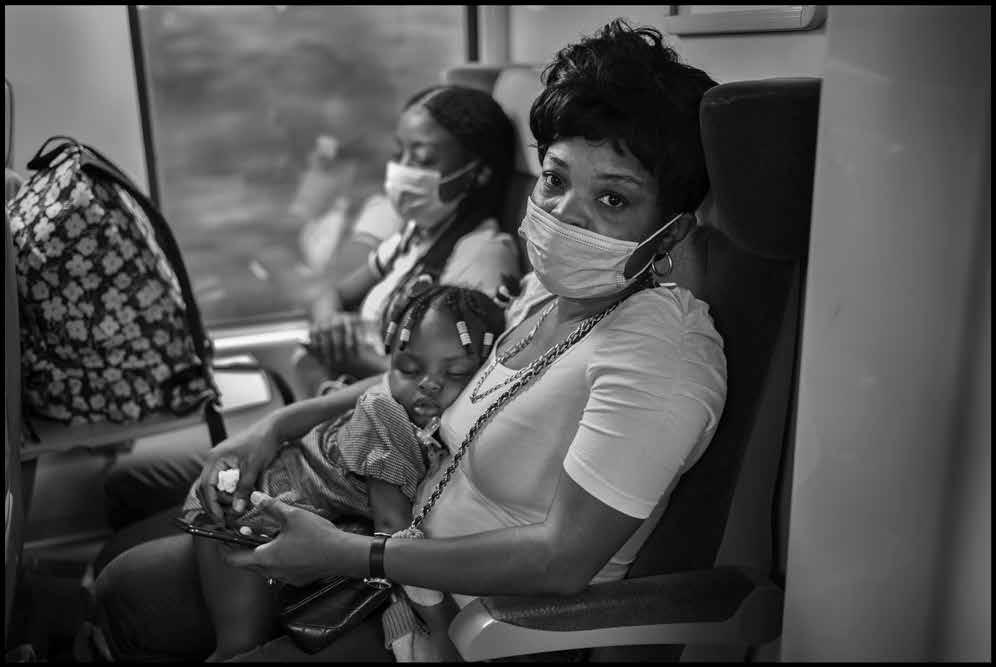
88 89
Monsieur Henri. July 3. Paris diary 53.
Childa and her daughter Victoria on a train to Paris. July 11. Paris diary 59.


90 91
Laura and Louis, L’Hotel de Ville. June 20. Paris diary 36.
Patricia, 70. July 4. Paris diary 53.


92 93
above: Dannick and César, Le Marais. May 27. Paris diary 6. opposite: Dancing Kizomba along the banks of the Seine. June 21. Paris diary 37 and 67.
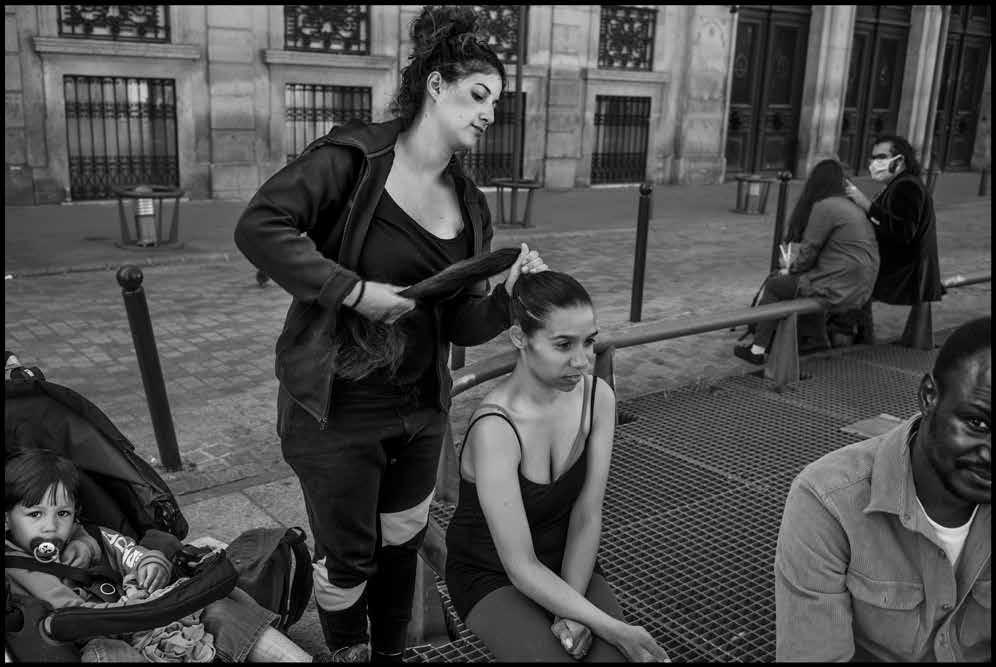
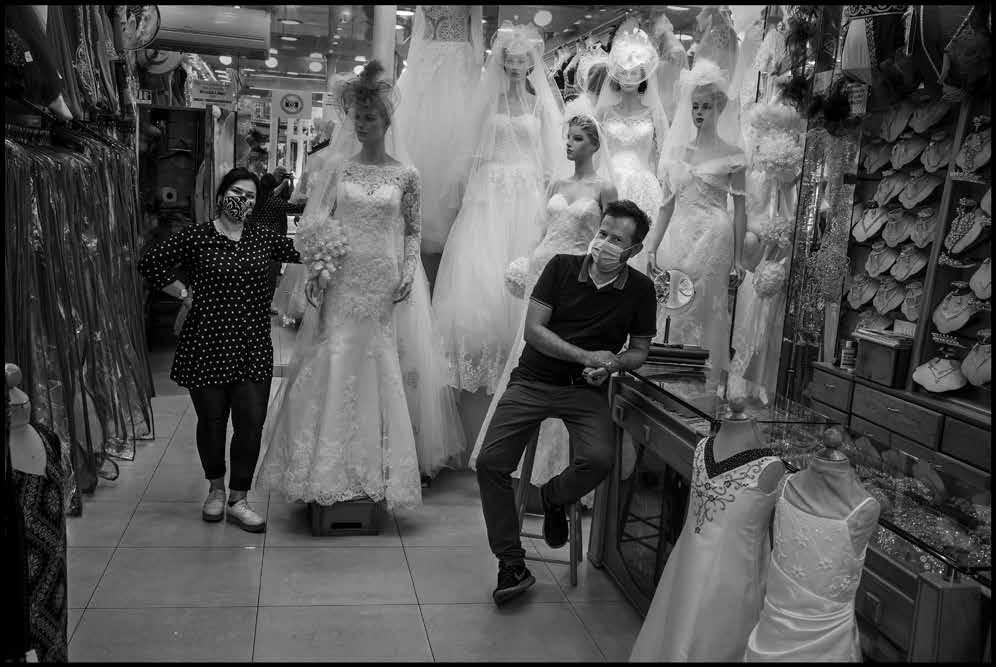
94 95
Sarah has her hair done for the first time in three months by a friend. Gare du Nord. May 28. Paris diary 7.
Rue Marcadet, 18th Arrondissement. June 29. Paris diary 47.


96 97
Omar plays the Guembri, banks of the Seine. July 25. Paris diary 66.
Rue St. Croix de la Bretonnerie. July 21. Paris diary 65.
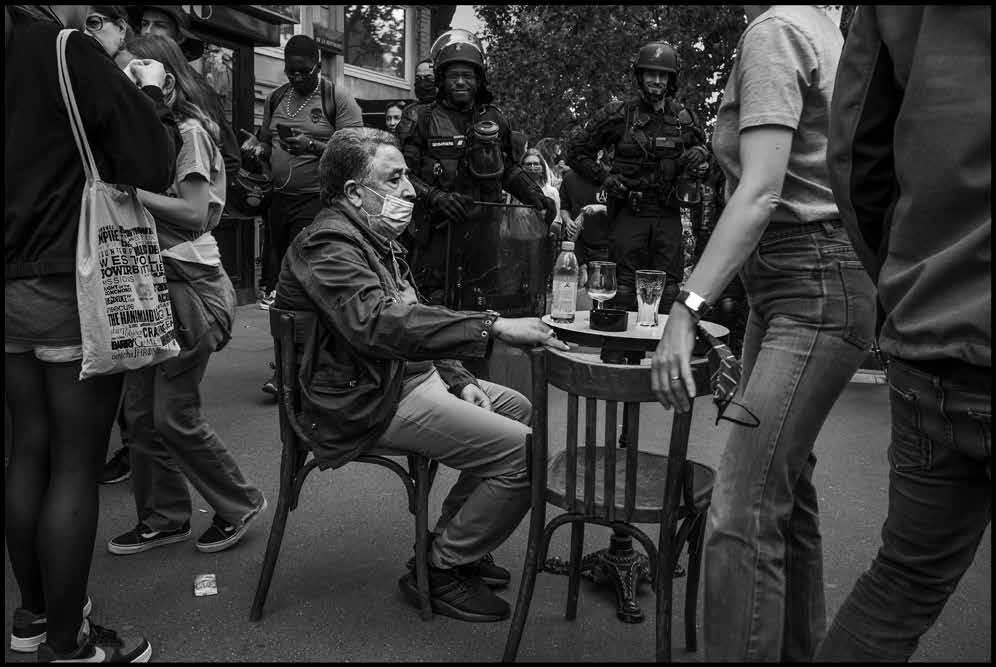

98 99
Demonstration against racism and police brutality, Place de la République. June 13. Paris diary 27.
Demonstration against racism and police brutality, Place de la Concorde. June 6. Paris diary 16.
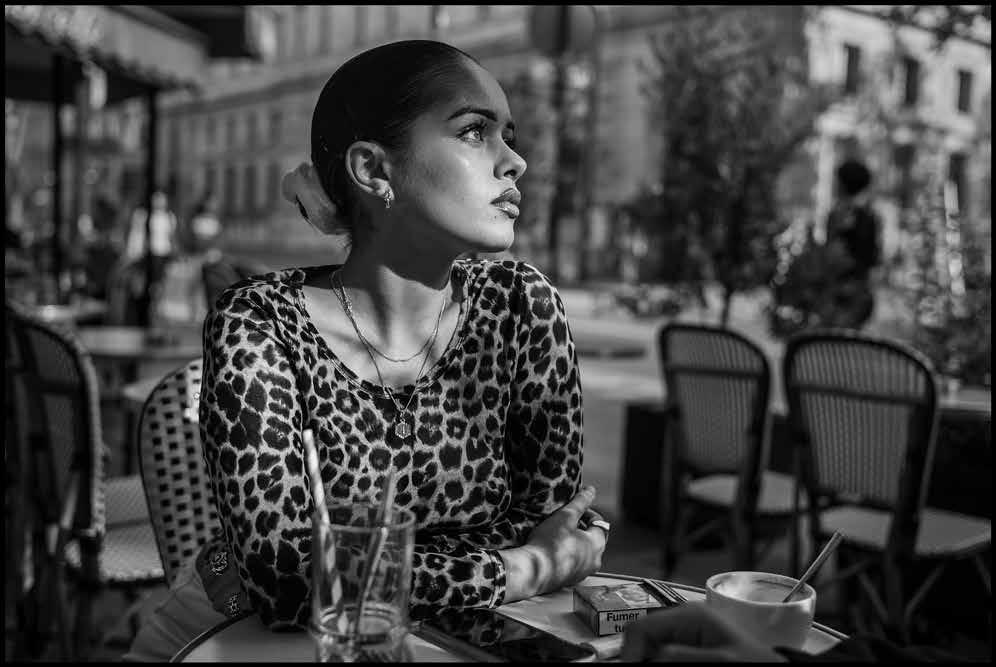
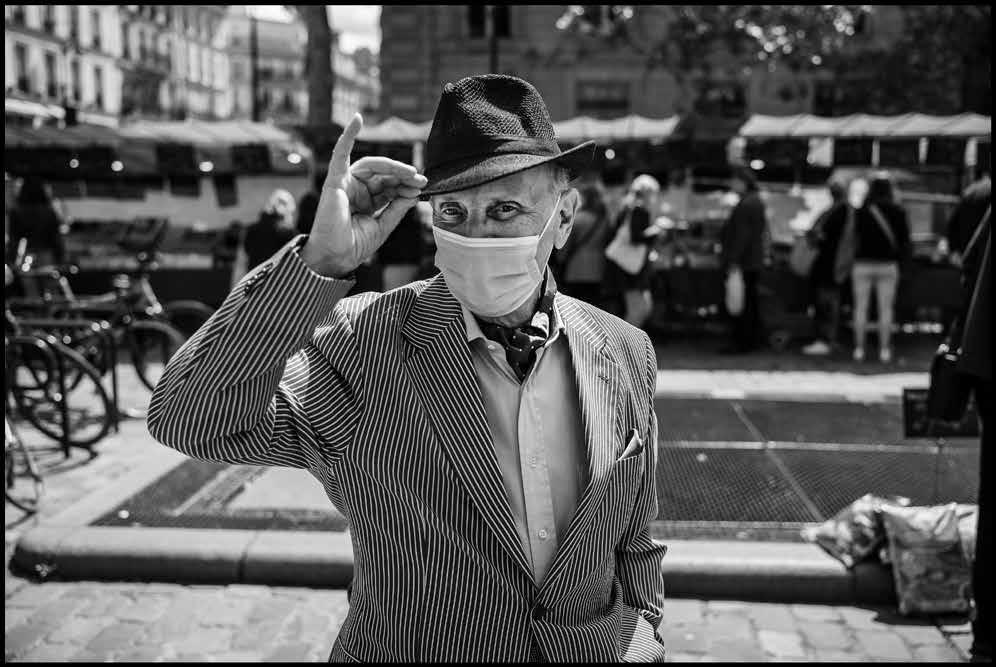
100 101
Cléopatre, café at Hotel de Ville. June 16. Paris diary 32.
Gilbert. June 6. Paris diary 29.
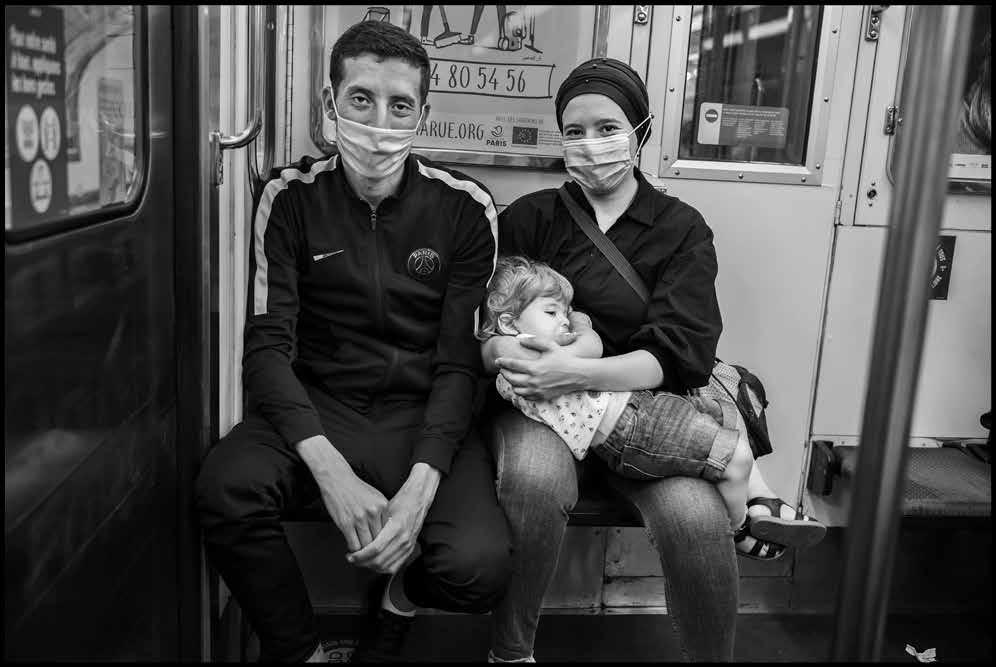

102 103
Paris métro. June 29. Paris diary 47.
Kid Ally, on a train returning to Paris, July 11. Paris diary 59.
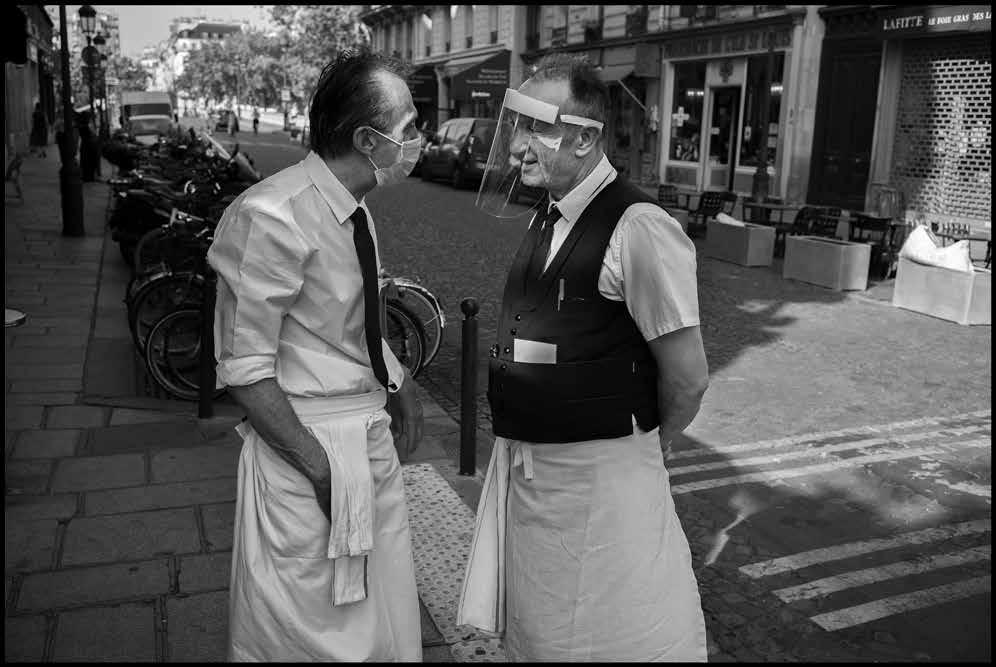

104 105
Arnaud and Karim, waiters at La Brasserie de l’Isle Saint-Louis. June 3. Paris diary 14.
Monika, Café Les Deux Magots. June 25. Paris diary 41.


106 107
Le Louvre the first day it reopened after “confinement.” July 6. Paris diary 55.
Florin, Gare du Nord. Paris, May 28. Paris diary 7.
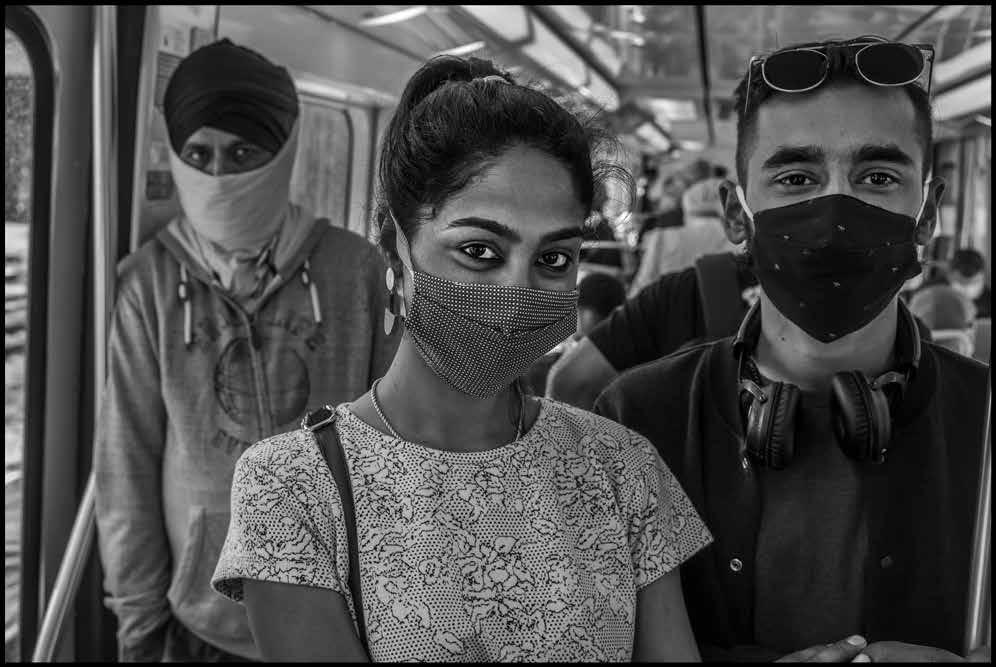

108 109
Priyadarshika and Bharit. May 28. Paris diary 7.
Anita, 22, on the first day the Louvre reopened after “confinement.” July 6. Paris diary 55.


110 111
above: Hayat and Tidia, mother and daughter, mourn the death of a husband and father, Arezki Ammi, a victim of Covid-19, St. Denis. May 29. Paris diary 8.
opposite: Black Lives Matter march against racism and police brutality, Place de la Concorde. June 6. Paris diary 16.
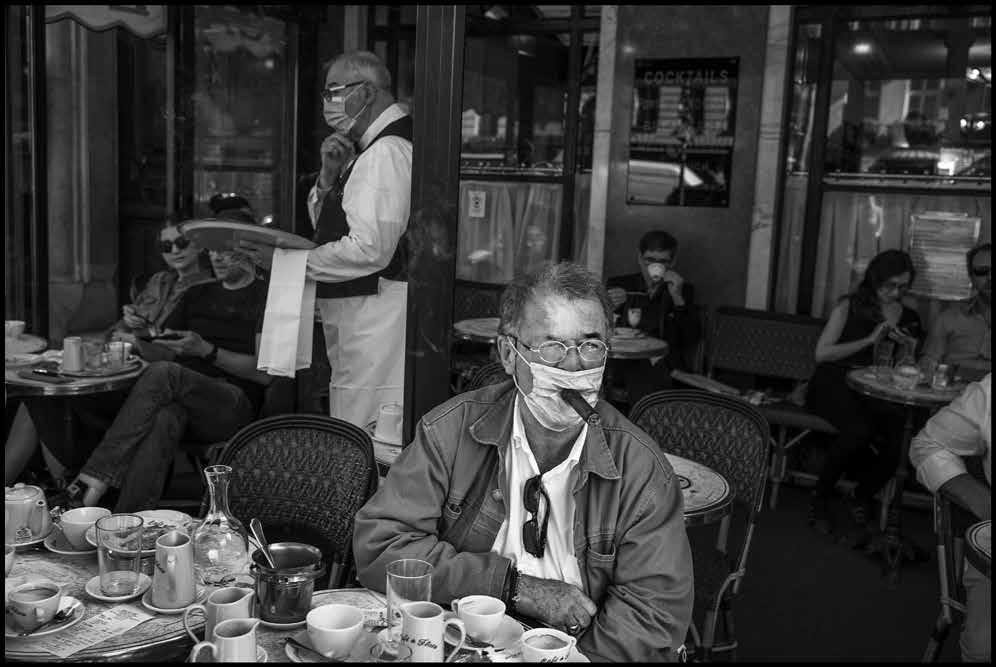
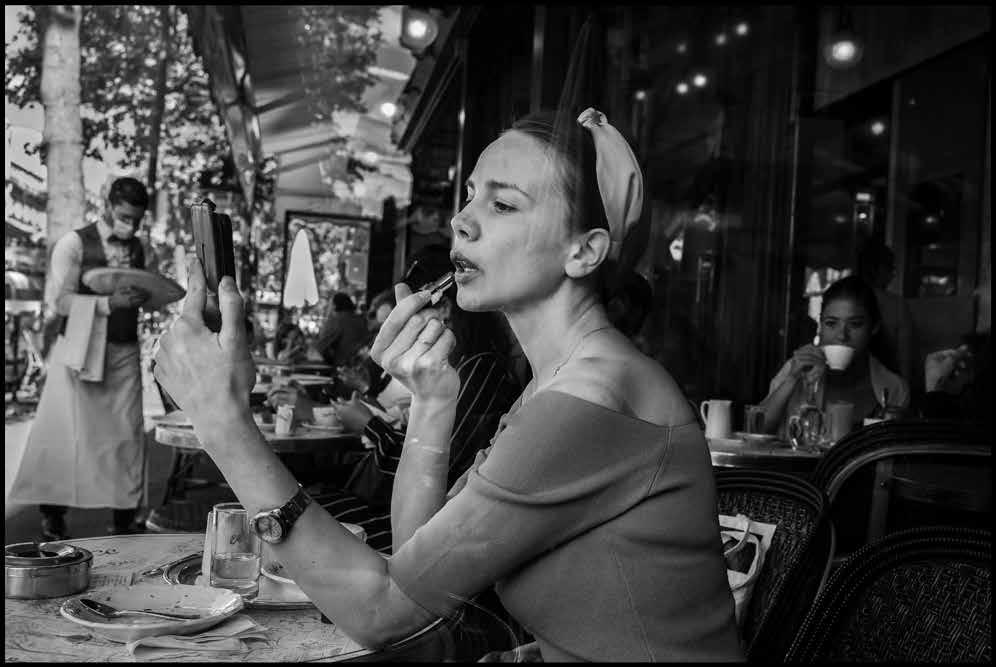
112 113
Pascal, photographer, Café de Flore. June 2. Paris diary 13.
Vassa, Café de Flore. July 8. Paris diary 57.


114 115
Banks of the Seine, June 21. Paris diary 37.
Rue du Pont Louis-Philippe. June 23. Paris diary 40.
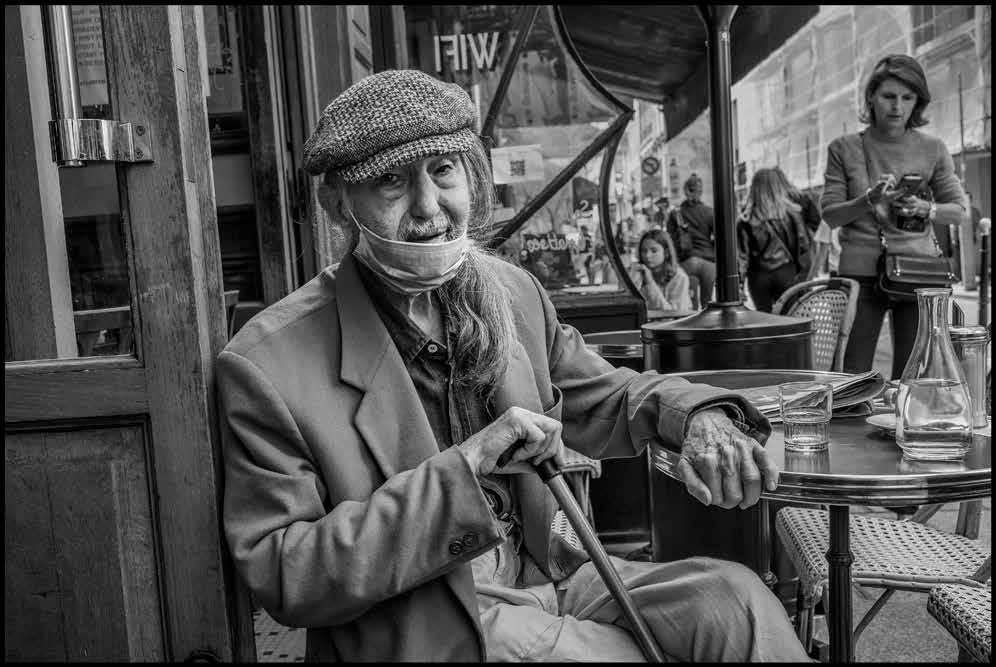

116 117
Jean, 92, Café L’Etoile Manquante, rue Vielle du Temple. July 2.
Roger. June 11. Paris diary 24.


above: Pont Louis-Philippe. June 22. Paris diary 39.
opposite: Café Les Deux Magots. June 8. Paris diary 21.
118 119
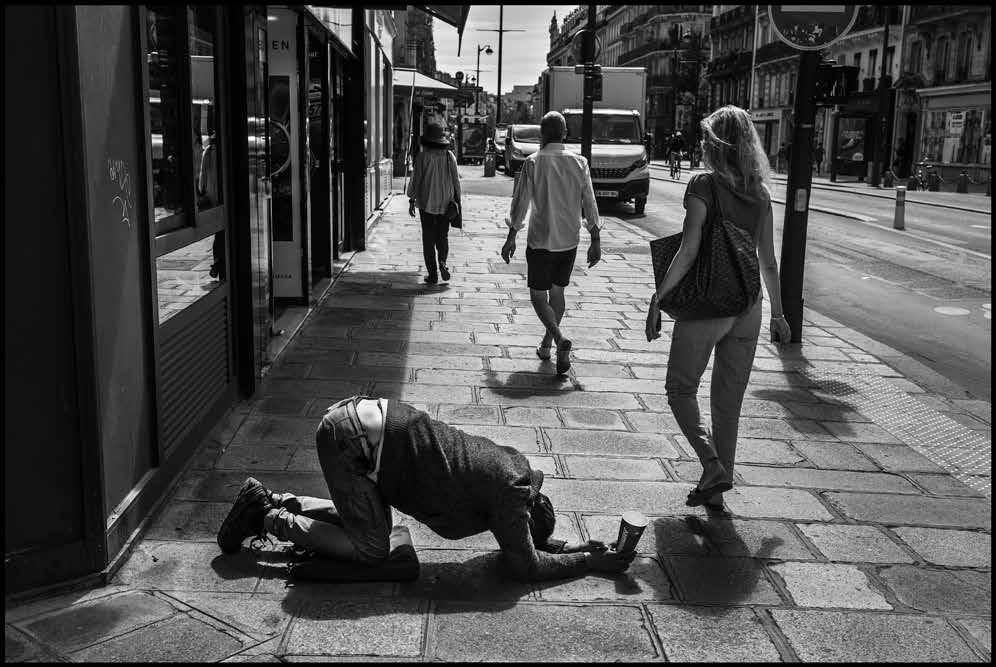

120 121
Rue de Rivoli. July 8. Paris diary 64.
Melania, Champs de Mars. June 26. Paris diary 45.
A New York Visual Diary
March 20, 2020, diary 1 (see page 11)
I woke up today and decided that even with the risks involved, I needed to go out and help be the eyes for a city that is in lockdown. I’ve been to many war zones in the world over a long time. On 9/11 I spent the late afternoon and night in the rubble of ground zero. We have entered a new form of war zone— more mysterious, unknown—it may last longer than some, and it will strike in the middle of where most of us call home.
I walked several hours through Manhattan and returned on the subway. Often there was no one around except more homeless people than I’ve ever seen—this is likely more noticeable exactly because often there is no one else around. The subway had the feeling of being a dark, risky tomb of necessity. I confess to being a bit shaken upon my return home from this day. I share here much of what I saw and felt. I hope you will share it with others. I’m not ashamed to say that I shed a few tears this afternoon. There are moments when duty calls, and it certainly felt that way for me this morning. I send love to all.
March 23, 2020, diary 2 (see pages 27 and 32)
It rained coronavirus cats and dogs today in New York City—both figuratively and literally. New York is ground zero of the pandemic in the U.S. Late afternoon, I went out and walked north on the Upper West Side. Within a few hours, I came across so much of the reality of this moment—and of the melting pot of New York—and the courageous people who perform essential jobs to keep life going for so many. I encountered a gentleman who was out for groceries, and as I photographed him, he looked up at the sky and declared, “It is raining, but it is a beautiful day!” I came across Natalia, from Odessa in the Ukraine, standing alone on the sidewalk at 83rd Street. A postal worker, delivering mail without a mask, Jason, told me with a smile, “I am not scared.” A bus driver opened his door and welcomed a photograph with a smile before taking off at a light. I walked past a laundromat where a woman working with a mask went about her chores in front of a washing machine, while Diallo, a young woman from Guinée, sat waiting for her wash to finish. A young man with a baseball hat prepared to take out the trash for a building on the Upper West Side. A doorman stood behind revolving doors with his mask on, proudly wearing his doorman’s uniform. Finally, as I arrived at 96th Street, I took a cab and asked Mohammed, a driver from Bangladesh, how he felt, and he told me, “I am scared to death.” I was very careful to keep a distance from all I photographed and felt somewhat comforted by the heavy rain. My life must go on, and I will be careful. I return to my home alone, and I am very careful with gloves and mask and immediately put the clothes in the laundry and jump in the shower, and I wash my hands often. But both my heart, and these times, need to carefully bear witness to the humanity of this moment— and, as carefully as possible, to indelibly convey the courage and hearts of so
many in the middle of a war zone, in the heart of the most energetic city in the world that fights back as it can.
March 24, 2020, diary 3 (see page 15)
New York is now the epicenter of the coronavirus crisis in the world. The hearts of this city continue to beat, and there are so many moving stories of courage and life going on and how people are coping during this lockdown. While wearing mask and gloves and keeping always a careful 6-foot distance from all with whom I come in contact, I think it is essential to share with the world the stories of this moment through photojournalism. I also return each day to where I live, alone. Yesterday I went out and again walked north. I came across Clifford standing at a bus stop hoping to receive some money to help him eat at this time. At the Happy Warrior Playground on the Upper West Side, 6-year-old Taji was shooting baskets—at a safe distance from everyone else—with his mother, Latoine. She told me Taji really misses school and Taji told me he was going to grow up to be the next Kobe Bryant. He seemed already like a champion to me. Loren was walking with her dog, Molly, and Joe looked through the window of a famous deli, Barney Greengrass—The Sturgeon King. Jacob, a nurse at Sloan Kettering, jumped rope at a safe distance. Rosario from Guatemala waited for a bus, and Rummy returned home, basketball in hand, from shooting baskets alone in a park. At the 125th Street Harlem train station, a mainstay station for many people working in the city who commute in each day, I came across several of New York’s heroes of this moment: Haymar, 29, a medical student from Myanmar who works in a Harlem medical clinic; C., a doctor, on his way home; and Linda, an oncology nurse who works at Mount Sinai. I will never forget the night of 9/11, when I was in the rubble of ground zero and a nurse walked up to me at 3 am and offered me her mask. I couldn’t accept it but will never forget her selfless kindness and gesture. Yesterday, after speaking to Linda, the nurse, for a while about how this moment is affecting her, she reached into her bag and offered me an extra mask for future days.
All over the city, I saw people very carefully keeping a social distance from each other, and I did too. In the midst of this crisis, the heartbeat of this dynamic city beats much slower, but the hearts of so many that I see each day profoundly remind me how strong the heart of this city is.
March 26, 2020, diary 4 (see pages 14, 23, and 28)
Today was a day of meeting heroes and encountering ironies.
As I moved carefully around the city today, I encountered so many heroes—doctors, nurses, policemen, subway workers, home health aides, union representatives, cleaning women, and many others. There was a strong irony to this day. On a day when the United States and in particular New York now have the most confirmed cases of coronavirus, it was a gloriously beautiful early spring day. Weather and light bring back memories: I will always remember that September 11, 2001, was one of the most beautiful days ever, the sun shining bright in a gorgeous blue sky, on that tragic day that changed our world.
Today, as I crossed the Brooklyn Bridge, seeing a person with a mask jogging alone on the bridge, I got down low to photograph her, and just as she arrived in front of me she jumped in the air. I called out and asked her name and where she was from. She replied that her name was Yanan and said she was from Wuhan, China. On Wall Street, I met an investment banker, Arthur, who told me he had grown up homeless for a period, and so he is optimistic that things will get better—this is only temporary. As I turned the corner onto Wall Street, I saw a lone woman sitting on the sidewalk, begging for money for food. On a day when Congress was voting on the biggest economic stimulus package in U.S. history, I met MJ, a freelance fashion stylist, who asked me, “What will $1,200 do for a person like me living in New York who won’t have work for months?”
I wonder if many others are going through what I am feeling today. My emotions often are like a roller coaster. Most of the time, particularly when I am sharing the visual stories of so many who are true heroes in this historic moment, I am uplifted and their example gives me courage and hope. Then there are moments when so much of this new reality and its unknowability, how it is changing our world in known and unknown ways, challenges the spirit. But, when I finish my day walking and encounter Lesley, a 46-yearold subway worker, standing with a big, wide smile—and who with pride tells me that she has just come from disinfecting the 23rd Street subway stop as part of her job—I say to myself, if Lesley can be this strong and generous and courageous, I certainly owe it to her and everyone else to do the same. There is only one New York—a special, strong, amazing city of wonderful people.
March 27, 2020, diary 5 (see page 35)
Today I have been inside most of the day. When I went out for groceries at a local store, I came across Priscilla, worshiping the sun. She was careful to stay 6 feet from her neighbor, as I did from her while making this photograph. We spoke for a short while, and she said, “It is so sad to stay inside all day—I had to come out to get some sun.” How well we all understand her feelings—just what so many of us are feeling and thinking too.
March 27, 2020, diary 6 (see pages 17 and 33)
Today I saw a lone elderly woman sitting on a bench in the rain at a place only yards from where I lived for seven years at 133rd and Lenox in the center of Harlem. Mary, she told me, was her name, and when I asked how she was making it, she replied, “By the grace of God.” She looked about the same age as my mother, who recently passed at 94. As I photographed, two young men walked by and said, “Why don’t you give her your umbrella.” So I walked up to her and handed her the umbrella I had just bought an hour earlier. I turned to look up the street toward the two young men and saw that they had been watching me—they broke out into big smiles and gave me the thumbs-up. I wish it had been my idea first, but as I walked away, it occurred to me that in this moment, not only are we all together in this situation, but we can help each other become better people.
I walked this morning for hours, almost 80 street blocks. This morning, I woke up and saw a video of life in Venice—a place I’ve been to very often and love so much. This video of this unique city across the earth from where I am, but so close to my heart, reminded me so much of our common humanity
In New York, still the epicenter of this crisis in the United States, with the most cases of coronavirus in the world, every life is affected, and every person I encounter has a story that is part of our collective story. So many of the people I encounter are true heroes, people doing essential work, or people simply struggling to get by. Aldalkiris, 21, works the cash register at a local grocery store. Kevin is a garbage collector. Markus is homeless and sits hoping to receive some money to eat—when I asked him how he was doing, he told me, “It’s rough.” I asked him if he was scared and he told me, “No, I was scared when I went to ’Nam.” Joe, a doorman who works in a building on the Upper West Side, has to take a bus to Queens near Elmhurst Hospital, where, he told me, “There are so many dead they have to put them in a freezer truck.” I came across a young man and we talked for quite a while and he said to me, “You know, you are the first person that has spoken to me today.” Two elderly gentlemen were standing at social distance speaking to each other on Lenox Avenue near Harlem Hospital. I asked them how they were making it, and one of the men replied, “WelI, I woke up again today.” I asked again, really, how he was making it? And he offered, “We’re never really making it—every time we come close, they come up with something to keep you down farther.” Mary, a stay-at-home mother returning from the grocery store, told me, “We’re doing the best we can.”
Each day I venture out during this time of our collective world crisis to document as safely as possible this moment in history, I am reminded of both the strength and courage of so many individuals, and of us, collectively all together, like Mary, just trying to do the best we can. Last night, around 7 pm, on the street where I stay on the Upper West Side, I heard loud applause and shouting as if something important was happening on the street. I ran outside with my camera. On a densely populated street of 5-story buildings, every window was filled with people spontaneously clapping and shouting— and this went on for twenty minutes. I asked someone what this was about, and they told me it was a way to thank the healthcare workers in New York. I, too, clapped hard for more than fifteen minutes, went back inside, and sat down and cried.
March 29, 2020, diary 7 (see pages 12, 18, 40, and 50)
I went today to the very eye of the storm of this crisis, Elmhurst Hospital, in Queens, which is possibly the most intense war zone in the United States at this moment. At the back of the hospital, dozens of ambulances were lined up. I spoke to an ambulance medic, Mike Galloway. He told me, “With 9/11, once it happened, you could see it coming. This is an invisible enemy. We don’t see what is coming. I could be sitting next to my partner and he could have it and we don’t know it. We don’t have enough protective gear, and I’m not the only
122 123
one that feels that way.” He works with an ambulance unit attached to Jamaica Hospital but for now attached to the New York Fire Department.
A few minutes later I spoke to Ethan, 29, another ambulance worker. When we began to talk, he was on his mobile phone. He stopped to speak with me and said, “That’s my wife—she’s scared for me.” I asked him if he had a child, when all of a sudden, over his phone came the loud, beautiful voice of a child, “I love you, Daddy!”
I didn’t cry just then, but I do as I write this. There are so many heroes in the midst of this moment that affects the entire world—and most of them will go forever unnoticed. I wake up each day and go out, and I always keep at least 6 feet from all people, and wear a mask and gloves, and when I am finished, I return home and stay alone. I am extremely careful with social distancing, but I think it is essential that the stories of so many heroes of all stripes be documented through photojournalism, helping to bring us together now, and for memory, forever.
Behind the hospital, several ambulances pulled up, their sirens wailing, and ambulance workers jumped out to take off stretchers loaded with urgentcare patients. It was not always clear which patients were suffering from coronavirus or from other ailments, but there was no doubt that coronavirus was overtaking this moment. Daniel, 26, another ambulance worker, told me, “It’s tough. It’s a lot at once. Had a lot of patients with symptoms. We call them fever coughs.” Carla, 32, an ambulance driver, told me, “You do what you got to do. We’re overwhelmed.” Another ambulance worker who preferred not to be photographed or named said to me with the most beautiful, soft voice, “It’s going to take time, but we will get through this. ” She then walked away, her head down, asking for no recognition for her work—and once again, I had come across another hero who wakes up each day, does the best she can in the most dangerous circumstances, and looks ahead to life with hope.
Fabrice, another ambulance worker, told me as he put an empty stretcher in the back of an ambulance, “I’m not scared, but this is my first shift during this crisis.”
An 81-year-old man, Charlie, walked by the back of the hospital using a walker. He stopped, looked at me, and said, “I’m trying to make the best of a bad situation.”
As I waited for the train back to Manhattan, a lone woman, Jessica, from Ecuador, stood waiting as well. I asked how she was doing, and in Spanish, she told me, “Not well. My father-in-law, who was 58, died last night from coronavirus. He lived in America for twenty-five years.” I realized it was possible she might have been going about her day without anyone to share that pain and g rief.
Eventually the train back to Manhattan arrived and I got on. I am most scared when I need to be on a train. I always feel very lonely there, and most often in the train I am alone. As the train raced toward Manhattan, at one stop the doors opened and there was a billboard with the famous photograph by Dorothea Lange The Migrant Mother. Dorothea may have been the greatest
documentary photographer in history, and seeing this photograph now and thinking of her gave me a boost of courage—I knew Dorothea would be working right now.
When I arrived at the Times Square stop to change trains to head uptown, a young couple, Stephon, 24, and Fidaus, 21, originally from Ghana, were sitting close together on a bench waiting for the train. I asked them if they were a couple and they said yes. I asked them how they were making it and they told me, “It’s scary, and there is so much chaos—but we have kind of become closer during this time.”
I was reminded that, as always, there is only one thing that gives us power and hope, and that is love.
As I rode the last leg of the train uptown, my train passed a homeless man lying asleep on the subway platform with a small sign with the word kindness These are really hard days. For all of us. But as a professor once told me, along with love, there are only three things important, the first is kindness, the second is kindness, and the third is kindness. And, if the anonymous ambulance worker can tell me that we are going to get through this—knowing what she is risking every moment at this time—I certainly can have the courage to go forward with hope as well.
March 30, 2020, diary 8 (see page 45)
Today I stayed home all day except for going out to buy groceries. As I returned to the apartment where I stay in the Upper West Side, on the sidewalk I saw a man standing, waving and gently smiling to someone in a window. I stopped and the gentleman departed. In the window, I saw Roxie, a 90-year-old woman everyone on this street knows. At this point in her life, she can no longer walk, and she is always sitting at the window. When I finished making this photograph of her, she put her hand to her mouth and blew me a kiss. I asked her if she was okay and she replied, “I am fine—if I need anything, I will give you a call.” Roxie put everything into a certain perspective for me today as we live through the serious storm that has blown into all of our lives. She has lived through ninety years of good and bad weather, and after all this time, she looks out at the world, happy to connect with everyone who lives near her, and gives us all hope and courage. If I can find and demonstrate only a fraction of the grace she shows, always, I will feel very blessed. And, this moment, and this photograph, remind me, with all of the beauty of the freedom to travel, there is glory, and light, to be noticed and found, right next door.
March 31, 2020, diary 9 (see pages 21 and 43)
We are clearly now at war—a serious war where we will lose more people to our common enemy of coronavirus than have been lost in many of the wars I have covered worldwide.
Almost every day since the beginning of this crisis, with mask and gloves I go out with my camera, keep social distance from all, and return home alone. There is a new aspect to my documentation of this crisis—besides
making photographs of the people I encounter, I take the time to speak with everyone, almost always asking their name, age, and how they are making it. It has become so clear that this war, taking place in one of the places I call home, New York (I am also a permanent resident of Paris and now have French nationality alongside being American), is our collective war, and the battle indiscriminately touches everyone. Every person is a target of this enemy and every person has a story. Never before have I encountered a situation where it is clear that absolutely every single person I encounter has an interesting and important story—and these stories have become and will forever be ours.
Yesterday I walked to the post office, and as I was walking in, a man wearing a mask exited. When I told him he looked like a bank robber in that mask, he laughed, and we struck up a conversation. Eric, 64, is originally from Detroit. He said he had been a fashion model and had traveled the world and had made a good living—“but I was born in the gutter,” he said. He was orphaned and adopted, and when he was an adult, he had tracked down his birth mother. The first time he spoke to her on the phone, he said to his birth mother, “I’ll bet you think of me on my birthday,” and she replied, “I don’t even know your birthday—I don’t even know your name.” He has worked out daily his whole life and has always asked himself, “Am I ready to save my own life?” With his frequent world traveling for work, he explained, “I am used to self-isolating, and since I was an orphan, I have learned to appreciate and have gratitude for all.”
Later, walking through Central Park, I saw many people walking, jogging, sitting in reflection, all at safe social distance. I encountered a couple, Bob, 97, and Karen, 83. Karen told me, “I am stressed—I find myself double-thinking everything.” They were sitting on a bench, and a young child ran by with its parent, and Karen said, “Seeing children go by is life enhancing.” Bob was born in 1923 and has lived through the Depression and fought in Germany in World War I I. He misses seeing his grandchildren, and when I asked him, after all he has seen, what he could teach me about life, he replied, “Stay close to your kids and be a good citizen.”
Martin, originally from Manchester, was playing the saxophone in the park. I asked him how he was handling this crisis, and he told me, “Music is a kind of defiance.” This spoke to me deeply, as I have always felt that way profoundly about photography, and with this diary—I am fighting back.
Earlier in the day, I encountered Patrick, 74, sitting alone on a bench at 80th and Broadway. He told me, “When the leaders become grown-ups, we’ll get this solved. I pray they really grow up. We have so many blessings on this earth to be happy about. It’s time for us to be more real. We got everything we need. Got to give thanks to the creator for creating all of us. We have enough for everyone to be happy. The billionaires won’t be takin’ it to the grave. There are too many homeless people. We all fall down sometimes. People share with me; I share with you. That’s what makes the world grow.”
Under an underpass on the east side of Central Park, Chi, in her twenties, originally from Tokyo, played the cello. Her playing was profoundly beautiful,
and she told me that during this crisis she likes to play Bach and Tchaikovsky and music in G major. She said, “Everything must be based on life and light. I pray for peace.” My mother was a pianist, and every night of my childhood when I went to bed, I heard her playing the piano. Listening to Chi play such beautiful, life-affirming music in this hard time made me deeply miss my mother, who passed only six months ago. Leaving, I thanked Chi, and when I told her she made me think of my mother, I was a bit embarrassed when I spontaneously choked up and had a few tears. I told Chi I was sorry, and she replied to me, a stranger, “I love you, be safe.” The love she expressed was a love for our collective humanity.
When I returned home last night, the news was full of a very dire and dark prediction of the number of deaths that will take place in the next weeks and possibly months, here in New York, the U.S., and worldwide. My mind kept taking me back to the scenes I had witnessed at Elmhurst Hospital in Queens only a few days before. In the middle of this coronavirus war—almost like a world war III—there are so many heroes that I want to document to show our collective now, for the present, and the future.
April 1, 2020, diary 10 (see page 29)
I shout love and applause to all of the healthcare workers and all essential workers, in New York, Italy, France, and all over the world!
Tonight, when I went out for groceries, as I walked down my street on the Upper West Side, I saw a beautiful young family sitting in their windowsill. I stopped and introduced myself and told them I was their neighbor and asked if I could make a photograph. They asked me what I was doing, and I told them I was making a photo documentation of New York, for myself. It has been so nice to not come on strong, saying to people I work for some prominent publication, but to tell the truth: I am making photographs for myself, and for the world, of this moment affecting us all. I asked them how they were doing. Maria, the mother, told me, “Some days are hard and some not as much.” I asked the children, Isabel, 3, and Milo, 2 months old, how they were doing. Isabel told me they have learned a lot about germs, and I replied that I couldn’t imagine what that would feel like as a concern when you are just 3 years old. Maria mentioned that baby Milo could tell that they were home much more often, and that he sleeps less than usual.
As we spoke, suddenly, at the strike of 7 pm, the whole street erupted in applause and shouting of thanks to all of the healthcare and essential workers. This has now happened every night for the past five nights. I know that this is likely happening across all of the U.S. After making a few frames, I put down my camera and began to applaud and shout with all of my might as well. As Chris, the father of this family, said afterward, “This is very cathartic.”
When the applause died down, Maria asked me how I was doing. Just being asked from a person I had just met meant a lot to me. This is a different story from any I have ever covered. I too am in the middle of this one. And living alone at this time, I have a strong need to be with others—and the world. We are all in this together.
124 125
I will never forget when I was in a sports bar in New York to see the first game the New York Yankees played soon after 9/11. When a Yankee made the first score, everyone in the bar jumped up and down like I had never seen people do before—and the opposing team came out of the dugout to applaud and cheer. It didn’t make a bit of difference if the Yankees won the game that night—it was enough that they were back on the field.
It is going to take time and it will be hard, and it will change us forever. But I will tell you one thing: nothing can keep us down. And I will clap and shout that as loud as I can, every night at 7 pm, until we kick it in the teeth.
April 1, 2020, diary 11
Each night, more and more, as dark falls, and as I lie on my bed in an apartment in the Upper West Side, sirens scream out with long, echoing swirls—the sound not of police sirens—these are the sirens of a healthcare war zone, of a city that now distinguishes itself as the world’s ground zero in an invisible war on our bodies and our health.
At 7, the early evening starts with applause, with people at every window clapping and cheering for the healthcare and essential workers. And soon— too soon—as we all settle into our boxes of shelter alone, the sirens begin. It is ironic that the sirens sound almost evil—haunting, as a symbol that the enemy has struck—whereas in fact they are associated with heroes who are trained to help and save people with such courage and selflessness, like an amazing EMT I photographed, Mike Galloway, devoting his daily life to saving others.
Proust wrote about how the senses of taste and smell profoundly speak to memory; now sound provokes memories. The sirens of these days will always be associated with this moment of war, and when we hear them in the future, we will always remember this moment with sadness. But when this future memory occurs, it will be because we have survived this moment. And we will survive this moment. And several hours from now, and possibly months from now, there will be light.
April 1, 2020, diary 12 (see pages 8 and 25)
Today, as I walked along a street in the neighborhood where I’m staying, a voice called out, “Peter!” I turned to see a masked postal worker who said, “Peter, it’s Carline—I used to deliver your mail.” It has been a while, so I couldn’t believe she could remember my name, but as we spoke I discovered that her good memory is only one of her many fine qualities. Courage, decency, and kindness are clearly evident in the long list of this hero’s wonderful attributes. I asked Carline if she was scared, and she replied, “I take it one day at a time. We had two of our postal workers pass already.” I asked her if she had children and she told me she has a boy and a girl and that she and they also live with her mother, who is in her eighties. Carline drives every day four hours to and from the Poconos and is now working 10- to 12-hour shifts delivering the mail. I asked her why she does this, and she replied, “Because I feel so much love for my customers, and a sense of duty—and I need the money.”
Earlier in the day I photographed a bus driver who had pulled up to the corner of 81st and Columbus. As I was photographing him through the front windshield of his bus, he raised his hands as if to say a prayer. There are so many people who make our world go around, every day, who work hard, often for fairly low pay, who really are essential to our lives. I truly hope that when this is all over—and it will be over—that as a society, and a country, we don’t simply pay thanks to these heroes in a bourgeois sort of way, as happens so often—like thinking that thanking the troops for service is a form of patriotism even though so many people would never allow their own children to go and fight. I hope that as a society we will review our priorities and make sure that everyone has access to health care as a fundamental right and that all children have access to a good public education. If there is anything positive to emerge from this horrible war and ordeal, may it include that we learn from it that not only are we all in this together, but that to live in a world where we can all be proud, fairness and decency must be what we value most. This will require some fundamental change—but if there is one thing we know, when we come out of this, we will be fundamentally changed.
April 1, 2020, diary 12b
Today, on this Sunday, I want to look back at these past three weeks and share some images of moments that have touched my heart deeply. This visual diary is not just my diary—it is our diary. We will win this war, with courage, hope, and love. This selection is an expression of love to New York, to you, and to the world.
April 1, 2020, diary 13 (see page 49)
This morning, as the week in New York began with projections that the next two weeks will be America’s Pearl Harbor and 9/11 combined as the coronavirus will kill thousands and so many families will lose loved ones, ironically the sun beamed the beginning of a glorious spring day. There are so many difficult peculiarities in this moment. As I sat on the stoop of the building here on the Upper West Side, Gabriel, 22, a delivery person, walked by. He stopped to speak to me, and I asked him how he was making out. He told me he wasn’t scared but that his neighborhood in the Bronx is now said to be the place with possibly the most coronavirus cases in New York State. I asked him how he felt about his job and he said to me, “I love my job, and I wish that I could simply move to live in this neighborhood one day.”
Worldwide we all dream. I dream that out of this tragedy our nation, society, and our world will move to live in a world in which fairness, courage, decency, compassion, and equal opportunity for all is the basis for any notion of greatness. Everyone is part of that dream—it is our collective dream.
April 1, 2020, diary 14
In this crisis, living one day at a time, we have no compass, no direction. As the days pass, thoughts roll up and down and all around. Because I can tell how much happiness it brings others, one of the things that has brought me great pleasure when, carefully gloved and masked, I go out to photograph is when I
see people with their dogs. I have photographed many people with their dogs these past few weeks, and speaking with them about their dogs always makes for a moment of happiness, of love, of not being alone. I have also witnessed many people who are enduring this time alone. Probably never before has being alone been so alone as during this crisis. I am now alone, physically, in New York. l am lucky to have much love in my life, so I don’t feel alone and know that I am not. But my heart is with all who are alone. One thing very meaningful for me as I keep this visual diary is that I am not trying to prove any points or illustrate any ideas, and I am not working on assignment. I am simply responding to what I see and feel and everything I encounter that touches my heart. If there is one thing that feels positive now, it is this sense of freedom. This is partly my story, but it is also our story. I have taught photographic workshops around the world, and when the weeks are over, I am delighted when people have made interesting and compelling photographs. But what always makes me feel most grateful is when I have a sense that the week was a chance for someone to take stock of their life and think about what they really care about, possibly opening a path forward. This year is one in which we all will have more time than ever to do just that kind of thinking. Without a doubt, for me, aside from survival, the one thing that I care most about is feeling and sharing love! We who feel love are the most fortunate on the planet. To those who don’t have this good fortune, we must try when possible to share some of the love that we know!
April 1, 2020, diary 15 (see page 54)
As we ride the train of life and feel alone, remember: we are one! We are all in this together. Even though things may well never be the same when this is over, we must remember the heroes of this moment. My god, what heroes—the hospital workers, postal workers, delivery men and women, police, grocery store clerks, and on and on. What a spectacle of amazing humanity. Never before have we been given such a clear view of who the heroes are. May we readjust our ideals and values and stand up and cheer and applaud the beauty of the human soul—within us all—and shown in the daily life of people who will never be recognized for their heroism. They go about their lives showing us how to live ours. What beauty, what humanity.
April 8, 2020, diary 16 (see page 42)
Some stories simply tell themselves. Yesterday I went out in the late afternoon and encountered three women at different moments, and their stories say so much about this time, heroism, courage, grace, and the realities of our society becoming more visible each day—but only when we share stories that would otherwise remain untold, invisible.
Avisia, 38, originally from Guyana, is a nanny for a Manhattan family. She lives with the family, so she doesn’t have to travel back and forth between her home and theirs. She has six children of her own and has sent them back to Guyana to stay with relatives. And so during this crisis, she looks after the children of another family, a continent away from her own children. She
explained, “I have to work—I have to support them.” Her husband is still in New York, employed as a hospital worker. She showed me a photograph of him in his protective gear at the hospital. She is able to see him only briefly every two weeks. Avisia’s situation struck me more strongly than ever how indebted we as a nation are to immigrants like Avisia for their selfless courage and grace at all times, not just this time when the leadership of this country is so fearful of immigration. Our nation was built by immigrants—how can we not be grateful for what millions of immigrants do each day to enable this nation and society to survive and be as humanly beautiful as it can be?
A bit later, walking by the reservoir in Central Park, I encountered Melissa, 39, who works in arts management. She told me that she was still working on projects already established before the crisis but feared she would soon have to file for unemployment. Melissa is very proud of her KoreanAmerican heritage. Born in the U.S. to Korean-American parents, she told me she has traveled widely and never felt fear. Melissa loves New York and told me that she hopes that this city, famous for its people who push themselves so hard, may take this time of self-care with them into the future, and that she hopes it will encourage others to be kinder to one another. Melissa volunteers several days a week at the Bowery Mission soup kitchen. I was so moved by this example of a person with reason to fear for her own survival humbly and heroically risking her life several times a week to help people severely less fortunate than herself.
As I walked home, I saw Jamie in a windowsill on an Upper West Side street nearby. Jamie, 26, is a pastry chef now unemployed because of the crisis. Wearing a welder’s dust-protection mask, she sat in the windowsill with a bottle of tequila and was on the phone using a “House Party” app for a group chat with friends in Texas, Virginia, and Maine. She told me she will likely have to move in with her parents. Laughing, she said, “They can’t deny me.” Her father works arranging supplies for the army and has been involved in equipping the Javits Center opening in New York as a temporary hospital center with beds for the surge of coronavirus patients in this city—still the epicenter of the crisis in the world. Jamie told me she feels fine as long as she stays inside and said lately she has watched many television shows. “Have you seen The Tiger King?” she asked (I have not), and she said, “You should—it’s worth it.”
In this two-hour stroll outside I encountered three personifications of courage, grace, determination, hope, kindness, and humor—all stories that would remain invisible forever if not told. There are millions of stories such as these in this moment. More than ever, before really looking and stopping to learn the stories of so many people brings out just how extraordinary these people are, people who in ordinary times we walk by every day without really noticing them. Their stories can remind us of what can be best about our common humanity. We will struggle and win this struggle always, together, with love, and attention to each other.
126 127
April 10, 2020, diary 17 (see page 57)
Exiting Zabar’s yesterday afternoon, the store that has essentially kept me alive with food these past three weeks, I saw a gentleman standing in line waiting to enter the store. I had my camera on my shoulder as always, and upon seeing the man, wearing a mask, I called out to him, “You are so handsome, do you mind if I make a photograph of you?” Wordlessly, he nodded in agreement and I made his photograph. I then asked him his name, and again without speaking, he made a dismissive gesture that it was not necessary to know his name. He is right. It isn’t necessary to know his name.
There are some things unavailable for purchase in any store: pride, dignity, confidence, and conviction among them. I have often encountered people who freely teach the lessons of life that we cannot learn any way other than observation. I thank this man for standing up for what he felt and in turn for all of us. God bless him.
April 11, 2020, diary 18 (see page 19)
It was just a few days ago in Central Park that I photographed Melissa, a wonderful woman, who told me about volunteering several days a week at the Bowery Mission. Since the 1870s, and continuing today, the Bowery Mission—whose neighborhood in the past came practically to define the term “skid row”—“serves homeless and hungry New Yorkers and provides services that meet their immediate needs and transforms their lives from poverty and hopelessness to hope.”
There is an epidemic of homelessness in the New York City area with more than 70,000 people without a home. Added to this reality, with the coronavirus crisis and millions of people in New York and around the U.S. now without a job or any income, the challenges of daily survival have become overwhelming.
Yesterday I witnessed a multitude of men and women, all among our society’s most vulnerable, especially during this time of the coronavirus crisis, standing in the cold, waiting to receive a bag of food at the Bowery Mission at Prince Street and the Bowery. The line of men and women standing 6 feet apart ran a long, long way down the block.
Carl, at the front of the line, told me he is “struggling a bit” and said, “I am still here, but it is stressful.” Andre, 56, lives temporarily at the Bowery Mission and was eating a hot meal inside.
Inside the Bowery Mission, I met many of the people who work on staff and also many who volunteer. Wanda, a volunteer, was cooking in the kitchen. I asked her why she does this and she told me, “I love serving humanity. I want to be a better servant today than I was yesterday. I believe this virus is a wake-up for mankind.”
John, a Bowery Mission cook, stood preparing food at a grill with a sign behind him that said, serve Like You Are serving A king
I asked Rebecca, another volunteer, who hands food to the many hungry people waiting outdoors in line, why she takes the risk to do this work, and she replied, “I want God to love New York!” Asked the same question, Kenton,
another volunteer, replied, “It’s hard to shelter in place when you don’t have a home.”
There are many very good people among us who do many good things daily, but homelessness and hunger are issues that most often are the problems of others—and those others most often are out of our thoughts and sight. This moment worldwide of the coronavirus underscores, possibly more than ever before, how much humanity is united in its common vulnerability. Will our society continue to be one of haves and have-nots, where, implicit in a system of relentless competition, there are winners and losers? Or might there be a possibility that we will reconsider ourselves as a nation, as a people, and stand up to the economic powers that be? Might we unite in a societal responsibility to everyone—even those who fall and need help and compassion? They are not losers—they are us!
More than anything else that I witnessed at the Bowery Mission, what I will remember most is what I heard from the people in need who I saw walk up and take a bag of food from heroic people like Rebecca and Kenton. In many different accents and voices, weak and strong, every single person would say the one thing they could offer back—and that was: “Thank you.” It broke my heart and leaves me writing this in tears. No one among us should ever have to say thank you for food to survive. Our human family has enough food for all—particularly in a society like the United States, where certain highrolling investors have recently made literally billions of dollars shorting the stock market as this crisis drives millions out of jobs and income.
This could be me, and this could be you. Every year at Easter lunch for years, I am the one in our family that says grace. This will be the first year without my mother, and this will be the first year I will be alone for Easter. But by myself I will say, as I say each year, “Dear lord, thank you for all that I and we have in our life, and please let us think of, and help, all those of us who have less. God bless, Amen.”
April 13, 2020, diary 19 (see page 16)
Late yesterday afternoon, I went out on Easter day to get some air, wanting to feel some daylight on my face and body. As happens often these days, I didn’t have any determination to look for anything particular with my camera; I simply always have it with me on my shoulder.
As I crossed a street corner near Broadway and 85th Street, I saw a couple walking hand in hand. Something about the way they walked together felt very happy, and while they were both wearing masks, there was a lift to their step that caught my eye. I called out to them and asked if I could make their photograph. They said yes and walked across the street toward me. I introduced myself and they told me their names, Sid and Cheryl. I asked them how old they were, and Sid told me he is 87 and Cheryl is 70. I told them they looked beautiful together and it was nice to see them holding hands. Sid said, “Well, you know, we’re newlyweds.” I asked them when they were married, and they told me six months ago. I said, “Wow, this is really a honeymoon under fire—how’s it going?” They both replied simultaneously, “We laugh and
love. We are so compatible.” Sid told me they sneak out sometimes for walks, and almost like she was sharing a wonderful secret, Cheryl said, “We dance together all of the time in the living room.” I asked them if there was any notion of life they were taking with them from these times, and Sid replied, “Live every day, because you never know what will happen after today.”
A bit later, as I walked by the Victoria’s Secret store, I saw a woman very elegantly dressed passing by. I stopped her and introduced myself and asked her name. Gretchen, she said, and she works in digital publishing. She said, “We are all in this together, and we are all struggling together. We will come out of this.” I complimented her lovely outfit, and she told me, “I’m trying to acknowledge that it’s Easter.”
A bit farther, I saw Bernardino, from Mexico, now in the U.S. for fifteen years, standing at the outdoor flower section of a local grocery store. Since he was outside, very exposed to everyone who passes by, I asked him if he was scared and he told me in Spanish, “No, I am not scared.” I asked him if he loved flowers and he told me, “I sell fruit,” and he said it with such an enthusiastic tone that it occurred to me that particularly in this moment, fruit is synonymous with life.
I returned to the place where I stay on the Upper West Side to relax for a while, and it being Easter and I was alone, I indulged in a large bowl of chocolate chip ice cream. At the strike of 7 pm, I suddenly began to hear outdoors, as I do each night now, loud applause and cheers. I picked up my camera and went outside and saw a gentleman waving a big American flag, as he does each night now during the collective 7 pm expression of gratitude for all of the healthcare and essential workers. I made a photograph and moved farther down the street and looked up and saw an elderly person high up in a window, their hand raised in a peace sign.
During these long days of lockdown it doesn’t take much for my day to be lifted—a short conversation, a moment I’ve photographed, a telephone call from a friend, even the two eggs I fry each morning all seem like large victories in this struggle. Every story I come across is also, in some way, part of my story, part of our story. Every day I am a bit scared. I take my temperature numerous times—and the smallest change in my body raises my awareness toward a fear of the dreaded enemy. I have been fortunate so far, and so very careful with mask, gloves, and distancing when I go out.
What people I meet during these times may not know is how much I need their stories and how much they give me strength and hope and courage. And on this year’s Easter day, I ate alone and didn’t have any Easter eggs—and I missed the people I love most, and my mother, who left us this past year. But the people of New York—each and every one I’ve met—gave me a beautiful gift. A gift of life. And with that, I had light.
April 14, 2020, diary 20
Every day is a new day of feelings, mood, darkness, light, and is a new chapter in this crisis, which is my life, our life. This is all new—in many ways horribly new. The beginning of each day is so important. Much of my life these past
weeks, when I am not outside, has been defined by lying alone on a bed in the Upper West Side of Manhattan, a tall window to my left, with wooden shutters in various positions of open and shut, and a small television high over the bed on a wall in front of me. I have probably spent the 80 percent of each day when I am not out lying on this bed. I usually go to bed before it is very late and most often wake up around 2 am, then again 4 am, and then again around 6:30. The last thing I do before I go to sleep is take my temperature—it is usually the first thing I do in the morning too—and several times during the day.
During the 1968 Soviet invasion of Prague, Josef Koudelka photographed an empty Wenesclas Square with his forearm extended, stopping time, and the time of his watch, for then and forever. The watch of this coronavirus invasion of New York has been a digital thermometer. This time is like none I have ever known. Each day is a new day of discovery—discovery of my own emotions, discovery of the evolution of how this enemy is attacking our world, and discovery of how I and we are doing in the middle of this battle. Thinking back over the last forty years, I can remember parts of how I felt going to, being in, and returning from places like Iraq, Afghanistan, Kosovo, Rwanda, Somalia, Chechnya, Bosnia, South Africa, putsches in USSR and Russia, Tiananmen Square in China, Ground Zero on 9/11, and other places. But I’ve never known any moment quite like this.
So many times in recent years people who have attended my street photography workshops around the world have asked me, Don’t you miss photojournalism? This question has always left me baffled, because I’ve photographed in recent years more than ever before, simply on longer-term projects in a barrio of Cuba, in Paris, in a barbershop in New York, and many long-term stories elsewhere—not hard news stories, but I always reply, “Well, I don’t think I have ever left it; I feel I continue to grow as a photographer and hopefully as a person.” I also always have answered clearly that I didn’t want to have an impression of retracing my steps doing the same things I’ve done for a long time—but if there was ever another story of a 9/11 magnitude, of course I would be involved. Well, so it’s happened, but this time I am not simply a passionate and compassionate observer, I am in the middle of this ongoing conflict and the enemy is hunting everyone I know, my family, all of my friends worldwide, and it feels like it is after me each day as well. It hasn’t caught me yet, and I will continue to do my best to see that it doesn’t. But there’s something I learned a long time ago, when people would say to me, “There is no photograph worth dying for.” I always thought that this expression is an insult to my friends and colleagues who have lost their lives over time in the line of duty—because it implies that we control our world, that we get to choose. I’ve always thought it would be more appropriate to say that there are stories and photographs that are worth the risk to live for.
Every gesture, each day, is one we learn anew—and most of them are our acts of defiance, and our way of saying “You will not steal my joy, and you will not steal our life.” We will win this war. And together, with you reading this, with these rambling words, we move forward in time, with love, and take
128 129
ourselves toward beautiful light, while the enemy disappears slowly into the shadows. We shall overcome. With love.
April 14, 2020, diary 21
Worldwide, it continues—when the clock strikes 7 pm every evening, people are united in their expression of gratitude deep from the heart and from every cell of the body. Cheers to the many, many, many heroes risking their lives to save ours!
Tonight, again at 7 pm on the dot, an explosion of applause, shouting, and yelling began. People come out of their doorways, people lean out windows, cars honk their horns, and Kimberly, a woman I photographed, came down from her apartment to stand in the street this one night to have a new point of view. Kim is a pastry chef and a flight attendant, out of work now. Originally from a small farm town in Minnesota she has lived in New York for the past thirty-one years. She told me, “But, I’m a New Yorker now! It’s in my blood! What we are doing here—thanking the healthcare and essential workers—this is a simple gesture anyone can do. I feel like it is my civic duty to stay inside. I’m not doing anything, and this makes me feel like I am doing something. I have friends that have friends who are healthcare workers and they say this helps them and encourages them. I usually clap from the window—but today I wanted to see what it was like downstairs.” Kim also lived through 9/11 in New York and did volunteer work then.
Kim told me that a lot of days she goes through ups and downs. I do too. We all do. But when the day ends, and we all come out and shout and clap, our day ends with an expression of thanks, and gratitude, and a feeling of victory! And this gives strength to approach the night while we wait for the light of tomorrow.
April 16, 2020, diary 22 (see pages 26 and 59)
In the war with the coronavirus, as the world seeks an antiviral drug to fight this enemy, a nation may also take an opportunity to find a cure for its soul, to heal the divisiveness in its most important values.
Yesterday afternoon, on the outskirts of a field hospital created to treat Covid-19 patients from the Mount Sinai hospital system, I met Meredith, 24. She is a master’s student at Mount Sinai studying biomedical science and has volunteered as part of a student workforce. She has been volunteering since the crisis started. She told me, “This feels surreal, like a bad movie. My family is in upstate New York and they are definitely nervous. This scares a lot of people away, but it makes me want to be a part of it. I feel like there is not enough I can do. It’s craziness. I’m doing the PPE. The first call I got as an assignment was for body bags. That was crazy. I work until 11 pm every day. When I go home, I feel sad. It doesn’t feel real. I live alone. Most of my friends are in health care. The nightly applause is really moving—it makes it feel worth it. There are little girls across from my building where I live who bang on pots and pans. What frustrates me most are the people that aren’t wearing masks and staying home.”
Earlier, as an ambulance was pulling out of the tent hospital area, I met Karolyne, an EMT, originally from Brazil. She and her colleague had just delivered to the field hospital a Covid-19 patient from Queens. She told me most of the calls her ambulance was responding to were for Covid-19 patients. She looked out at this tent field hospital in the middle of an American city and said, “This looks like a war scenario.” I asked her if she was scared and she replied, “I just do my job.”
Another nursing assistant, Angela, 54, originally from Baku in Azerbaijan, living twenty-six years in the United States, crossed my path as she was leaving her shift at Mount Sinai Hospital, where she works with Covid-19 patients in intervention radiology. She sees at least ten coronavirus patients every day and has been doing this since the beginning of the crisis. “I’m scared of course. I live in Bensonhurst, Brooklyn. I live with my family and I work the night shift from 11 pm to 7 am. This is my job and I have three kids. Everyone in my family is in the medical field. I don’t feel good. My wish is that everybody on this planet will be able to return home from hospitals. Everyone. In my work with the coronavirus patients, I clean them, feed them, and at night I sit and watch them. I am very sad about this problem.”
When I started my day, I went out to get a coffee at a local store and came across Alex, 52, from Brooklyn, who works for Go Fund and cleans the streets of New York and takes care of picking up the trash from the trash bins on city street corners. I watched him work and saw the care and concentration in his efforts. It reminded me of the time when I was 10 years old and my father pointed out to me a gentleman cleaning the windows of a diner. My father said to me, “Peter, watch that man work. He wants to be the best window washer in the world, and if you go forward and do anything and everything you do in life as well as that man does his job, you will be okay.”
A bit farther I encountered Roger, 26. A traffic policeman. We spoke and he told me, “Not much opportunity for me to do most anything. I guess my presence helps others to watch their p’s and q’s. I’m not a hero, just another human being. Humbly doing my best. Live with my mom. My mom is always telling me to be careful. I get why she does it. She’s a mom. I see some people being kinder these days. In situations like this you see what a person is all about. I try to see the best in people. I’m seeing that a little bit more right now.”
Llewelyn was washing the glass door of the apartment complex where he is the super. “My name has Welsh origin, but my origins are Dominican. I’m the super. Cool profession. I wipe down every day the door handles, elevator buttons, anything that has been touched. I’ve been okay so far. I’ve worked here for two years. I live here now with my daughter, son, and wife.”
Late in the day, I came across two women, Jocelyn and Dorothy, sitting a safe distance apart on a park bench. They’ve been friends for sixty years. They live near each other on the Upper West Side. They told me they call their meetings outside on the bench “a bench date.” I asked how they were making it and Jocelyn responded, “It’s rather bizarre to say the least.” Dorothy told me that as a result of this crisis, “We have to get a new system where the people come first. We had a whole civil rights movement in my time—what went wrong?
Cuomo says he is surprised that the fatality rate is higher with people of color. He said we have to study this. You don’t have to study anything—just call me.”
At the end of this day, at 7 pm, like every other day, on the street where I stay, people came to every window and many came out on front stoops to shout and applaud, sing, and thank, all of the people, like Meredith, Angela, Karolyne, Alex, Llewelyn, and millions of essential workers all over America and the world, who offer us something we can all be proud of—our common, beautiful, loving, hardworking, decent, humanity, offering us hope.
April 17, 2020, diary 23 (see page 24)
More than 12,000 people have now died from coronavirus in New York. I understand the importance of statistics, particularly with this crisis, how the numbers offer possibilities for scientists and specialists and policy makers to have an overview of the evolution of this crisis in the effort to win this war. And yet I have always felt that statistics remove the public from looking into the human face and emotion of what war is really like—and this is a war, possibly the most important war of most of our lifetimes. I recall during the Gulf War in 1991 how the U.S. military would give daily press briefings during the air war, and viewers would see on television statistics of Iraqi dead and occasionally see aerial photographs of bombs exploding—something akin to a Nintendo game. But what the public was not seeing was that behind each statistic was a human being, a dead human being with a wife, a family, parents, and a community, and it would leave the viewer without any sense of emotion regarding the loss of human life. When I covered the ground war of the Gulf War, I saw firsthand what this destruction looked like, and I was determined to bring back a set of photographs that would convey the true cost of war and the human emotion connected to human loss. I published a portfolio called The Unseen Gulf War I have always thought this was an important record of what that war really looked like.
Since the beginning of this crisis, I have gone out most every day to photograph and document, the human face of this war on the world, and on New York City—a war waged by an invisible enemy smaller than a pinhead but as lethal as major bomb attack. Today I looked into the eyes of true heroes— the healthcare workers of Mount Sinai Hospital, many of whom had lined up outdoors, waiting to take a noon pizza break, a short respite from their time of battle, inside one of the major New York Hospitals fighting the pandemic. In photographing the plight of refugees worldwide, I’ve always thought our world would be so much better if every world leader was obliged to spend at least one week living in a refugee camp before taking power. One way or the other, we will win—because our souls are not governed by one person but uplifted by our collective power of humanity, which the people I have seen every day in the last month here in New York show us always.
April 17, 2020, diary 24
I am not ashamed to say that every day, in the middle of this war, I know fear. Fear comes from the drive for survival. I imagine that much of the world is
living with an omnipresent fear every day—for many this is a first extended encounter with war. I am hoping we can collectively learn from it. There is probably no more powerful inspiration to become more human than when we recognize and accept our vulnerability and embrace this as part of what makes us beautifully human. Clearly love emerges as what is most important in a moment like this. Nothing is more important to any of us than the survival of the people we love—our family, our friends, our community, and our world. We need to change some things! How are we to survive as a society with such great disparity of wealth, with so many lacking health care, and so many of our children deprived of excellent free public education? Why should we live like that? Who are the real heroes? The CEO of a company who makes $35 million a year while the package delivery person ensures our survival by delivering food works for an hourly wage barely sustainable? When we emerge from this battle, as we will, we must not return to a world where the rich and powerful continually lecture us about patriotism and demand everyone stand for the flag and support the status quo. Fundamental readjustments are required. There can be glory in this. It doesn’t mean we have to live in an us-against-them world. The challenge will be to make clear that everyone must be able to live better. There are no losers in this change. And, as a society, we will know less fear. This moment of fear for survival underling our collective vulnerability will have made us stronger. This will be our victory, with glory.
April 19, 2020, diary 25 (see pages 22, 44, and 62)
My world and existence this past month are both reduced and expanded to little—and much. Each day I wake up grateful to meet the day feeling healthy. I make coffee, fry two eggs (another victorious morning!), shower and dress, don my mask, put several pairs of gloves in my pockets, and pick up my Leica M10 camera (one of my best friends), and walk out the door. Suddenly, my existence exits the confines of a bedroom, living room, bathroom, and kitchen (with a crucial tall window next to the bed so I am greeted each morning with either beautiful sunshine like today, or grayness and rain, like yesterday), and I walk out into the city of New York—continuing to be the epicenter of the world’s coronavirus crisis.
For the past month the world’s most dynamic city has been a ghost town. Yesterday, I went to Grand Central Station, household name symbolizing the bustle of the city that never sleeps. I walked into the grand concourse, one of the busiest commuter train stations in the world—and found it almost completely empty. This emptiness became immediately synonymous with being alone. This feeling was bittersweet. In such a grand expanse, one feels diminished, small, insignificant—and yet I marveled at the feeling of having this tremendous palace of transit all to oneself.
I caught sight of a lone man walking with a cane across the main hall. Very often, when I photograph, I don’t make just one photograph—particularly if it is of a person—I like to do what I call “stay with it, work a situation.” Life evolves every second with new gestures, body language, expression, and often gets more interesting. After making an initial photograph of this elderly man, I
130 131
introduced myself. His name was Richard and he said he lived on 23rd Street and was heading toward Larchmont, New York. I followed him as he walked to his train, literally the only passenger on this commuter train. He sat at the front of the train and told me he likes to sit there because it feels safer. Richard worked for thirty years in maintenance for the New York Board of Education. He said, “I grew up during the Depression and remember World War I I. This moment we are living through is an enormous economic catastrophe. Poor people are in big trouble. I recall in my childhood getting ration tickets for food. What we are living through now will be worse. Society has grown larger and more complex.” I made a small essay of photographs of Richard. He seemed to me a symbol of so much about this moment. We are all in this together—yes—and at the same time also very much alone. We embrace every phone call with our loved ones, every conversation with a neighbor, every encounter with a person we photograph, because we know that if it is our destiny to make that dreaded trip to the hospital, we will be alone.
On the train tracks of Richard’s train, I encountered Alex, a train conductor who works for Metro North. “Our families are scared for us. We’ve had some sick and some deaths among our colleagues. Stay safe, hug the ones you love, and follow the guidelines—that is all we can do.”
A bit later, I met another train conductor, Jason, 38. He told me, “I haven’t had much experience in life—but there is nothing I can compare this with. My family is scared.” I told him he was a hero, and he shook his head, almost in disgust—I think both out of a sense of humility and the realization that he was doing this work out of a sense of duty and obligation, and out of economic necessity. He is, though, very much a hero.
At the information booth in the center of the main hall of the station sat “D.” She told me she is very scared of her commute to work an hour and a half each way from and to New Jersey. She says she feels safe inside the bubble of her information booth.
Larry, 57, a customer service worker for Metro North with twenty-eight years on the job, stood alone in the main hall. He travels each day four hours from and back to Connecticut for his job. “It’s been a ghost town since the beginning of this. I ride like I always do. The cleaners are taking extra precautions to keep the trains safe. I do hear rumors some of the conductors have gotten sick.”
A young couple, John and Megan, stood in the main hall getting their photograph made holding an “I Love New York” T-shirt. I asked them why they had come to do this. They explained that they were expecting a baby in September and they wanted to have a record to show what the world looked like before the baby is born.
Before returning home, I stopped by a fire station on West 10th Street. Josh, 39, a fireman, was sitting in front of a fire truck. “It’s tough—we’re working a lot. We’ll get through it. Everyone is doing their part. We go on a lot of EMS calls now—we always have this thing in the back of our head. My wife is more nervous when I go to work. It sucks that she is furloughed from work, but I’m glad she is not essential.” When asked why he became a fireman, he replied, “I used to work EMS—it is a natural progression. I like to be of public service.
There is definitely an adrenaline rush to it. Unfortunately, that usually means someone else is in a shitty situation. Our biggest fear on the job is being trapped in a fire or hearing little kids trapped in an apartment. Since the beginning of this crisis I’m probably a little more aware of my surroundings. There are firemen getting sick around the job.”
I wake up on this Sunday morning to beautiful sunshine out the window. I know I will return today to photograph more hospital workers from Mount Sinai Hospital. I wrote earlier of the notion of being alone. One can say you are not alone—and this is true, I am not alone—in that we are all in this together. But the truth is more complex—we are alone, and we are together. What is important is spirit, hope, and love. The human face of New York that I witness each day provides me with hope and courage. My heart and the hearts of so many people I care about all over the world let me know and feel love.
April 19, 2020, diary 26 (see pages 48, 51, and 58)
Through many years of walking with a camera I have learned a few things: one, that things never happen exactly as expected, and two, that if you just stay open to receiving and responding to them, most often the things that do happen, humanly and visually, are much more interesting than anything you could predict or foresee. Yesterday, almost exactly one month since the beginning of New York’s lockdown—a major change in my life and all of our lives—I decided to return to Mount Sinai Hospital to meet and speak to more hospital workers bravely risking their lives to save ours.
I met George, Anna, Herbert, Cleo, Clara, Mariana, Richard, Mike, Bella, Kristen, Cameron, Rachel, Julian, Angel, Avic, Pam, Teri, Andre, Ray, and Scott. I mention all of these names for a reason—it is exactly why I wake up each day during this crisis and at some risk to my own health go out to photograph and document this moment. New York City is a city of human beings, each with a name, each with an age, each with a life experience, each with a family that cares about them—and they all, like each of us, are much more important than statistics, numbers, peaks, flattened curves, and definitely politics—they are the heart and soul of this moment.
If there is one overriding theme that dominates my motivation to pick up a camera and to memorialize, for now, and for all time, it is that I am driven to make a declaration with my life and existence, and, more importantly, driven to honor the people I encounter, and hence to honor the gift of life itself. I have traveled the world for almost fifty years now, and through all I have seen— many moments that challenge the compass of my heart and soul—I remain resolutely hopeful and optimistic. Never has my hope been stronger than after this past month of looking into the eyes and faces of so many people in New York City—every single one worried and anxious—and yet so many standing up every day to show us all what can be best about ourselves. Not once have I witnessed one single person who asks for thanks, gratitude, or particular appreciation. Every day I hear people say “I have a job to do,” “a sense of duty,” “we are all in this together,” “one day at a time,” “thank you,” “how are you doing,” “be safe and take care of yourself.”
In the coming days I will be working on a video montage of all of the photographs I have made and the stories I have come across this past month. This will be my expression of the human face of the coronavirus crisis in New York City. I look forward to sharing this with the world soon and will strive with all of my ability and heart to honor the so many people who have honored me, and us. This will be their story, and more importantly it will be our story. We can all stand up and be proud—we are one, and together we will overcome.
April 19, 2020, diary 27
Let’s show the healthcare workers of the world our love! Everywhere in the world, at this moment—it is 7 pm. Let’s let them know worldwide, we love them! They are fighting for us and together with them we will win this war!
April 19, 2020, diary 29 (see page 41)
I boarded the 10:30 Staten Island Ferry today. Immediately I saw a couple sitting, holding hands, on a lower deck. I made a few photographs and introduced myself. The couple told me they were from West Virginia. Rachelle is a traveling nurse and has quit her job back home to come work in an ER at a hospital in Queens. Rob, her boyfriend, is a welder back in West Virginia and this is his first trip to New York. I mentioned that the the best view of the Statue of Liberty they’d made this trip to see would be on the upper deck. We went upstairs together, and after making a few photographs, I left the couple to themselves. A while later, I lifted my camera to make this photograph of a tender moment between this very brave and kind couple. It is a photograph that will always be very meaningful to me. On the return trip to Manhattan we spoke further.
This moment encapsulates so much about the humanity of this moment of war in which we all find ourselves. Rachelle served as a nurse in Afghanistan. Upon return, she was working as an ER nurse back home at a hospital near Parkersburg, West Virginia. When the coronavirus crisis hit the United States and New York the hardest, she decided to quit her job and come to New York. “I spent a year in Afghanistan with the army,” she said. “I just thought it was my duty to come here and help out again—this time wearing a different uniform. I expected the worst. Everyone is so nice—I just wanted to help out. I’ve been here a week. We had a day off and I wanted Rob to see the sights. I’ll stay until July. If I am needed more, I’ll stay longer.” I asked Rob how he felt about her clearly very dangerous work in a Covid ward section of a hospital in Queens—one of the hardest hit areas in the world. Rob replied, “Honestly, I worry—she’s smart—she takes care of herself. I’m proud. It’s her heart’s calling—I can’t deny her that.” Rachelle added, “It’s catching people left and right—it doesn’t discriminate. I’m less scared here because here you know everyone has it that comes in—in the little town where I worked back home, people come in complaining of a chest pain—and then later you discover they have Covid.”
Rachelle has four children and Rob has two. They told me they had been together three and a half years until recently when they went through a five-month breakup. Since the beginning of this crisis, they have gotten back together, and both hope this time it will be forever—“this has brought us back closer.” Rachelle told me that this experience is actually not much different than her time in Afghanistan. In each place the concern is what you can’t know—“the not knowing.” In both places the priority is maintaining safety. I asked her how the virus was affecting the patients she sees. “Everybody is taking it differently. I’m just here to make them feel better,” she explained. Rob added, “This might be what humanity needed. It’s sad to say that—but when it’s all over, hopefully we will realize we are all together.” Rachelle added, “Now when I go to McDonald’s or the grocery store, I thank everybody for their service.”
My heart sang to see this couple together, in love, and to witness two human beings with such grace and courage. In our long conversation as the ferry brought us back to Manhattan, I had the impression of having just met some wonderful new friends.
In middle of this tragic war, the world has lost hundreds of thousands of people who have died from the virus, and in the United States alone, almost as many have died in a few short months as the number of U.S. soldiers killed during the more than ten years of the Vietnam War.
All of the courage, bravery, decency, and goodness demonstrated by so many people—by the thousands of Rachelles of our world who will go unnoticed and uncelebrated—all of that will not change the tragedy of this moment. But for those of us who fortunate enough to survive this pandemic there will always be a light of hope that will shine in our hearts because of so many of our brothers and sisters who have shown us just how wonderfully human we are capable of being.
When I said goodbye to Rachelle and Rob at the Ferry terminal, I asked them if people in West Virginia were all strong people. They both smiled and said at the same time, “Mountaineer strong!” when I thanked them and said goodbye, and called out, “Bye, Pete.”
Since I’ve been an adult, no one outside of my close family and childhood friends calls me Pete; everyone else calls me Peter. Rachelle could not know how much that simple farewell, at a time when I’ve been far from family and my loved ones, would mean to me.
April 19, 2020, diary 30
Today when I went out to buy groceries as I turned a corner, out of the corner of my eye I saw a couple—both wearing masks—touching each other’s faces as if they were kissing. As I lifted my camera, they pulled a bit apart, and I couldn’t help but call out, “Wow—was that a kiss?” They looked at me and laughed and leaned over and kissed again. After walking down the street a bit, I ran back and introduced myself and asked their names. Conall, from Ireland and now in the U.S. for many years, works as a building manager. Laura, 31, born in Colombia but living in the U.S. most of her life, is a ballet dancer and currently not working. I asked them how they were making it during
132 133
this crisis, and they replied, “We cook a lot and we walk a lot. During normal times our schedules don’t allow us to spend much time together. We’re happy because now we are together all of the time.” They have been together for the past two years.
We all know that this is most definitely not a happy time for many, many people. But, on a late April day, it lifts the heart on a beautiful, sunny day to see that one way or another, in the middle of this war, the heart can know love, and spring is just around the corner.
April 25, 2020, diary 31 (see page 20)
As I returned from a walk in Central Park today, I came across a scene that one might see almost any day—a newly married couple walking. But today there was an extraordinary circumstance—the couple and their wedding party were all wearing masks. This was the first coronavirus wedding I have seen.
Daniel and Emily live in Brooklyn and have been trying to plan their wedding for a while. Daniel’s parents immigrated to the U.S. from Mexico and he was born in New York, and Emily immigrated to the U.S. from Ecuador when she was a very young girl. They met in New York. “Planning our wedding under these circumstances was very stressful. With the crisis, the marriage office in New York is closed, so we had to go to New Jersey, where we could get a marriage license, and were married there today. We had to limit the number of people that could attend our wedding. This is not the wedding we wanted, but it is the one we needed. We are happy despite everything,” they told me. Their story speaks to this moment for all of us. In so many ways this is not the moment we wanted. But, as so many New Yorkers demonstrate every day, with humility, kindness, courage, and grace—even in the face of a war that has killed thousands of our brothers and sisters—so many people stand up and refuse to let their spirit be killed. So many, like Emily and Daniel, refuse to let anything impede their love. Maybe when this war is said and done we will have had an experience like Daniel and Emily’s wedding—life not as we wanted it, but—at least in part—what we needed.
Something tells me that there is no mask that could ever get in the way of a glorious future filled with love for Daniel and Emily.
April 25, 2020, diary 32
Just as the eyes are the windows to the soul of a person, windows are an opening to the heart and soul of a city. More than ever before, in this time of isolation and empty streets, I find my own eyes seeing more than ever the architecture and facades of New York—as the most energetic city in the world has slowed down like never before.
This weekend, on Saturday, the spring sun came out to shine on scenes, like Gabriel and Alexis, who came outdoors to relax together and share their love.
The pulse of New York these days beats more calmly, but it remains steady and will not be defeated.
April 30, 2020, diary 33 (see pages 9, 36, 37, 52, and 61)
Today a wonderful man was put to rest. Anthony “Tony” Thomas worked as a paramedic for thirty-six years. On Easter Sunday, April 12, he died of Covid-19 related causes. He was a true hero.
I received a phone call yesterday afternoon from Mike Galloway, an EMT I met almost one month ago when he arrived with his ambulance at Elmhurst Hospital in Queens. I picked up the phone and Mike told me that there would be a service today for Tony, a legendary paramedic, renowned in ambulance services in New York City. Mike, who has followed my visual documentation of the Covid-19 crisis these past weeks, asked if I would like to come to photograph a service at the funeral home. He told me that a large number of ambulance workers from all over New York would be there with their ambulances, and that they would send Tony off to burial with a salute. I considered this invitation a tremendous honor and of course said I would be there.
I took a taxi to a funeral home in Bay Ridge, Brooklyn. I met Mike when I arrived, and before the 10 am departure of Tony’s hearse taking him for burial, a line of ambulances and EMTs and paramedics several blocks long showed up in front of the funeral home.
The EMTs and paramedics, all dressed in their best ceremonial suits, requested to be pallbearers for Tony. For about an hour I was honored to be part of this group and as the pallbearers waited to take Tony’s casket outside to the hearse that would take him to rest in peace at a cemetery in New Jersey, I heard everyone speak about Tony. “He was a kind and gentle man,” “Tony has touched a lot of people’s lives,” “He’s a legend,” “He loved his job—that was his life—everyone loved him,” “He was a master instructor,” “He taught nurses and doctors,” “He was the salt of the earth.”
Tony’s funeral brought home in the most direct way I have witnessed yet the treacherous impact of this invisible enemy that has created the first world war of my lifetime. One of the paramedics, April, said to me, “It’s terrifying. You never know. You pray every day you and your friends don’t get sick and die. People aren’t taking it serious enough.”
One of the funeral directors told me there were several other viewings taking place of other victims of Covid-19 at the funeral home at the same time as Tony’s ceremony.
Before Tony’s friends—all very seasoned EMTs and paramedics with much experience working with stretchers and ambulances—took his casket out to the hearse, they discussed carefully how they would carry Tony’s casket, and all knew that when they did so they would place one hand over their heart.
When Tony’s casket was taken outside the line other ambulance workers saluting Tony extended as far as I could see down the block. There is no doubt that Tony’s death is an example of the tragedy that the world is witnessing with this virus. There is no way to downplay that. Today, though, what I saw much more than tears was a tremendous sense of honor for a hero and honor among his colleagues and friends who wake up each day and do their extraordinarily brave and difficult work.
Today I saw an angel depart for burial surrounded by so many other angels. I didn’t have the pleasure of knowing Tony—but after today I feel like I did. Rest in peace Tony. God bless.
May 1, 2020, diary 34
I woke up today and as often happens after witnessing and feeling a story that really moves me, my mind was full of images and thoughts—this morning, about being present yesterday at the funeral ceremony for Anthony “Tony” Thomas.
One of the words that came prominently to my mind being around so many paramedics and EMTs saying goodbye to Tony yesterday was the word “honor.” I very rarely wear a tie, but when I dressed yesterday morning, it was important for me to honor the life of this hero with the most elegant appearance under the circumstances I could muster. In the grand scheme of things, this gesture—being only the right thing to do—meant nothing, but although it was a small thing, it was important to me. And it brings me to a more important discussion.
The greatest honor of my life has been to meet worldwide, most often in daily life, the real heroes of this world—most of whom go about their day with little recognition, and most often with little compensation, but for whom the most natural and the most important thing in the world is simply to be kind, generous, fair, courageous, and decent. These are usually not the people so elevated in importance by our pop and television culture—with some wonderful exceptions like Mandela, Dr. King, and others. The people I am talking about I meet in the streets of New York, Paris, Cuba, and all over the world—and most often no will ever know their names. But photography has offered me the great honor to have the chance, in keeping my head up and my eyes and heart open, to be able to meet them.
I have also had the great honor to be surrounded over time by the examples set by photographic predecessors like Henri Cartier-Bresson, Édouard Boubat, André Kertész, Robert Capa, W. Eugene Smith, Dorothea Lange, Robert Doisneau, and so many others who have offered the world a vision of humanity that gives the human compass a sense of direction. And, most importantly, I’ve been surrounded too by a community of contemporary brothers and sisters, photographers for whom I have such great respect and who give me great pride to be part of their family.
These past six weeks, I’ve been scared every day. I’m terrified of getting this horrible virus and am only too aware of its omnipresence, particularly in New York. But with a sense of honor I wake up each day and go out, as carefully as possible, to document the human stories I encounter. I most often send people the photographs I make of them. And I often receive responses that further the honor I feel to be alive and doing what I do.
A week ago, I photographed the wedding of Daniel and Emily—wearing masks, so they didn’t have the wedding they wanted but the one they needed. They sent me this note afterward: “We were really lucky to bump into you on our special day, which made it all that more special! We really enjoyed
reading your posts. All the positive feedback is well-founded. You’re a great photographer and person overall. We look forward to seeing how your creative eye continues to capture the hope in New York.”
This past week, I received an email from Karolyne, an ambulance EMT originally from Brazil and now working with an ambulance service in New York, exposing herself daily to the dangers of the Covid-19 pandemic: “Thank you so much for reaching out, I am moved by your work; you are showing the real faces of New York during these challenging times. I am happy to know that you are dedicating your time and skills to record the strength, hardship, and incredible resilience of the diverse communities that define New York City. It’s an honor to be part of the work you are doing. Thank you for personally sending me the pictures you took—because of your courage that moment will kindly be captured forever. Thank you for enlightening this tough moment that New Yorkers are going through with art—the light in the eyes of the faces behind the mask will never be forgotten. Wish you strength, health, and much love.”
Several weeks ago I photographed a beautiful family in a window applauding the healthcare and essential workers in New York at 7 pm, and after sending them a photograph, the mother, Maria, responded, “It was so nice to meet a fellow neighbor yesterday. Thank you so much for the beautiful photo. We will treasure it forever. Your photos are beautiful and so moving. Please be careful and stay safe as you continue to document the city. We will be in the window each night, as it has become part of our routine to cheer for those on the frontlines. Maybe we will see you again soon. Best, Maria, Chris, Isabel, and Milo.”
Melissa, who works as an artist manager and also volunteers each week at the Bowery Mission soup kitchen. After sending a link to the photographs I made of where she volunteers, she replied to me: “I pulled the post up initially while in one of the giant queues to get into a grocery store and started crying. Thankfully I have a hat and a mask to hide behind a bit lately. : ) Melissa”
Last night, after photographing Tony’s funeral sendoff ceremony, I spoke on the phone to Mike, an EMT I had photographed at Elmhurst Hospital in Queens several weeks ago. At the end of our phone conversation, I said to Mike, “If I ever get sick and have to go to the hospital, I hope I can call you and you’d get me to the right place.” He replied, “Don’t worry, Pete, you are now considered part of our family, we’ll take care of you.”
Well, talk about an honor in life—you can’t do much better than all of that. I am so grateful to all—and to all of you following along on this visual diary of the war that has been affecting us all.
May 2, 2020, diary 35 (see page 30)
I asked Shannone, 26, who works at Lenox Hill Hospital, if her life had changed since working with Covid-19 patients and her reply was, “Significantly. It’s one thing to have an impression from the outside, but when you see the severity of the situation—it is something you’d have to see to understand.” I haven’t seen from the inside what Shannone was describing, but looking into her eyes I could feel that she certainly had!
134 135
There are so many Shannones in our world today who have had the weight of the world on their shoulders, devoting so much of their life trying to help everyone survive and win this war.
May 3, 2020, diary 37
One of the things that is so beautiful and powerful about a photograph is that it allows the viewer—even obliges the viewer, sometimes—to see realities that statistics often don’t explain very clearly.
For the past several nights, I have been present outside Lenox Hill Hospital on New York’s Upper East Side, at 7 pm, when many of the hospital’s healthcare workers who have been risking their lives daily come outside the hospital to receive the applause and thanks from people of the neighborhood.
In this nutshell of a moment, on one street corner of New York City, 77th and Lexington, there is an opportunity for America to examine itself.
The Upper East Side of New York, according to New York Furman Center, is probably one of the least diverse neighborhoods of the United States. “In 2017, there were about 214,219 people in the Upper East Side, 10.7% of the population identified as Asian in 2017, 1.4% identified as black, 10.8% identified as Hispanic, and 74.6% identified as white. Median household income in 2017 was $133,853, about 116% more than citywide median household income ($62,040). The poverty rate in the Upper East Side was 6.1% in 2017 compared to 17.9% citywide.”
In many ways—just like expression of support for the troops has become the easiest form of demonstrating an apparent patriotism, regardless of a willingness to allow one’s own children to go and serve or not—it has quickly become part of our sense of doing right to express thanks to our healthcare workers. But as we go forward and really look at our society—in a country where there is an astonishing disparity of wealth, with less than 50% of the population owning a stock—will we take a good look at who these incredibly brave and courageous people are who risk their own lives for us all regardless of the background or origin of the person they are treating?
Last night, as I photographed a group of ICU nurses from Lenox Hill, spontaneously everyone raised a fist in a power sign. I asked Sean, 30, one of the ICU nurses, what that symbolized for him and he replied, “There is strength in diversity and unity. We are a team and have to stay together.”
This says it all. As a nation, we owe more than just gratitude to the people who are saving our lives every day. We owe them—and their children, in the true reality of our daily life and economy—Dr. King’s dream that each person be judged solely by the content of their character. For our collective future we owe more than just thanks for being part of the team and for staying together so that our future will be so much more beautiful.
May 7, 2020, diary 39 (see page 31)
In the nearly two months I’ve witnessed the humanity of New York City confronting the realities of a world war with Covid-19, what I saw last night was one of the most beautiful moments I’ve encountered.
After almost five weeks in the hospital with Covid-19, at least two of those weeks on a ventilator, the 83-year-old father of Joel and Moshe was discharged last night from Lenox Hill Hospital, and he went home!
It was shortly after the 7 pm nightly applause and cheering of local residents thanking the healthcare workers of Lenox Hill hospital that I noticed two young men waiting outside the door of the emergency room. I approached them and introduced myself and asked if they were waiting for someone to leave the hospital. They told me that they were waiting for their father—the father of nine children of a Brooklyn family—to be discharged as soon as an ambulance arrived to take him home. Joel and Moshe, brothers, told me that they had not seen their father in almost five weeks. They explained as well that their father, thinking of all of the people who have not been so fortunate in their recovery, didn’t want a lot of attention drawn to himself, but they understood my interest in photographing the beauty of this moment. They agreed it would be fine if I stayed with them to photograph this important occasion.
I asked Joel if this was the happiest day of his life. He raised his arms and hands toward the sky and said, “We know God is watching over us every step of the way. He is very weak—we will have to see. The family is waiting at home to see him.”
We waited over an hour and Joel explained there was a delay in the arrival of an ambulance to take their father home. I explained that I lived nearby and asked if he could text me when his father was going to leave the hospital.
As I ate dinner, a text came over my phone from Joel, “The ambulance just arrived.” I set aside my dinner plate, grabbed my mask and coat and camera, and raced as fast as I could back to the hospital. As I arrived, Joel and Moshe were waiting outside the hospital emergency room doors, which opened, and two EMTs brought out their father on a stretcher. With Joel and Moshe looking on, he was put in the back of an ambulance and the doors closed. Joel ran by me to his car. I thanked him for allowing me to share in this beautiful moment, and Joel nodded that he was happy I’d been there.
After so many moments during these past many weeks of fear, danger, anxiety, hardship, and tragedy, last night, at least for a moment, I witnessed victory for a family. Their victory felt, in part, like a victory for all of us. It may be long—but with courage, love, grace, and determination, we will win this war. And I, too, thank God, for watching over us and giving us the strength we will need.
May 9, 2020, diary 40
In the fifty days I have been keeping this diary, almost 80,000 people have died from Covid-19 in the United States, and hundreds of thousands in the world. Each day is a roller coaster—ups, downs, steady—but some days are just straight-out downs. One relies on instinct, values we have been brought up with, the example of others, and attempts to keep mind over matter to find hope, courage, and determination—and to fight the inevitable frequent waves of fear, anxiety, sadness, despair, and anger. Outside I‘ve encountered
the working-class people of New York who humbly offer guidance and light. I’ve met neighbors I’ve never spoken to before who share kindness and vulnerability, too, and help me feel I am not alone.
So, in all of this, can one be hopeful? Most definitely. The United Nations of humanity—which is what New York is—instills eternal hope and optimism in my compass each day. The magnificent mosaic of the city and its people and the example they offer constantly in the midst of challenge becomes my life blood and drives me forward, and if I don’t have enough myself, I borrow courage and determination from the people of New York who show me the way.
Maybe this ramble is the sincerest expression of this up-and-down moment. Like the people of New York, I may sometimes get down, but until the day I literally can’t anymore, I will always get up again.
May 10, 2020, diary 42 (see front cover and pages 2, 53, 55, and 56) Yesterday was Mother’s Day, but in many ways every day for most of us is Mother’s Day, as there is no person on earth who occupies such a place in our heart as our mother. My own mother passed six months ago. This was the first Mother’s Day when I couldn’t either be with her or call her—but I was with her all day yesterday—and she is with me every second of my life.
I was again on the corner of Lexington and 77th Street next to Lenox Hill Hospital last night when at 7 pm applause broke out to celebrate the healthcare workers from the hospital. In the process of photography, there is the temptation—and it is a great mistake—to think that when we have photographed something once, that we have done it, and never to return. I’ve come back and photographed the same themes hundreds of times because they always change and evolve; like life—we have in fact never “done it.” Human connection and emotion are at the heart of my visual communication. The human condition is what makes my life tick and drives my creative blood flow.
On the evening of Mother’s Day of Covid-19, two nurses in particular, Erika and Simi, drew my attention. They were standing next to each other at 7 pm, when suddenly a car pulled up and four young men jumped out, quickly took out an electric organ, and placed it on the street. Then they placed an amplifier on top of the car and hooked up a microphone. One of the young men sprung up on top of the car as another played the organ and started to sing “America the Beautiful.” Suddenly, the nurses, Erika and Simi, and all of the other healthcare workers and local residents placed a hand over their hearts. Behind the masked faces of Erika and Simi, as the music played, tears welled up in their eyes. They put their arms around each other—emotions ran deep. When the song ended and after Erika had wiped the tears from her eyes several times, I spoke to them.
Erika was born in São Paulo, Brazil, and immigrated to the U.S. many years ago. Now an American citizen, she is a traveling nurse and has volunteered to come from her home in North Carolina to help Covid-19 patients in New York for six weeks. Simi is a traveling nurse from Los Angeles and has also volunteered to help Covid-19 patients in New York for many weeks.
They both told me that their sense of duty had called them when they realized New York City was the epicenter of the crisis; they felt they were needed here.
Erika is the mother of two daughters. She said, “Life is like a box of chocolates—when you open it up, you never know what you will get.” Erika and Simi had just met each other on Mother’s Day and had worked an all-day shift together. Simi told me, “Nursing is a big sisterhood.”
Before they went back inside, they gave each other a big hug. This is a crisis that, as it challenges our mortal existence, provides daily reminders of what means most to us—our survival, our health, and maybe more than anything our love for the people we care about and the world.
My mother would have had such admiration and love for Erika and Simi. She was kind and caring with everyone, but these people in particular were her kind of people—hardworking, courageous, generous, humble, kind, and full of heart.
Had I decided not to go to the corner of Lexington and 77th Street last night, thinking I’d already done that before, I would have missed the chance gift of meeting Erika and Simi on this Mother’s Day. They embody what is best about us, and what is best of what we can be. May they and the millions more like them in our world each day right now be blessed and be safe and healthy, and may we offer them, as we go forward, more than mere thanks. They certainly have earned it.
May 13, 2020, diary 45
There is something tremendously reassuring in seeing a young couple lean toward each other for a kiss on a beautiful, sunny day in the early springtime— even wearing masks—the ubiquitous symbol of this moment. I was speaking to a friend last night outside of Lenox Hill Hospital when suddenly to my left, just outside a subway entrance, I noticed this tender, masked embrace. There is nothing more powerful in our existence than love—romantic love, love for family and friends, and love of life. With love, we will eventually beat our invisible enemy.
May 14, 2020, diary 46 (see page 38)
Masks for sale, the South Bronx.
May 15, 2020, diary 47 (see page 39)
A diary is a record of sincere feelings and occurrences, stories, moments—not so much about facts. So this may be a diary entry I shouldn’t write. I should be happy—it is an early Friday evening in the springtime, sunny and 78 degrees. But happiness is not what I am feeling tonight. Late this afternoon, I walked around the South Bronx of New York City, one of the neighborhoods hit worse than just about any neighborhood in the world by the Covid crisis. As I walked this neighborhood around 149th and 3rd Avenue, almost every single person was wearing a mask.
Eventually I made my way to Lincoln Hospital again—likely one of the hospitals that has treated the most cases of Covid-19 in New York City, and
136 137
that has seen many, many deaths. I encountered the woman seen in this photograph, Djera, 59, a nurse originally from Mali. She had stepped out of the hospital for a break, and just before reentering put on her mask, so full of humidity we almost could not see each other. I asked her how she was doing, and she told me in French, “C’est dure!” (It’s tough!) I walked around the hospital to the emergency room entrance, where at least a dozen ambulances were lined up with patients going and coming. There I met another nurse taking a short break outside, Melissa, a mother of three. I asked her how she was doing, and she told me things had gotten better, but she had seen or been involved treating five new patients today. I asked her if her life has changed these past two months, and she told me, “I take life more seriously now—it has been humbling—I get in touch more with my loved ones—my family. They have all been very worried for me.”
When I got in a taxi and returned to the Upper West Side of New York, as I walked down the street toward the apartment I’m staying in, two young kids, probably 19 or so, walked down the street in shorts and T-shirts without masks and got into a new-looking SUV. I couldn’t help myself—as I passed by I asked, “Why don’t you wear a mask?” They looked at me with an air that exuded privilege and said with some sarcasm, “We were only walking to our car.” Again, I couldn’t help myself and said to them, “I’d like you to hang out with me and go to a few of the hospitals I’ve been to lately and see what it looks like to have someone you care about die from this.” I could see their temptation to make a wisecrack, but they thought better of it and I kept walking.
Anyone who has been a war correspondent knows the totally destabilizing feeling of being overseas and seeing the hardship and suffering of war—and returning to a city like Paris or New York and hearing people yell at each other over a parking spot. It took me a long time and many returns home to be able to realize that in some ways it wasn’t their fault. People live the lives they live and can’t shoulder at all times the weight and responsibility of the world.
But with each new chapter of the Covid crisis, and with the change in weather and a few months of confinement, we are certainly one way or another entering a new chapter. I have hoped so much that the middle and upper class of America will recognize it is the working class of this country that has saved us all these past two months. It has become a trend to applaud and say thank you each night at 7 pm, and on television commercials made by every corporation in the world. But it will remain to be seen if the privileged population of this country will show true thanks and gratitude—at least by wearing a mask. Some true soul-searching is called for and more than anything showing kindness and respect to everyone around them, as the nurses of the world, like Djera, sacrifice their identity, concealed by protective masks so steamy from hard work that they cannot see out and we cannot see in.
May 23, 2020, diary 49 (see pages 46 and 47)
There are few things more real and quintessentially New York than Coney Island. Yesterday, on a beautiful spring day, I went there, with a friend, and after now more than two months of virus, lockdown, worry, fear, sickness, and
death, on this day it felt like a place where people could safely social distance from each other, and the masks both literally and figuratively came off. There is something so cathartic about being near water—particularly vast expanses of water with an immeasurably distant horizon. Here, the mind can feel free and dream. The ocean lays before us a sense of perspective—our world is large, very large, endless. It has known time unknowable to us, and the flow of waves, unlike us for the past two months, can never be confined or contained.
The people who visit Coney Island—even more so at this time of no tourism in this country—are also quintessentially New York. Here are not the more than 450,000 New Yorkers with the means to flee to the Hamptons, Berkshires, upstate, or to the affluent suburbs of New Jersey. The New Yorkers of Coney Island on a May 16 of this pandemic have sheltered in place in Brooklyn, Queens, the Bronx, and yesterday was for many the first time outside, taking in vista of the ocean and its fresh breezes.
I talked with a marvelous variety of people this day.
Lee and Robin, a couple from Queens, have both been taking care of family members and haven’t been able to spend much time together these past two months. I saw them hugging in a beautiful embrace, with their faces raised toward the sun in a moment of true beauty of being reunited.
Myrtle, from Brooklyn, sat alone looking at the ocean in peace, with dignity. She has lost her apartment during this crisis and is now living in a shelter and said, “Hopefully things will come through soon.”
George and Regina, both born in Haiti, have known each other for a long time, but their romance is young, and they sat, both masked, clearly joyful to be outside, and together.
Josh and Alysa, both from the Bronx, had been to Coney Island only once before, and they told me that during this crisis, they realized more than ever before “every moment’s more valuable.”
Daniel, 20, and Melissa, 18, sat under a pier gazing at the ocean with their arms wrapped around each other in a long, soulful hug of togetherness. Their story reminded me of why it is so important to speak to people and let them tell you their story.
Daniel and Melissa met for the first time only shortly before the quarantine began. They have not seen each other in person since the beginning of the crisis. This was not only their first time to Coney Island together but, they said, “This is technically our first date! We haven’t been able to see each other. Melissa lives in Brooklyn and I live in the Bronx. Wow— finally!”
Both were born in the U.S. to parents who immigrated from Mexico. My heart sang to see them together, and I find myself now in tears as I think of the beauty of their young, powerful, and believing romance. Nothing—not even “Rona”—could stop this young love from blossoming. God bless.
Dimitri from Russia and Anastasia from the Ukraine walked hand in hand along the waterfront.
Dayneanda sat with her dogs, Asher and Archie, enjoying a peaceful moment together.
A young man, an immigrant from Colombia, raised his arms toward the sky as he tightroped along the top of a bench. When I spoke to him in Spanish and commented on the beautiful weather, he exclaimed, “Our hearts are today with the sun!”
José comes to fish at the pier on Coney Island almost every day. The pier has been closed several days during the lockdown.
Johnathan, from Brooklyn, is a veteran and comes every day to the pier with a U.S. flag and stays most days all day, from early morning. “I love this country. We’re in a crisis now—we need some hope. We have to be more careful of each other and we need to appreciate each other more,” he said.
Alberto, wearing a mask, is now back at Coney Island with his python.
Jackie and Edgar, from Queens, have been friends for a decade. “We’re getting some air today. Seeing everyone out makes things seem normal—but they aren’t. It has been scary seeing New York as a ghost town.”
Two young sisters, Maya and Makayla, 8 and 9 years old, roller-skated down the pier with their masks on. Their parents told me this was their first time out to Coney Island since the crisis began.
Luis and Alexandra, both from Ecuador, emerged from a dip in the ocean holding hands. The Atlantic this time of year had to be frigid, but their smiles spoke only of warmth.
Tony, an electrician of Egyptian/Sicilian heritage, did push-ups with his friend Joanna on his back. There was no doubt how strong Tony was feeling finally being in the sun near the sea on this spring day.
Simon sat on his motorcycle, a Suzuki Boulevard C50. He told me he grew up in the projects in “downtown Brooklyn” and that he had lost four to five friends a week to Covid during this crisis.
At the end of a long day, I boarded a Q train back to Manhattan. I closed my eyes and fell asleep, and the good friend who made the trip with me picked up my camera and made a portrait of me. It was a long, beautiful day. I wish I knew why I am in tears as I finish writing this. Maybe it is like the cork coming off my bottle. It has been a long two months. We are still alive. We will continue to wear our masks and keep our careful social distance. But we have made it this far, and on a spring day, in front of the ocean, there was no mask that could keep the light from shining in my heart.
May 19, 2020, diary 50 We all have moments that stay with us, that haunt us.
In these past two months I have experienced several moments that will stay with me, embedded deep inside my consciousness probably forever and some will likely trouble my sleep, like when I woke up this morning. Some moments I photographed, some I didn’t, and of the some I did, I will decide later if and when I want to show them. Why would I speak of and show these things? Is it to share gratuitously uncomfortable moments? I think not. Now, as springtime arrives on this side of the world, in so many places there is a notion of “opening up”—and people begin to let their guard down and neglect to wear a mask or maintain social distancing—for me it is important to remember
(I will never be able to forget) the war we have been involved in has been massive, worldwide, and more lethal in a short period of time than any war in any of our lifetimes.
On one of the first days, I went out to photograph, early, at 7 am on a Saturday morning, as I walked up Broadway on the Upper West Side, there was only one soul in sight. It was a man, standing in the middle of this normally very busy avenue, alone, with a blanket over his body—clearly homeless, looking extremely cold, and very alone. I approached him and looked him in the eye and motioned to my camera rather than speak. I expected there likely to be no answer, as the man had what we called the thousand-yard stare, looking off into the distance. As I prepared to make a photograph, the gentleman said in the most clear and direct English, “Please do not take my photograph—I do not want to be seen this way.” I did not make that photograph, but the photograph that exists only in my mind, that I never made, will stay with me for a lifetime, and still shakes my existence.
Last weekend, as I stood behind Lincoln Hospital, a group of ambulance EMTs and hospital nurses brought a man out on a stretcher toward an ambulance. A nurse standing beside me told me she imagined it was a Covid patient because of the way the nurses were dressed in protective gear. As he was wheeled by, he was screaming, not at me, but in what seemed like a very confused mental state that had nothing to do with my presence, and as his body was put inside the stretcher, when his face was not visible, I saw his hands poised for prayer. His troubling screams stay with me. There seemed to be no clear joy in his going home.
Several weeks ago when Mike Galloway, a very good friend of paramedic Anthony “Tony” Thomas, asked me to photograph Tony’s sendoff ceremony with a large number of New York’s ambulance service community paying tribute, when we arrived at the funeral home that morning, the assistant director took us into the room where Tony’s casket lay. Mike and I were the first to enter the room. Tony’s casket was alone in this room, lit by just two lights, and with a crucifix hung on the wall behind where he lay. The image I saw that day in that viewing room will not rest in peace in my mind. It exemplified the gravity of this moment—far from over—and it will haunt me for a long time. Tony was sent home that day with the love he deserved from so many of his friends and family and colleagues. May he rest in peace.
These are not bad things. There are moments of the human condition that we must accept, that are as much a part of life as the mundane moments of much of our life and the moments of elation that we hope for as often as possible. I will never regret looking life in the eye. And I will continue to always do so, as long as I can, with love.
May 21, 2020, diary 51 (see page 13)
Last night, at 8 pm, hundreds of hospital workers from Lenox Hill Hospital on New York’s Upper East Side marched around the hospital with virtual candles to remember, mourn, grieve, and honor everyone who has died from Covid-19.
138 139
All of these brave, kind, generous, and humane people stood together to think of all of the people they have seen—after all of their efforts to save them— succumb to this unseen enemy attacking the world for months. There were prayers, tears, hugs, and people called out the names of people they knew who have died.
I overheard a nurse say to a friend and colleague, “We’ve been so much in the middle of this fight, we have never had a chance to grieve ourselves.”
How I wish that anyone who downplays the severity of this battle could only be obliged to see a minute—let alone months—of what these frontline workers have seen.
This vigil reminded me of seeing in April at a funeral home in Brooklyn a lone white casket in the back of a hearse waiting to be taken to burial. I was told it was the casket of a victim of coronavirus. This scene has symbolized in my mind the stark reality of what all of the statistics I have read each day stand for.
For now, anyone reading this—and myself—we are the lucky ones. We have survived so far. Going forward, may we each honor this good fortune not only by earning our survival, trying to make the most of our opportunity to live, but may we also honor the dead and all the heroic frontline workers everywhere in the world.
May 22, 2020, diary 53
On this Memorial Day weekend, as we remember all those who have fought in past wars, we don’t have to look far as well to remember the 96,000 people who have died in the United States alone, and the more than 350,000 people worldwide who have perished in our ongoing world war. May we also remember, and try to imagine, what these eyes have seen. May we learn from fallen veterans and our healthcare heroes alike and follow their lead. Like them, we all have a heart. On this Memorial Day, let’s truly pay tribute by using ours—always.
May 23, 2020, diary 54
Since March 16, my heart and life have been at the epicenter, New York City, of this world war against Covid-19. It may seem ironic, but there is no other place in the world I’d have wanted to be during this time. There are beautiful people everywhere, and my heart feels very much at home in Paris and in Havana, but somehow I feel there is no place on earth that embodies a United Nations of spirit, culture, energy, heart, and life so intensely and quite so beautifully as New York City. I have shared my diary of this time online daily, and everyone reading has been a pen pal to me during this unique episode in our lives. We have survived it so far. I know I will never forget the kindness, courage, and humanity of the people of this city who have fought this war. Despite tremendous losses that will ache forever, New Yorkers have won this battle—nothing will take them down, ever. The working class of New York has shown the world leadership, valor, and—along with profound sadness and pain—glory.
I will return to Paris tomorrow, but I will be back to New York soon. It is clear this battle is not over—maybe far from not over.
I will continue this diary from Paris and will continue it wherever I may be in the months ahead. There have been times during these past many weeks when I felt very alone—I think we all have—but by sharing this journey I have found great meaning in our common plight, fears, joys, anxiety, and life. As we go forward, may God grant us the serenity to accept the things we cannot change, the courage to change the things we can, and the wisdom to know the difference.
And, there is change to be made. Vote.
I send love to all.
Thank you, dear New York.
May 24, 2020, diary 55
100,000 dead Americans from Covid-19, and more than 350.000 dead worldwide.
Every number of these statistics is a name, a life, a mother, a father, a brother, a sister, a loved one, a neighbor, a friend, a human life, a heart.
May 24, 2020, diary 56
A bit more than a week ago, as I stood behind Lincoln Hospital in the Bronx, speaking to a nurse named Melissa, a stretcher went by toward an ambulance on the street. Melissa told me she thought it was a Covid-19 patient going home because of the PPE gear the ambulance EMTs were wearing. The unhappy scene of the troubled patient yelling at the nurses and then placing his hands in a position of prayer has been floating in my consciousness for many days now. Today, on this Sunday, it seems like the right moment to speak of it.
We are living in what is likely the most confused moment of our lifetimes, and possibly the most confused moment in a century. In less than three months our existence has been turned upside down. Everyone loves a happy ending— but there is none yet to be had here, certainly not in the present. As the fight for our lives goes on what we have to hold on to is love—friends, family, lovers, and life—and hope fueled by the magic of life we have seen, experienced, and witnessed. The compass of the values we hold dear can direct our hearts.
The man in the photograph I made that day was going “home.” For the past forty-five years I have been a nomad; I find home wherever I am, and this notion is connected to my feelings about the people around me. In recent years “home” has been much for me in Paris, New York, and Havana. As I leave New York today for Paris, which will hold a place in my heart as a home forever, after three months of living with the wonderful and courageous New Yorkers of the 2020 lockdown, I am so grateful to this city and its people for having offered me such a powerful feeling of “home” during this war.
Wherever I go, I am going “home.” And like the man in the photograph, I may go there in this moment, somewhat troubled, but I definitely go there with a prayer, with hope, and with love.
July 1, 2020, diary 60
A photograph of an American moment.
There have been many American moments in my lifetime—my memory won’t serve me well—but immediately when I conjure up moments that have stayed with me a lifetime, I think of the Kennedy assassination; the Vietnam War; the civil rights movement of the late 1960s and the assassination of Dr. King; the feminist movement; the ever-present Cold War; September 11; the Obama years; the moon landing; Muhammad Ali and many sports stars who have defined the powerful energy of sports throughout my lifetime; AIDS; the Nixon years; and on and on.
But never—truly never—have so many things come together at once, in my American lifetime, to create a moment of such profound incertitude and anxiety as this. Contradictions abound. At the very moment when the civil and human rights of the people of the country are being challenged like never before by a leader only preoccupied by his own popularity, we may be as well on the cusp of generalized awareness of these dangers in a way that may propel us forward with greater humanity than we’ve previously known.
There are so many good, strong, kind, and humanitarian people in this wonderfully diverse nation, and I see them every day I breathe and interact with a city like New York.
The opportunity and the wealth necessary to provide everyone with health care as a right and to offer good public education to all are within our grasp. I may not live long enough to see all of the changes I’d dream of—but I know they are within our reach. And I also know it will all happen when we as humans find love in our hearts for all of our brothers and sisters—our human family. This is a tough American moment, but I do believe we can still wake up for a better tomorrow.
July 2, 2020, diary 61
When I woke up in New York City on March 20, it was to a new world, locked down, dangerous, deadly, lonely, shut off physically from people I love dearly, unsure about so many things, including anything resembling work or travel—even eating seemed dicey, as I am far better as a restaurant guest than a good cook! I was definitely concerned about survival. That day I did what was most natural to me in the world—I picked up my camera and went outside and walked and spoke to most people I encountered, made photographs, and began to keep a diary. Outside of Elmhurst Hospital in Queens one rainy Sunday morning I saw dozens of ambulances lined up dropping off Covid victims to an emergency room, and morgue trucks parked nearby. In the evenings, as I lay in bed, I would hear the ambulances of death pass, every minute, sirens wailing a warning to the world that anyone might be next.
Every day I walked for the past five months, in New York, and eventually Paris, I encountered citizens, essential workers, who shared with me their strength, courage, dignity, pride, kindness, humor, and heart. They, and only they, became my leaders, my star of hope.
As if all else was not bad enough, one day the world woke up to evidence of a policeman suffocating the life out of a man, George Floyd, for eight minutes, while his fellow officers stood by and did nothing. Around the world we witnessed this vivid horror of what people can do to each other and have been doing in ways less overtly violent sometimes—but systemically to their own human brothers and sisters throughout the history of all of our lifetimes. That day the world began in unison to stand up and demand human dignity, opportunity, love, and respect for all of our family.
We who are reading this are still among the living. We continue to wake up each day, and when our feet hit the ground, we remain surrounded by confusion, anxiety, and uncertainty as so many find themselves without jobs, inability to pay rent and pay for food, while others benefit from one of the biggest stock market booms for the wealthy in modern history. What will we make of our opportunity to live? Will we be kind to each other? Will we always work toward a more equal, fair, and honorable life? Will we use our time to dance, to sing, to laugh, to be together, to create, to love?
On this Sunday morning, I wake up still hopeful, sometimes confused, sometimes angry, but alive.
Today I will make the final selection of images that you have seen in the pages of this book.
We go forward together, each day. Since it’s like that, let’s go ahead and make a collective masterpiece out of it. We can do better, and we will, with love.
July 30, 2020, diary 62 (see page 63)
Several days ago I returned to New York for a few weeks while I work on this book, A New York–Paris Visual Diary: The Human Face of Covid-19, which I hope to release before the holidays.
After two months in Paris, returning to New York is a jolt, as there are so many ways in which the U.S. has weathered the Covid crisis overall worse compared to Europe, and France in particular. The effects of a countrywide draconian lockdown in France, or “confinement,” has helped the number of Covid cases drop to a much lower percentage of the population than in the U.S., New York and a few other states excluded.
But, in spite of this, the spirit of New Yorkers appears strong as ever—and my heart was lifted yesterday seeing children being children on a very hot summer day in Van Cortlandt Park in the Bronx.
I will return to Paris again in August for my upcoming exhibition at “Visa Pour L’Image” in Perpignan, “The Human Face of Covid-19—New York City.”
140 141
A Paris Visual Diary
May 25, 2020, diary 1
I landed back in Paris this morning on an Air France overnight flight from Atlanta. Something about traveling often makes us notice what jumps out as an instant stereotype—and this early morning while I waited for my bags, I saw a young Frenchwoman, Laura, standing waiting for her luggage as well. She’d been in lockdown with her fiancée in Chicago these past months, and here she stood in the airport with a certain chic that under the circumstances could almost only be French.
I will rest for a few hours and will hit the streets of Paris with my camera this afternoon.
May 25, 2020, diary 2 (see page 87)
I believe that when history looks back at this moment of world crisis, that aside from the tragedy of so many sudden deaths—and the terror and anxiety of what this moment means for our health both physically and economically—the visual representation we will be left with will be eyes and masks!
After getting back from the airport to Paris, I went to one of my favorite spots in the city, the Esplanade du Trocadéro, where one has the best view of the Eiffel Tower, the symbol to the whole world—except maybe Parisians themselves—that is Paris. Even the famous statue Flore sculpted by Marcel Gimond was wearing a mask today. I encountered two young women, Nourhene, Hanane, and one of their friends, who had decided to come to stand before the Eiffel Tower on their first day out of the house since quarantine. They told me that these past two months had changed their lives and they realized more than ever how important their friendship was. On the way home on the métro, I noticed a young couple, Emma and Elie, holding each other affectionately—one of the most ubiquitous Paris scenes one can imagine—but now wearing their masks. Both were away from Paris for most of the lockdown, sequestered with their respective families until only a week or so ago. I asked them if this period had made their relationship seem more important and they told me yes, but that many of their friends had broken up relationships, realizing while being in close proximity to their mates these past two months that they weren’t really made for each other after all. Also on the métro, Gisèle and Eva, cousins, rode home—this being the first time they had gotten together since the lockdown.
I slept little on the plane last night but will get some rest early this evening. It is so nice to be back in Paris on a beautiful day. I look forward to sharing my impressions and thank all readers for following along on this journey.
May 26, 2020, diary 3 (see page 65 and back cover)
Marie-Rouge has lived for 89 years and is the first person I have met since the beginning of the coronavirus who has known two world wars: World War II and the current world war we are all fighting against an invisible enemy. I met
her today near the Chateau Rouge métro station below Montmartre. We met as we were each crossing a street, and as she walked with a cane, I told her I had recently had a knee replacement. As she walked, she continually held her scarf over her face. I asked her how she had been doing these past few months during the lockdown in Paris, and she told me it had been very hard. I had the impression that she may not have spoken to anyone much for many weeks. I asked her where she had been during World War I I. She told me she had lived in Chambéry in the Savoie region of France in the Alps and that the wartime had been very difficult for her and her family with rationed food and much hardship. I asked her if I could make a photograph of her, and she said of course, and looked to the sky. I told her that she was only a few years younger than my mother, who had passed this last year. I asked what she was doing out for her walk and she told me she was going to the pharmacy and hoped that they would give her a mask.
We parted ways at the pharmacy door. When I arrived in France in 1975 when I was 20 years old, it was the first time that any history before my birth date made any sense. I learned French largely speaking in cafés after my French classes with people Marie-Rouge’s age and I heard many tales of World War II and what Paris was like during the occupation.
I realize tonight that it won’t be long, if I have the good fortune to live as long as Marie-Rouge, before people like me will be able to tell youngsters who will have not known what this current war has been like. Time is a phenomenal thing and in many ways it is, in some respects—along with health and love—all there is. How we use it and what we make of this life is in large part—but not only—up to us. I hope and pray as I go forward that I will have the grace of Marie-Rouge, who will, I hope, outlive two world wars and keep confronting the world covering her face with her Hermès scarf, adapting to life as it is, until it evolves for the better.
May 26, 2020, diary 4 (see pages 68, 72, and 80)
I have never seen Paris like this. There are no tourists anywhere. Montmartre is like a village with mostly only local residents sitting together, reading a newspaper in the sun, or like Claude, the father of Lucia, teaching his daughter to read. As in New York, I ask almost everyone I photograph how they have made it through this experience. Many people, though not all—like Carole, sitting alone early in the morning looking out at the Seine—told me this has been a time with two aspects: the first, of course, the danger of the invisible enemy and the need to be careful, and the second a chance to reflect, now with the opportunity to go outside and experience possibly the world’s most beautiful city, in a quiet, peaceful, and soulful state. Fewer people are wearing masks than in New York, but masks are required on all public transport and in stores. I have been walking the streets of Paris now for almost fifty years. Paris will always be Paris—but I have never seen it quite like this. With a profound love for this city and its people, I’ll share these first impressions.
May 27, 2020, diary 5
For the last ten weeks, since the beginning of the Covid-19 crisis, I have been keeping a visual diary. This has not been journalism—and while my standards for expression I believe are always within the ballpark of that domain—this has been very personal and sincere, as a diary should be. Today as I walked through Paris, at the end of the day, I walked across a spot I have stepped across literally thousands of times in my life since 1975: Le Pont des Arts. When I walk, though I always have my camera as a sketch pad with me, I am not looking for photographs. I simply try to be present and feel the world around me and take responsive notes to what I see and feel. On this day—at the moment of this photograph—there were no ambulances, masks, funerals, hospitals, stretchers. But there was something very Paris and something very now in the Paris of months of coronavirus lockdown in the expression of this moment.
After I made this photograph I stopped to speak to Alice, 20. She spent most of the past few months of lockdown at her parents’ home in Marseille and had only recently returned to Paris. She has a year left to complete a master’s degree at the same elite French school of political science, Sciences Po, rue St.-Guillaume, from which I graduated with a degree in international relations in 1981. This connection of course took my mind back now forty years to a time, when, as for her now, life seemed an opportunity for endless and infinite formulation. The challenge, often difficult, was to make decisions, take actions, know what to do with good or bad fortune and keep going, even with setbacks and the enormous questions that could be posed. I asked Alice how she had lived through these past months and she told me that being confined to home was not so difficult—sometimes boring—but at the present, as she looked forward to life ahead, she was experiencing a moment of existential crisis. As she told me this, my first impulse was for empathy, as I know that while such moments are not usually mortally dangerous, particularly for people with opportunity and great surroundings, such moments can also be extremely painful. I then thought to myself, and even said that at the age of 20 an existential crisis is not such a bad thing.
But as I walked away, I found myself questioning that thought. What do I know? Every person and every life and every moment are different and unique. The pain and stress of doubt and confusion that someone else feels can only be measured by how they feel, not how they should feel, and who can ever judge that? And, most importantly, to minimize or underestimate how this particular moment could feel for someone at the age of 20—and the way that this world war has turned us all upside down—to not take as valid the feelings of existential crisis for anyone would imply a lack of understanding of the depth and profound nature of this moment itself.
Perhaps I have gone on too long with this ramble—and it is in a somewhat selfish way more for me than anyone else, an attempt to give some direction to my own compass. Before we parted, a young friend of Alice’s arrived, another graduate of Sciences Po. We spoke together a bit longer, and before we went our own ways, I suggested that the only thing that ultimately matters is human
connection, feeling, and love. The rest is part of a necessary game of life, but not the essential game. Alice looked at me with the quiet understanding that I have seen in so many lovely conversations in France over the decades. With an understated, but completely clear, slightly candlelit gaze, she smiled and nodded and we parted ways.
This story is not only about this moment, it is about so many people I have been close with—Édouard Boubat, Robert Doisneau, Willy Ronis, and others—who would know exactly what I was feeling and would have told the story quite similarly. I feel so proud and grateful to be present and alive today, on one more day of survival, to try to honor them the best I can.
May 27, 2020, diary 6 (see page 92)
All over the world in this battle against an unseen enemy there are heroes, people who with a sense of honor and duty go about their lives committed to doing what they have been trained to do—save our lives. As I stood outside the front door of the Pitié-Salpêtrière Hospital in Paris yesterday, I met Océane, 24, a young assistant radiologist, who left her job working in cancer therapy in Toulouse, France, to come work in one of France’s hospitals treating the most cases of Covid-19 in the country. Her family had been quite concerned about this move, but she felt it her calling to come and help. She related to me that, as chest x-rays are one of the principal ways of diagnosing the effects of Covid-19 on the lungs, there have been discoveries of patients coming in with other ailments and then discovering the presence of Covid-19 in their lungs.
As I walked by the Eiffel Tower later in the day, I encountered Laetitia, 17, a student in business management, walking with a group of friends. Her mother is a nurse in a nursing home, and during the past two months of lockdown in France, her mother kept a distance at home with her whole family every day, concerned for the safety of her family.
Dannick and Cesar, both wearing masks, walked down a street in the Marais near where I live in Paris. It was the end of the day, and I was struck by their chic style and how they have adapted their daily masked look into a very distinct fashion statement—very French.
Chloé and Rubens , both engineering students, rode the métro toward the Bir Hakeim station. After I made a few photographs as they conversed on this famous route that rolls next to the Eiffel Tower, I spoke to them when we got off the train. It didn’t make me feel any younger when I asked them if they had seen Le Dernier Tango à Paris in which Marlon Brando meets Maria Schneider at the Bir Hakeim train station—with the bridge between her very bourgeois neighborhood of Passy and his proletariat neighborhood of Bir Hakeim across the Seine—the scene that set the stage for an important sociological undertone of the whole movie. They had never seen the film.
My days in Paris start early with a café served by Octavia at La Belle Hortense. While most cafés and restaurants are closed, there are now a few cafés serving takeout coffee in the morning. At La Belle Hortense, café is served in a normal cup and one can drink it on the sidewalk across from a bakery that makes some of the best croissants in the city. Starting my day with
142 143
this first café a block from my home in Le Marais is always one of my favorite moments of the day. And this small café has become a place where I encounter my brother, also in Paris, and some of France’s most interesting contemporary photographers—like Michel Setboun. These daily rituals and traditions may seem small, but they are fundamental and meaningful—an anchor to a semblance of the normal life one loves—in a moment when our world has been upended by an enemy we will defeat with what the Parisians and the French have so much of: spirit.
May 28, 2020, diary 7 (see pages 94, 107, and 108)
I have now been going out every day with my camera since the beginning of the Covid-19 crisis, and the theme of this world war is omnipresent in New York and in Paris, too. But as I walk the streets of Paris, I realize there is a small but significant difference for me: Covid—with masks—is everywhere, and every person, as in New York and probably almost anywhere in the world at this moment, has a story connected to this war. But the difference is I am now in a city where I have been walking the streets for fifty years, and along with the leitmotiv of this crisis, there are so many reference points related to Paris, specifically, and to photography that I have to draw on here. I don’t particularly like labels like “street photography” or “photojournalism” or “fineart photography”—I find they are often reductive, and at the end of the day— when a photographer has done well—such images are all about the same thing: touching the heart of the viewer with a visual expression that has touched the photographer’s own heart. But photographing in the streets of Paris has definitely been a way of life for me now for decades.
This morning I rode the train to Aubervilliers—one of the northern, mostly immigrant suburbs of Paris—which is among the areas of France that has been hit the hardest by this crisis. I met a young couple, Priyadarshika and Bharit, from northern India and Nepal, both of whom immigrated to France only two years ago. They met in France. I asked them how they had experienced these past three months and they told me that without any question they had been the three hardest months of their lives, on health and economic fronts.
At the Gare du Nord train station, Borgia, originally from CongoBrazzaville sat listening to reggae music as she waited for her train. She was on her way to see her boyfriend and this will be the first time in three months they have seen each other.
Fatou and Mamadou, a couple from Mali, walked with a baby carriage in front of the Gare de l’Est train station. I asked them how they had made it through these past months, and Fatou pulled back the cover of the baby carriage to reveal twin boys born only one month ago. For them this will always be remembered as being a time of the greatest gift of their lifetimes—the birth of their sons.
Outside of the Gare du Nord train station, a street performer, Florin, from Romania, stood without a mask with his whole body painted in gold. As he refined his gold makeup I asked him why he didn’t wear a mask. He laughed
and said, “I wear a mask all day long,” and I realized that his chosen profession was that of being masked.
Paris is—and will always be—Paris. Under the spring sun, in beautiful weather, with people emerging from two months of confinement, there are juxtapositions in the streets that evoke humor, sensuality, mystery, beauty, diversity, history, and lots of wonderful humanity. But it is most definitely intriguing to look at this city now. After such a long time, my chosen home for decades, as it emerges from this crisis and war, is experiencing something I’ve never seen here before.
May 29, 2020, diary 8 (see pages 67 and 110)
My twin brother, David, returned to Paris last week, and with great heart and compassion he went directly to the place in France where Covid-19 has hit hardest, the northern Parisian suburb of St. Denis. Before I arrived back in France myself last week, David’s photographs of a cemetery in St. Denis, Le Carré Musulman in Le Cimetière Intercommunal des Joncherolles, touched my heart profoundly, showing the dimension of loss this war has represented in this country. While we have led separate careers worldwide, David and I have often found ourselves in similar places of international geopolitical importance over the past forty years, and we have often worked together. It can be not only essential to work in places like war zones with someone you completely trust, it’s wonderful to be with a friend or colleague whose vision inspires, and David’s has always been an inspiration to me. I asked David to take me to this cemetery in St. Denis on this Friday, a day of Muslim prayer. He very kindly picked me up at 8 am this morning, and with a wonderful contact, Moise, from St. Denis, we drove an hour to this cemetery, which for the past three months has buried so many who’ve succumbed to Covid-19 in France.
Statistics and large numbers are impressive and impactful, to be sure, but to understand the pain and grieving of death, unnatural death, there is nothing comparable to seeing a wife and a daughter, Hayat, 55, and Tidia, her daughter, in tears, holding each other and honoring with grief and love a husband and father, Arezki Ammi, who passed recently from Covid-19. As I look at his grave and see the dates, 1954–2020, I realize that Arezki was only one year older than me. I hope I will never take another breathing day for g ranted.
Arezki’s sister, Zakia, 56, had come to the cemetery a bit earlier. As she sat by herself next to her brother’s grave, she repeated many times in French, “This is unacceptable! We are all dead. A whole family.”
Abdelaziz, 64, stood praying in front of the grave of his mother. He told me she had been swept away by death within three days of having symptoms of Covid-19. Many times, as he stood near her grave, he repeated to me, “in complete simplicity—in complete simplicity—that is how we all die—in death there are no rich or poor—we simply die.”
Mimoun and Kader, brothers, and Mimoun’s wife, Nadia, came with an imam to say prayer on this Friday. As two brothers photographed them in front
of the grave of their father and father-in-law, also dead of Covid-19, Mimoun asked if we were photojournalists. We explained that we hoped to share with others the significance and pain and grieving they were experiencing with the death of Ahmed. Mimoun looked at us and without hesitation said, “Please do—we are all in this together, everywhere.”
In the car going home, David and I were very quiet and also very tired. I turned to Dave and said, “That was very emotional.” He nodded his head, and we didn’t need to say more.
I love him, I love my family, I love my friends, I love you, and I love the world.
And as I end this day, I feel so sad for those who feel the pain that those I saw today did—and I have hope that I, and we, will make the most of the days that, for us, remain.
May 29, 2020, diary 9
We are all one family worldwide. We are a family of men and women, brothers and sisters. Much more powerful than any distinction that can be drawn about people anywhere and everywhere is our common blood that flows from the heart of life. When one of us grieves the loss of a loved one from a worldwide enemy of a virus—whether it be from a pandemic of virus, or the virus of racism, it is a loss for us all. When any one of us suffers any form of oppression, we are all oppressed.
We must stand together in love and stand up for what is just and right. It is as simple as that.
May 31, 2020, diary 10
I arrived back in Paris less than a week ago after more than two months witnessing and being inspired in the streets New York City by the courage, humanity, and decency of so many healthcare and essential workers—a large percentage of whom are minorities and people of color: Black; Latino; women; people whose parents were born outside of the United States. In the midst of a true world war, the only true leadership during until now our toughest battle comes from working-class people.
Now only days later I share the view of people all over the world seeing, from afar, America on fire. All eyes worldwide are upon America right now.
The question is: will America see it and see beyond the flames of pain and anger and recognize a history and a present filled with oppression and frustration for so many. I love the country of my origin, and I love it because of the beauty of its diversity and because of the people I saw save our lives during the Covid-19 crisis without asking for any gratitude—simply doing what for them is right.
It is time we all step up and open our eyes—as the world is doing—upon the country right now, and take a good long look at what is fair, human, and right. The status quo is not working because it is not human. An honest look could be our only savior.
May 30, 2020
I wake up in Paris, and as I watch, just as the whole world is watching, protests erupt over racism and police brutality in the United States, my heart in many ways is back in America.
My country of origin can be so beautiful—if and when the country and all of its people wake up to the realization that the thing we could truly be proud of would be a nation where every person is judged only by the content of their character. A great, great number of people of color, minorities, and people whose parents were born outside of the United States have been the frontline healthcare and essential workers who have saved our lives during the crisis. Their presence in the line of duty is much larger than what their communities represent as a percentage of the U.S. population.
They have been saving our lives for decades as a large percentage of troops in our military service and the backbone of our working economy, too. Along with applauding at 7 pm this evening as we do each night in thanks and gratitude, how about we show more than gratitude and stand up for a society where all children have health care and good education as a right, not a privilege.
Most of the world shakes its head when it looks at America right now. Anyone who doesn’t realize the terrible fragility of this moment, with a country divided between rich and poor, employed and unemployed, privileged and those who merit it but have never been given access—is complicit in the truly dangerous outcome. The diversity of the United States is its true reason for pride. Let’s all stand up—or kneel, whichever one chooses—and fight for change that has been way too late in coming—it is the only way to have something we can be proud of and save ourselves.
May 31, 2020, diary 11 (see pages 75, 79, and 111)
Paris came alive today. After months of a complete lockdown and recent days of a gradual opening, the city literally began to dance again today. Along the banks of the Seine, couples, some masked and some not, danced salsa and tango on a beautiful spring day for the ages.
This was the first day since March 16, when I arrived back in New York from Cuba, in which I saw some scenes that reminded me what life outdoors has looked like for generations in Paris. Reality is still far from those bygone days, but it was wondrous to see people enjoying the delicious beauty of this day, and this city together, in peace, and quiet joy with a sense of gratitude and possible hope for a future better than the world war that has invaded everybody’s present time. This day in Paris was a very good one for everyone—spirit lifting—and it was good for me as well. I will let my photographs tell the rest of the story.
June 2, 2020, diary 12 (see page 112)
This morning, I woke up very early, 5 am, and as I do most days, and now more than ever with all of the news from the States, opened my computer and was met with an image of Trump holding a Bible in front of a church in
144 145
D.C. after having the Secret Service clear out and tear gas a group of peaceful protestors so he could create this absurd photo call. This from a man who has been unable to speak with empathy to the pain of a nation after yet one more police murder of a black man in plain sight of the whole world.
Feeling physically distant, but with my heart connected to the significance of this event in the country of my origin, I decided, as I try to do each day, to get out and offer my own form of remote protest: affirming what life has to offer when we embrace the whole world as our family and our brothers and sisters. As I walked along the Seine River at about 7 am, I came across a group of young friends that had spent the night, in these early days of opening here in Paris. They were from the northern Parisian suburb St. Denis, one of the areas worst hit by the Covid-19 crisis in France, and had been out all night long.
After I made some photographs of the group, one fellow, Steven, stood up and asked, “Please make a photograph of me.” He raised his fist and looked toward the sunlight of a new day in front of possibly the most beautiful church in the world, the Notre-Dame Cathedral, and shouted, “George Floyd—Black Lives Matter!”
With this photograph, I join Steven, a young Frenchman whose parents are from the French West Indies, in protest. I take a kneel, and I too shout my indignation knowing how beautiful the nation of my origin could and should be. Thank you, Steven.
Today was a big day for Paris—the first day since the Covid-19 lockdown, (“confinement”) in Paris, when café terraces opened all over the city and began to serve morning coffee and croissants. After taking Steven’s photograph, I walked from Le Marais where I live, past Ile Saint-Louis, along the Seine and by Notre-Dame, and headed to Café de Flore on Boulevard Saint-Germain, with some of the most beautiful morning light I’ve ever seen.
Café de Flore is one of the most classic and famous cafés of Paris, and this morning excitement filled the air as many loyal regulars had shown up to enjoy their first morning café. Café de Flore’s waiters, famous for their sartorial style, now added a mask to their classic dress and served a grateful clientele on the outdoor terrace.
I drank a coffee there too and overheard a Frenchman sitting next to me say to a friend, “Trump is abject!” It’s an uncommon but strong and wonderfully precise word in English and in French, and it describes the sentiment of a world of people who regard in disbelief this time when a man who should be leader of the most powerful country in the world is pushing a country—and the world—to the brink with a lack of humanity, moral values, and heart.
I refuse to believe that even his followers and Republican allies cannot now see how dangerous this man is to the potential for a peaceful, diverse humanity in a country that most of the world not only realizes it wishes to admire, but needs to believe in. Such is the intertwined human fabric of our world.
June 2, 2020, diary 13
I returned later in the afternoon to Le Flore to see Paris having its first outdoor café aperitif.
There is not much “normal” in the world right now, whether it be in Paris coming out of the Covid-19 crisis, or in the United States, weathering not only the Covid-19 pandemic but confronting the realities of a past and present sickness of systemic racism and murderous police brutality toward people of color, inequality in access to good education and health care, a tremendous disparity in financial stability, and a national leader lacking the most basic human values to lead.
But I finish this day with a few images of here, in Paris, in my mind—of a couple like Cyril and Chaïmaa, leaning over a café table to kiss, reminding me of how lovely life is meant to—and can—be.
June 3, 2020, diary 14 (see page 104)
La Brasserie de l’Isle Saint-Louis has been like home for the past fifty years. At 20, I first walked into this institution of a restaurant in the center of Paris in 1975, and while standing at the wonderful wooden bar, introduced myself to one of the barmen as Peter, and the barman introduced himself. When I returned in 1978 to Paris to live for good, I walked back into this place that had left me with such a wonderful feeling. Three years later I immediately saw the same barman and said in French, “Hello, Gerard,” and without missing a beat he responded in French, “Welcome back, Peter.” I knew then and there that this would be my home away from home.
Today, after three months of closure, La Brasserie opened its doors again for service. Les patrons of La Brasserie, the Kappe family, are like family to me—and my connection to all of the waiters all of whom I know by first name and around whom I have spent countless hours is one of long-term true friendship.
My heart sang to see the Brasserie back in action. For the time being all service must take place on the terrace and the tables have all been painstakingly positioned at a safe social distance from one another. All of the waiters wear visors rather than masks, which gives these men with their traditional waiter’s garb a hint of being possibly from outer space. But with typical French understated amusement, they all took this change in clothing with the grace, elegance, and good spirit that one can always expect from the Brasserie. For me, there could be no place that embodies so much of what is wonderful about France and Paris than La Brasserie de Isle Saint-Louis. This institution has been around since way before World War II. La Brasserie has survived this new world war, and I was so happy to be present for what felt a like a liberation of Paris. Viva La Brasserie. Viva La France.
June 4, 2020, diary 15 (see page 70)
Yesterday, as I stood at the Champs-Élysées facing the Arc de Triomphe, a young man, Touré, originally from the Ivory Coast and now living in Paris and working as a delivery person, pulled up on his bicycle. He stopped and
asked me, “How is it going?” I said, “Well” and asked him the same. I asked him what he was delivering, and he replied, “I deliver all kinds of stuff.” I took a photograph to honor Touré, an essential worker during the Covid-19 crisis. Here is to Touré!
June 6, 2020, diary 16 (see page 99)
Worldwide, people took to the streets today to protest in solidarity after George Floyd’s murder in the hands of the police. My friend Cedric, born in the French West Indies, now living in Paris, said to me, “Peter, worldwide, the silence has been lifted on racism and police brutality toward people of color.” A large demonstration was held at Place de la Concorde. With my photographs, I hope further to help lift the silence. The tears of the young woman in the photo I made today are the tears not only of a person, but a community, a nation, and the world. May we each wake up on this Sunday morning, dig deep into our hearts, and embrace and act on the idea that every child and person be judged only by the content of their character, and that each of us strive in our daily gestures and life energy to be as human and loving to all members of our human family. Change can begin this morning, upon our waking up.
June 9, 2020, diary 21 (see page 118)
I have been walking by or frequenting Les Deux Magots Café since 1975. This café at Saint-Germain-des-Prés is an institution of Parisian landscape, a place renowned for its past patronage of regular clients such as Simone de Beauvoir and Jean-Paul Sartre, and writers and artists including Ernest Hemingway, Albert Camus, Pablo Picasso, James Joyce, Bertolt Brecht, James Baldwin, Chester Himes, and Richard Wright and many surrealist artists and Parisian intellectuals. When I was a student at Sciences Po in Paris from 1978–81, I would walk by Les Deux Magots Café every day on my way to the métro. In my early days I recall seeing many bourgeois Parisian clients having a drink at 4 pm in the afternoon, thinking that in the States, and in the cultural landscape of my childhood, it would be shameful to be seen having a drink and not be at work at that time of day. Then one day I had an epiphany in my understanding of the bourgeois Parisian culture of that time. On the contrary, being seen out relaxing with a drink at that time of day was a sign of success— they didn’t need to be at work at that time of day like everyone else. Times have changed in many ways everywhere in the world, and today Les Deux Magots has also become a bit of a tourist attraction. But for me it will always represent and be a symbol of a time and certain way of Parisian life, and this photograph, with two masked waiters, is as well a symbol of the unusual and unique times we are all living through.
June 9, 2020, diary 22
In homage to George Floyd, Paris at the Place de la République went silent for eight minutes and forty-six seconds today.
Maurice, 40, born in Senegal, has lived in France for twenty years. He told me that he thinks this is a moment of awakening for the world regarding racism and police brutality everywhere and it is a time that touches everyone.
With the photo I made today, I hope to contribute to making this moment of silence resound for eternity.
June 10, 2020, diary 23
Since March 21, the first day of lockdown in New York City, I have gone out every day and with my camera and notes, and have kept a visual diary, now in Paris, too. In the near fifty years I’ve been photographing, this is one of the first times when I have kept very careful notes of the stories people tell me—often the most direct, sincere impressions of their lives right now. For so many, these are very difficult and troubled times as the war against the virus goes on and a battle for human rights that too many have ignored for too long must take place every day within our own souls, expressed in gestures, words—and votes. Many times during the three months I was in New York, almost every day in fact, I documented and spoke about the realities of the essential and healthcare workers who literally have saved our lives. After 9/11, it became not only common but you might say almost fashionable for everyone to thank the troops for their service—without ever really having a discussion about who are the people that join the service to defend us—an extremely high percentage from working-class backgrounds. Far too often the very people who lecture us about what is patriotism and how we must interact with the American flag are people who have themselves never served or whose children never will as well. We must not let this moment pass and become one of mere slogans demanding justice and an end to racism. Our world will change when not only every child is judged only by their character, but when every single child has access to health care as a right regardless of financial circumstances and access to good public education. Until those realities change, our unjust realities will not change. Change going forward will not be easy. As the world is witnessing, a few weeks of protest and attention to our systemic problems are not going to end with a return to life as normal.
Free enterprise and economic growth and social institutions that offer health care and education as a right can exist all at the same time. The privileged will need to pay a higher percentage of taxes. Life for the privileged few will be in fact better for them when it is also better for all. The idea that economic growth will be thwarted by having social institutions for all is a sham perpetuated by the very people who benefit from the status quo. And the most mind-boggling aspect of this is that they convince a significant number of working-class voters to believe that.
This is a long ramble, but over these past months I haves written with sincerity, and that is what I offer this morning—whether you agree with me or not.
June 11, 2020, diary 24 (see page 117)
I woke up this morning in the 4th Arrondissement and when I went out for my morning walk, as I walked toward the métro St. Paul, the life-worn face of a gentleman sitting by himself smoking a cigarette caught my eye. I sat down next to him, and within seconds told him that he had a very interesting face.
146 147
He thanked me and told me his name is Roger, and I introduced myself to him as well.
We began to converse and he told me he was homeless—he had been on the “rue” for eight months since a divorce and losing his home. He had been a truck driver for forty years and hauled industrial products throughout France, Italy, and Germany. I asked him how he was making it in the street and he explained that he found food most days at a soup kitchen and that it was really rough at first. “I almost cried in the beginning,” he said. He told me that he had several places all over Paris where he sleeps at night, and at his feet was a backpack with a sleeping bag. I asked him how he had lived through this period of coronavirus and he told me that Paris had been really sad for him with no people around—but that he did not know any homeless people, including himself, who had gotten the virus. He was born in Paris and had lived for many years in the Loire Valley. His grandfather on one side of his family was Russian and one of grandmothers German, and his parents were both born in France.
I told him that when I was 20 I had spent nights riding trains with hobos in California and that I had realized at that early age how fragile life can be—the equilibrium of life can be as thin as a thread. He said, “We are always somewhere near either side of that thread.” I asked him if he had any wisdom to share with me at this point in his sixty-eight years of life. He thought for a minute and said, “If I could do it again—maybe I wouldn’t have made some errors. When I was younger—in my twenties—I should have enriched myself— there were some bank robbers in my early years that never hurt anyone and spread the wealth around. These days you can’t do that anymore—the world has changed and now there are drugs and people getting hurt and many bad things.” It seemed in his view that in the old days the idea of robbing a bank was not a less noble a way to become rich than how he viewed many people had acquired wealth.
I told him that I had spent some time working as the assistant to the French photographer Robert Doisneau and he replied, “Wow—he was a sacré mec! [amazing guy]—he made that famous photograph of the couple kissing.” As I drank two double espresso cafés over our conversation, I offered Roger a beer. I said it must be really rough to sleep on streets and he told me had several good spots—at Le Louvre, Hotel de Ville, and a few other places— and he said, “You have to sleep with one eye open,” and he pulled out of his bag a tube of disinfectant a pharmacist had given him to soothe insect bites. As we sat and spoke and I made some photographs of Roger, I told him how incredibly lucky and fortunate it was that I had found with a camera a journey through life where I could meet so many people and be touched by so many stories. When he looked at my camera back display to see one of the photographs I had made, he said to me, “You can really see the light.”
I asked Roger if it would be all right with him if I share his story and photograph, and he smiled and said, “Of course.”
I stood up to leave and went inside to pay the young Portuguese couple that runs the café. I asked them to offer another beer to Roger, and they both said, “He is a really nice man, always proper and gentle.”
We all walk sometimes, if not as often as we’d like, steadily along the thread of equilibrium in life. My mother and father always spent their energy thinking of and helping people who have too little rather than too much. There is a part of each one of us that is Roger, because like him, we are all human. May we never forget that. And may we never forget the lucky cards we have drawn in life. When I got up to leave I said in French, “Au revoir, Roger,” and he replied, “Au revoir, Peter.” Roger didn’t forget my name—many others might have. Merci, Roger.
June 12, 2020, diary 25
As I was passing by the corner of the Ile Saint-Louis this rainy morning, a lone bench caught my attention. Written on the top plank of the bench was the word “vivre” (live). I stopped for a moment. This was the exact spot where one Sunday morning in 1980 I encountered André Kertész walking alone with his camera—this part of Paris was one of his favorites too. As I contemplated this bench this morning, I thought, “If only it could talk!” How many conversations it has heard, kisses it has witnessed, laughs and arguments, and truths and lies, beginnings and endings, and time—it has lived through decades—beautiful days, gray and rainy days, mornings and nights, and sunrise every morning. It is anchored and centered, and through the good and the bad, it endures. And, as scrawled upon it, it lives.
June 13, 2020, diary 26
The world has seen many gray days of late, both figuratively and literally. So much needs to be done, one day at a time, to heal our collective selves. We must start with a deep look within ourselves, a look at our attitudes, thought processes, actions, gestures, and a recognition of systems—what they mean to us, and to others—and their outcomes. It seems to me a powerful start each day would be simply to look around and think beyond ourselves—really notice the lives of others rather than merely pass by without taking them in, and when possible, make gestures of humanity and feel empathy and compassion.
June 13, 2020, diary 27 (see page 98)
Today many thousands gathered at La Place de la République to protest racism and police violence and brutality not only in the United States, but worldwide. Every country has its own history and its own realties regarding racism, but it is clear that at this moment, everywhere, certainly including Paris and France, a passionate awakening is being voiced for a more just and humane world. I share the passion and energy of this moment with my photographs.
And I pray that this will all amount to more than slogans and proclamations, that it will be a time of profound change as each of us looks deep into our heart.
Until we fight for the basic rights of health care and education, I fear that an economic world that continues to depend on the trickle-down philanthropy of the rich upper class to improve the well-being of all will simply result in maintaining the status quo of privilege for a few. I have been thinking today that rather than placing the names of rich philanthropists on the facades of
hospitals and universities—because of their tax-break philanthropy—it is time to name streets, squares, cities, hospital wings, and universities after healthcare workers, postal workers, delivery men and women, retail-store cashiers, and our civil rights heroes. They are the people truly keeping us alive.
June 13, 2020, diary 28
Sunday mornings are often a wonderful opportunity for contemplation. And, there is certainly much to contemplate at this moment. This morning over a café at Café de Flore, I spoke to my neighbor Chaimaa. We discussed many things, and at one point she asked me if there was a photograph that I wish I had made that was not mine. I immediately said, “Yes, The Migrant Mother by Dorothea Lange is one of the most powerful photographs for me in the history of photography.” We discussed the notion of enigma and mystery, the notion of wanting to know more—the Mona Lisa dimension of life and storytelling. I have spent my life wanting to know more about life, about people, about what makes us, and even me, tick. But I have realized over time how wonderful it is that we don’t know all—and how not only is it not necessary to know all about anything or anyone, but how much richer and real it is to understand how beautiful it is what we don’t know—and what we may never know. We are all many things at once—and we don’t even know for sure all about ourselves. Later, as I finished my café, I looked over to see another moment of contemplation—a moment of silence—in the midst of the motion of a Sunday morning. It can be so wonderful and interesting to not know.
June 13, 2020, diary 29 (see page 101)
Last Saturday I ran into Gilbert, certainly in his late 80s if not early 90s, on his way to Saturday market. Gilbert is a renowned swing dancer whom I have photographed many times dancing along the banks of the Seine. There he was with his ascot, hat, and stylish jacket. I asked Gilbert how he was doing and he told me he had caught the Covid-19 virus early on and had lived through it—and with a beaming smile he said, “Now I am immunized!” As I was making a portrait of him, a woman, unknown to both of us, walked up, and intervened and said, “Why don’t you photograph him with his hat off?” I looked at her silently but with an air of “I beg your pardon,” and before I could open my mouth, Gilbert said, “Cool, Peter; cool, Peter.” Well, one thing I know is that no one will ever have to say “Cool, Gilbert.” As he dances through life, his grace and dignity are a lesson to all.
June 16, 2020, diary 30
When I walked into the métro one day about ten days ago, standing in front of me was a masked nun, with her cross prominently displayed and a gaze that spoke to the confusion, fear, and weight of this moment. I return to this image very often in my mind.
June 13, 2020, diary 31
The theatre of life, Paris.
June 16, 2020, diary 32 (see page 100)
Cleopatre, Paris. We all have visual references that stay in our minds and follow us. When I woke up this morning, a photograph came to mind—one from the 1950s of a Vogue model sitting at a café. I was struck by the elegant simplicity and beauty of the light of the moment. Later today, as I sat at a café, I looked over to see a woman sitting with a friend. I introduced myself and a little bit later, upon seeing this moment, I made a photograph. Afterward, with her friend, we spoke and she told me her parents are Egyptian-Moroccan and she was born in Morocco but has lived in France since she was a young girl and now is French. She said she had spent the first two months of social lockdown in Los Angeles with her boyfriend and only recently had returned to France. The three of us talked about many of the issues confronting our world today. Before I left, I asked her for her name, and she replied, “Cleopatre.”
June 17, 2020, diary 33
If you could paint the world, how would you paint it?
This morning, over my first café, I thought about this, and into my mind drifted a quiet moment from last night along the Seine, with the light of one of the longest days of the year. If I could paint the world, I would paint it exactly as it is, with every color across the spectrum, appreciating every nuance, every difference, every shade, every tone, and I would paint it with love, in harmony, with not just acceptance but a sense of glory for all that the tableau offers of wonder and beauty. The world I would paint would be the world I know: diverse, grand, full of light, shadow, and I wouldn’t need to invent anything in my tableau—I would simply exult in what is, always—reality that I can see and reality I would I always want to know more about and experience as long as possible.
June 17, 2020, diary 34
The only way forward is to follow the light, together.
June 20, 2020, diary 35
Yesterday, late in the day, I got on the métro with my friend Carl, who is also sometimes my assistant in Paris, and we rode north toward the MarcadetPoissionniers stop.
En route, after only a few stops, I noticed the eyes of a gentleman standing in front of me. I stood up, walked over, and stood next to him and said, “With the mask, I can see only your eyes, but you have beautiful eyes—do you mind if I make a photograph of you?” He replied in French, “Hey, thank you for noticing me—yes—make my photograph.” I made a few photographs and spoke with him, Abbass, born in the Congo and now living in Paris for many years. We spoke about how he had made it through the first months of the Covid crisis. I described what I had seen in New York. By now the the number of passengers had thinned, and I said out loud, “You know, we all ride the trains, and people never speak to each other. I think we ought to speak to each other more often.” Another passenger nearby said, “I agree with you completely— why don’t you make a photograph of me!” I then made a few photographs of
148 149
Halim. I sat down and in front of me, a gentleman, clearly rather tired from a long day’s work was dozing. When he opened his eyes, I said, “Looks like you’ve had a long day.” Jean, as he told me is his name, replied that he had had many long days since the beginning of the Covid crisis, with various work projects, since he has not been able to return to his normal job working at the Roissy airport. He told me he lived in the 94 region of Paris and the whole ordeal of the Covid crisis has been hard and terrifying for him and his friends and family.
After descending at the Marcadet-Poissonniers métro stop, Carl and I walked down a street not far from the neighborhood of Barbès-Rochechouart where I lived in 1978 for a year. As I walked, a group of women passed and one woman, Madira, of Ethiopian–Ivory Coast parents, asked,” Are you a photographer?” I said yes, and she replied, “Please make a picture of me.” While I was photographing Madira, who owns a dress shop, we were joined by Madira’s neighbor Mamadou, who owns a shop next door, and wanted to be photographed as well. We walked farther and stopped at a local café, where I offered Carl and several new acquaintances a beer. Everyone I spoke to was immensely curious about how the situation had been with Covid in New York. This has been a constant subject of conversation since my return to Paris.
Before arriving at Carl’s home, where we had dinner, we walked by an overpass of train lines leading to the Gare du Nord train station. A rapid train flew by in the late evening with the last rays of daylight shining on the tracks. After dinner, I returned home and before going to sleep looked at the photographs I made that day. I kept remembering Abbass, who on the métro had thanked me for noticing him and invited met to go ahead and make my photograph of him. His words said a lot to me, and they speak for themselves. In two days, I will be 65. I’ve been very fortunate to have the chance to notice a lot in this life. I will continue to be grateful for every day that remains to be able to continue to notice, with love, and hope that others, too, might notice the marvel and wonder of this world that I see offered to us every day.
June 21, 2020, diary 36 (see page 90)
The L’Hotel de Ville is very near where I live in Paris. Each day as I exit the métro, I take the rue Lobau exit and walk up the steps into the light. Yesterday afternoon, I spent a wonderful time walking around neighborhoods in the north of Paris near Chateau Rouge and Marcadet-Poissionniers. I sat down at a café and had a really lovely conversation with a father and his son, discussing the world, France, photography, and life. I had probably three or four other conversations with people I met on the street. These kinds of interactions represent the true gifts of a day and are so much part of the love of life I feel when I am in Paris, New York, and Havana—all places that feel a large part of what home means to me at this point in my life.
As I exited the métro at Hotel de Ville, as I walked up the steps, I noticed a beautiful young couple talking, standing face to face—an energy of love and grace in their interaction caught my eye. I made a photograph of them speaking
as I walked up the steps. I crossed the street and looked back, and there, very near the same spot where Robert Doisneau made his famous photograph Le Baiser de l’Hotel de Ville, I saw them kissing, with the hands of the young woman so tenderly embracing the face of her lover. I walked back across the street and made photographs of this moment. As I approached nearer, they said goodbye to each other, and the woman, Laura, descended the steps to the subway, while Louis walked past me and stopped to wait at a red light. I walked up to him and told him I had just made a beautiful photograph of them and showed him the display on the back of my camera and asked him, “Would you like me to send this to you? I don’t like to take photographs, I like to make photographs, and I’d like you to have this.” He smiled broadly and said, “That would be wonderful,” and I handed him my card—beautifully printed by a fantastic shop in Venice using ancien gravure techniques. Upon returning home, I received an email from Louis and I immediately sent him three photographs. He replied, “Thank you for this moment that you have immortalized.”
Just seconds after making the photograph of Laura and Louis, as I crossed the street, I saw a young woman sitting on a street guard rail, looking down the long stretch of the rue de Rivoli, one of Paris’s main arteries, with the last rays of daylight on this long day. Her profile and demeanor spoke of dignity, pride, strength, and grace. I approached her and asked her if I could make a photograph of her. After making several photographs in a moment of wonderful quiet and silence with Mitzy, her gaze directed toward the light of this amazing day (the light of Paris near the summer solstice is indescribably spectacular), Mitzy told me she is 20 years old and lives in Tremblay en France, in the 93rd district of Paris, in the northern suburbs of the city. Her parents come from the French West Indies, but she was born in France. Mitzy works with children and told me she only rarely comes into the city. She was waiting for a friend and was happy to talk.
I asked her if she felt touched personally by this moment in time in our world and she told me in French, “I cried when I saw the video of the George Floyd murder. That happened in the United States, but what that crime of violence and racism represents touches us all, everywhere in the world. This is a moment of world consciousness. Anyone who has grown up being reminded in an uncomfortable way of their difference is touched by this moment. It was essential that this moment was filmed. We all will be filming now. We must all love each other and appreciate each other for our differences.”
Today is the longest day of daylight in 2020, a year like almost no other. Many have lost their living breath during the days leading up to this one. Let’s all honor them and make the best of this beautiful day—and how about we all do our best to honor and appreciate and love each other for our differences, and for our hearts.
June 21, 2020, diary 37 (see pages 93 and 114)
J’aime Paris was the name of a famous and beautiful book of photographs by André Kertész and it says everything important for me about the city I have adopted as my home since 1978.
On this longest day of the year, Paris gave me as much reason as ever before to love it. Coming out of more than three months of crisis with Covid-19, the world war we have all come to know, Paris today, as every year, celebrated a festival of music, and people came together from everywhere in the city, at different locations, to be together, to dance, to laugh, to love, and to seize a moment, even in the rain, to be happy and know joy, together.
I will let the photographs I’ve made speak for themselves. The world knows at this moment many challenges that are critical to the continuation of our existence. Every place in the world has its challenges, some unique and some common to people everywhere. Paris, and all of France, too, is faced with big challenges, but this is a country where every citizen has access to good health care as a fundamental right and every child has access to good public education.
This is a country and city that loves and cherishes culture, history, and knowledge—and while capable of frequent complaining and protesting, to be sure—it is a city and a country whose people know the joy of life and demonstrate it as often as possible with pride, honor, and humility.
Please join the dance in Paris, with the music of this lovely day. J’aime Paris.
June 22, 2020, diary 38 Today is my birthday!
A birthday café on a platter, Paris.
I am so grateful for the life I have had until now and I will feel gratitude for every day and year that remains ahead of me.
Thank you for sharing with me on this journey. I have love in my heart and in my life, and while I have always approached life head on—witnessing what is best and worst and everything in between in human existence—I remain hopeful and enthralled by the marvels that life offers each day.
I am very excited looking ahead to new books, exhibits, prints, workshops, photographs, and sharing love with the world each day going forward.
June 22, 2020, diary 39 (see page 119)
I’m so touched by everyone who wished me a happy birthday yesterday and contributed so much to making it a special happy day! I could not begin to measure what your thoughts and the connections I have made with you mean to me. Photography, like life, is at its best, about sharing. Kind words and warm greetings gave me such a strong sense of being alive and what it’s all about: loving each other and loving life.
What will this new year of my life bring? The last year brought me French nationality, a world war with coronavirus, and a world aware of the urgent need for a human reset in which we all strive to contribute to real change toward a world where everyone is judged only by the content of their character. It won’t happen on its own. It requires the ballot box, raising our voices in the streets, and reworking the foundations of systemic economic and social life to favor human fairness, equality, and opportunity.
Out of the shadows, with daily determination, will come light and love.
June 23, 2020, diary 40 (see page 115)
Sometimes there really aren’t many words needed. Yesterday was a sensational day. I joined my friend the photographer Michel Setboun for lunch at a wonderful small bistro in St. Ouen, where the great American-Parisian photographer Louis Stettner used to eat every day. Afterward, we visited a photography lab that produces large-size prints of our work that will be exhibited outdoors in a village in Normandy starting on July 10. Stettner is one of the great humanistic photographers of all time—an American who lived and photographed Paris until his death in 2016. To my mind, he is under known, and sitting in the very bistro where he ate every day, I felt so at home with a kindred spirit who I know shared so many feelings I have known and felt as a photographer in Paris now for almost fifty years.
Returning home in the early evening, I was a bit tired, but with the light of one of the most spectacular and long days of the year, I picked up my camera and went out for a walk. As I walked toward the Ile Saint-Louis, I saw a young couple kissing right next to the Galerie Agathe Gaillard, where I have had several exhibits over the years. From a distance I made a few photographs, and then approached them very close. Within only a few feet of this couple, I suddenly saw their reflection in the window of a gallery that has exhibited the work of André Kertész, Ralph Gibson, Jean-Philippe Charbonnier, and so many other photographers—a window that has been an opening to the expression of so many photographers and photographs.
This young couple was unaware of my presence, and I made a photograph and minutes later approached them, introduced myself, and showed them the photograph on the display on the back of my camera. I asked them if they wanted me to send it to them and gave them my Venetian-printed business card.
They told me their names, Méline and Ferdinand. When I got home Méline had sent me a kind email to say she had looked at my site and thought my photographs were “trés belles” and she was very moved by my photographs of the Covid crisis in New York. I emailed back to her several photographs and woke up to a new note thanking me and wishing me a beautiful continuation.
I love the photograph of Méline and Ferdinand and I think it will have a long life. It is a photograph of love—young and tender love—and speaks to the profound nature of all the strong, deep, complex feelings in life that drive us forward every day, of all that give us reason to live for as long as possible.
As we get older, we don’t necessarily actually know more—often we simply would like to continue to know some of what we have known. I replied to Méline and Ferdinand and wished them all the very best, always—as I wish for us all.
June 25, 2020, diary 41 (see page 105)
The grace of a morning café, Paris. As I sat down for my first café at St. Germain-des-Prés, I saw Monika sitting alone, enjoying a morning café. When she stood up to leave and passed by, I introduced myself and asked if she would
150 151
like to join me for another café. She told me she is originally from Poland and now lives with her husband and new baby in England and is visiting Paris. She told me she loves photography and makes many photographs herself. We parted and I walked through Paris on a singularly beautiful morning filled with the early summer sunlight. I had gone to bed last night so saddened by the news of the surge of coronavirus cases in parts of the U.S. and had woken up this morning with the same heavy heart. It is a bit surreal to walk in Paris as the city emerges quietly from a few months of severe lockdown, which seems to have been so helpful in flattening the curve of cases in France. This time is unique and different for everyone as the rhythm of our daily lives and work has been altered and transformed, with so much of our future still in question. Like everyone, I hope and want so much for our world to emerge from this enormous difficulty healthy and changed and alive.
June 25, 2020, diary 42
Some notes on morning light vignettes in Paris. I’m making a small album not meant to be a final draft, just sharing some notes from my morning sketch pad. I wonder how many of us are really searching for our identity and trying to find the direction of our compass that suits us—or that we can live with, in the middle of our world being turned upside down. I am calm, mostly at peace, and full of gratitude for so many things. But I am not afraid or ashamed to say that what we are living through is new—and part of what can feel good, interesting, and rich is simply to let our senses feel the moment in all of its distinct imperfection.
June 25, 2020, diary 43 (see page 66)
There are no rules in photography, but if there were, they should be broken. I generally prefer to speak about the themes of life that I photograph rather than about photography as a practice. It is glorious and essential that there is not just one way to photograph or look at the world—we are all so much better off that, as with all human stories, there can be a myriad of different visions of life. I often love to see photographs and a vision different from mine, particularly when it touches my heart and teaches me more about our world. I also have approached photography in many different ways, sometimes in a very “decisive moment” spirit without intervening whatsoever in a story I see, framing the authenticity of a sheerly candid moment. Other times, I make direct contact with people, and with time, patience, and connection, share a part of the world as shown by their eyes and expressions.
Most often I like to be very close to people I photograph, so that the viewer of my photographs too can feel the intimacy of a moment rather than simply look at it. I have always been a strong believer in Capa’s statement that if your photographs are not good enough it is because you are not close enough. The true meaning of his statement, I have always thought, was not to speak about being close to the end of a barrel of a gun in conflict, but rather about being close to the heart of a moment. And yet as to framing, one can sometimes be too close and the better choice is to let a situation breathe and
within an environmental context that gives more force to the vital story of a moment.
I also have often thought that the difference between a “snapshot” and a “photograph” is that a snapshot is made when someone looks at the camera and a “photograph” is more often an image in which someone gives the viewer access through their eyes and expression and body language to a more soulful part of their world.
Well, there you have it—I’ve already said much more about photography than I’d like to. Anyone reading this may relish the opportunity to disagree and show all the wonders of the world through their own vision and way of communicating. May I, and all who make photographs, avoid being static, and remain open to change and alteration at any moment.
Two days ago, I rode the métro to St. Ouen. As I rode, I met Sam, originally from the Ivory Coast, now living in Paris; Inés, an 18-year-old student on her way home from school; a mother from Bangladesh walking with her young son; and a gentleman with his luggage on his way to the airport to return to Bangui in Central Africa.
In the more than three months I have kept a visual diary of my daily encounters with people in New York and Paris during the Covid-19 crisis, I have been so touched by the eyes, stories, and hearts of our beautiful human family. Throughout, I’ve hoped to bring us all a little closer to seeing each other with love—that is how we will win this strange world war and save our collective selves.
June 26, 2020, diary 44
Today the Eiffel Tower opened for the first time since the beginning of the Paris lockdown. I went to the Esplanade du Trocadéro, a place I visit often. I love the perspective and juxtapositions of people relating in one way or the other to this symbol so important to many regarding their notion of Paris.
I saw Fatoumata, 40, trying to make a self-portrait with her phone and asked if I could help. After making a few photographs for her with her phone, I asked if I could make a portrait with my camera and she said of course. She has been living in Paris for the past 20 years and is originally from Abidjan, on the Ivory Coast. She explained that, like all Parisians, she had been restricted to staying indoors for the first two months of the lockdown. Today was a special day—she came to visit the Eiffel Tower. For this occasion she wore the traditional dress of the Dyula, an ethnic group inhabiting several West African countries, including Mali, the Ivory Coast, Ghana, and Burkina Faso.
I wanted to make a portrait today that related to this special day of the opening of the Eiffel Tower, such an important symbol worldwide. I am grateful to Fatoumata for her photograph, celebrating the grandeur of this wonderful moment as Paris slowly yet surely emerges from lockdown.
June 26, 2020, diary 45 (see page 121)
Yesterday afternoon, with the opening of the Eiffel Tower, I walked on the Champs de Mars behind the tower. I saw a small group of parents and children playing a game together, laughing and running back and forth. They spoke in
Spanish, so I introduced myself in Spanish and sat and watched them play for a while. Eventually they sat down on a blanket and began to play some music: Edith Piaf. I asked them where they were from and they told me they had emigrated from Colombia. They asked where I had learned to speak Spanish and I told them mostly in Cuba.
As they sat talking and laughing together, I heard a young man, a father, ask a young girl with them, who was French, what the words to Edith Piaf’s song meant. The young girl, Daphné, explained that the particular line in the song he was referring spoke of memory. He replied with a very serious tone: “Ah, memory—yes—so important.”
Soon, a girl of about 5, Melania, began to play alone with the Eiffel Tower in the background. Her young mother, Natalia, 21, said of course I could make some photographs. I watched as Melania turned cartwheels, ran in all directions, and then began to toss a ball in the air and dance as she waited to catch it.
When I looked on the display on the back of my camera at the photograph I had made, for a second it took my breath away. I spoke with Natalia and asked her how things had been during the lockdown. She looked down, quite serious, and said, “It was not easy—we lived in one small room together and could never go out.” I asked her if she worked, and she told me she worked cleaning houses but couldn’t work during the lockdown. She had immigrated as a single mother at the age of 20 with her daughter, only 4 then, to France only one year ago. But within seconds, a smile returned to Natalia’s face as she saw Melania playing, and she joined in, picking up a few of the young children spinning around in circles as they hugged each other and heartily laughed. I spoke to a young man, a friend in the group, and a father—the gentleman who was trying to learn French and had asked about the translation of the Piaf song. I said that I could tell from the playful spirit of the group that they were confronting the difficult time and moment with beautiful spirit. He laughed and said to me in Spanish, “Our only choice is to stay relaxed,” and he laughed and resumed playing with the children.
I walked home across Paris and thought about this group of Colombian immigrants enjoying such a happy time together, with nothing but a blanket spread on the grass, the Eiffel Tower in view, and the beautiful light of a summer night.
I thought of Natalia and Melania, in a small room, locked down together at age 21 and 5 in a new, foreign country, and their life ahead. Their smiles, their laughter, their dancing, and their joy tell me they will go forward in life and show us all something about how to live, as they have already at this young age, with a spirit that cannot be broken. Sitting in bed this morning, I write this in tears, thinking of them and of what beauty of life they offered my heart. They give me courage, too.
June 29, 2020, diary 46 (see pages 71, 73, 74, and 83)
The world war on coronavirus has taken a turn for the worse. Whereas many countries that took the epidemic very seriously and mandated tight lockdowns for several months are now emerging from this deadly pandemic, others,
particularly the United States, are seeing more cases than ever per day and the war is entering a critical phase.
As I have been documenting with this visual diary in Paris for now over a month, I realize that in many ways this diary is more important than ever before, as it appears likely that the European Union will decide Americans will not be welcome to travel overseas and enter countries such as France for a while. Never in our lifetimes have we known a situation where so many will be cut off, far from places they love, and miss so profoundly the memories of their travels and freedom.
Yesterday, I met Eugenie and Jean, 90 and 92, walking down the street. Jean walked very slowly with two canes and Eugenie very lovingly accompanied him. They told me they have been married since 1952—sixty-eight years. I asked them what the secret was to their love. Eugenie replied, “There is no secret—you must listen to each another and try to always understand each other.” Jean smiled and said, “Well, I was a bachelor when I met Eugenie, and I knew when I met her she was the right choice—and it is not complicated—she was the right choice!” I asked them how they compared this period to World War II and Eugenie said, “It’s worse now—we are now confronting an enemy and we don’t where it is, where it will come from, or how long it will be here.”
My day started with a touch of a surreality, as can happen so often in Paris. As I passed the Pyramide du Louvre, an oriental belly dancing dance troupe was making a music video in the morning light against the famous Louvre pyramid.
In the past two days I saw many people together, often couples, relaxing together while everything has slowed down somewhat. Chantal walked with her 94-year-old mother, Odette; Lise and Florence enjoyed a morning café conversation; Mamour, 70, from Senegal, danced on the banks of the Seine with Chantal; Roger and Marie, from the Montmartre neighborhood, now friends for the last four years, sat on a bench behind the Eiffel Tower for an afternoon conversation; Moussa and Jessy, 26, a young couple, sat affectionately together near the Eiffel Tower, dreaming of a future vacation to Cuba; four young friends from the 14th Arrondissement took selfies in front of the Eiffel Tower with parents from Morocco, the Congo, Ivory Coast, and the Mauritius Islands; and Hoxha, 29, originally from Albania, stood with her outstretched arms admiring the Notre-Dame Cathedral.
André sat alone with his elegant Sunday morning hat and cane at the restaurant Léon. After photographing I walked inside to say hello, and he told me, “I’ve got much better hats than this one.”
It is easy to say things like “We will get through this,” but I actually know we will. While the world struggles, as long as I can, I will continue to share each day the humanity of so many people doing their best to endure these times with grace and heart.
June 30, 2020, diary 47 (see pages 81, 82, 85, 95, and 102)
In 1978, when I returned to live full-time in Paris, I rented a room on the Boulevard Barbès very near the Barbès métro stop, one of the most ethnically
152 153
diverse neighborhoods of Paris. I have lived through the first three and a half months of the world war against Covid-19 in two of the most interesting, beautiful, energetic, and diverse cities in the world: New York and Paris. I love both cities and much of what I love about them both is the wonderful rich mosaic of human diversity representing such a wonderful reality of our human family worldwide.
Yesterday I returned to my old neighborhood and walked all afternoon. I encountered Josephine having her hair braided by Ange in a hair salon on the rue Poulet. I met three butchers, Ahmed, Djilali, and Said, immigrants from Morocco, Algeria, and Tunisia, and made a portrait at the Boucherie Hamdane Tej, Boulevard de la Chapelle. When I lived in Barbès, their shop was a café. I walked down the Boulevard Magenta, where there are now many shops with beautiful wedding dresses and men’s formal wear for life’s special occasions. Carmen and Sylvain, originally from the Ivory Coast, stopped to speak with me near the métro Marx Dormoy. Madhi, 25, originally from Somalia, stopped to talk against the marvelous graffiti of the rue Marcadet. On my way to this neighborhood, I met Imed and Sarah, riding north on the train with their new 13-month-old son, Assil Enzo.
When I became a French citizen a year ago, at the official welcoming ceremony for new French citizens, a very moving video and speech were given speaking of the values of “Liberté, Egalité, and Fraternité.” I cherish those values and feel honored to try to represent them. I have traveled now to more than ninety countries and have never been overly concerned by the ideas of nationalism and national frontiers. If I could, I’d choose first and foremost to be a citizen of the world. Though my heart has come to be particularly attached to New York, Paris, and Havana, I feel at home everywhere. And now, more than ever before, my home is with the hearts of my brothers and sisters everywhere.
July 3, 2020
There is usually more than one side to every story. Last night as I crossed on to the Ile Saint-Louis, I happened upon a fashion photo shoot in progress on a bridge, with the amazing light of summer. Such scenes of renewed activity in the streets of Paris are finally becoming more common as the city and the country emerge slowly from lockdown.
July 3, 2020, diary 51
On June 11 I wrote about a gentleman named Roger who is homeless, and whom I met at a café terrace one morning.
This evening, as I was walking on the Ile Saint-Louis, I saw below a man walking alone along the banks of the Seine. He was wearing a casquette and immediately I recognized he was Roger. I called out to him and he walked up the steps to the level where I stood. He asked me in French, “How are you doing, Peter?” I had recently seen him one other night seated alone on a bench, and we had also spoken then for about an hour. So this made the third time I ran in to him. I told him I was out walking to see people dancing along the Seine, and he said, “I walk alone all of the time—do you mind if I join you?”
I said of course and we began to walk. I asked him how he was doing and he told me with a smile that he had met a woman and they had seemed to hit it off well, and in a few days, he has a date with her. I said that was wonderful and very nice to look forward to. With a hopeful smile, he said, “I think she might be interested in me.” As we continued on our way, I said to Roger, “You know, Roger, you seem like a really nice guy.” And Roger replied, “Peter, you too seem like a really nice guy to me!”
On the eve of this 4th of July, in a quiet Paris that seems more like a village than a busy urban city, with the low hanging clouds and the light of a summer evening in a time with so much in question, when we rely on hope and sense that things will naturally get better but who knows when, being told by Roger, or anyone, that you are a nice guy—well, that’s about all I or anybody could ask for. I hope it’s true. I know I’ll always keep trying and won’t forget my good fortune in life alongside the courage and hope of the Rogers of our world.
July 5, 2020, diary 53 (see pages 78, 88, and 91)
On this 4th of July weekend, I have walked all over Paris, from morning to night. Here in a city whose populace, like New York’s, is a literal representation of the United Nations, the mosaic of life is breathtakingly distinct when there are virtually no tourists to be seen.
Over the past two days, I encountered Ruta, from Eritrea; Madeleine, 86; and Frankie, who brought his grandmother from St. Denis to see the Arc de Triomphe for the first time since the lockdown; Mamadou and Miriam, both from Mali, who have been together for three years—and Miriam spent her first three months in France confined; Monsieur Henri, who told me he comes from a family of warriors and has withstood this period well; Patricia, who is 70 and has been homeless now for one month and told me as we parted ways, “Peter, protect your heart—life can be violent”; Akee, from Afghanistan jumping rope in front of the Eiffel Tower; Zoé enjoying a Saturday morning café at Café de Flore; Sarah, from Brazzaville, who quit her job during the lockdown and has started a new T-shirt enterprise; Ditl, from Moldova, singing in the métro for money; Laura and Loup kissing after a magical reunion after first being together twelve years ago; Nadia, who is homeless and sleeps in the doorway of one of the most chic shopping streets in the world, Faubourg St. Honoré; Irina and Misha, from Ukraine, figuratively teaching their 1-year-old son how to fly in front of the Eiffel Tower; Julien and H., in love on a street in Le Marais; and Jasmine, from Brazil, who has just succeeded in entering a prestigious Paris music school, standing on the Champs-Elysées.
In a way, I walk the streets of New York and Paris now as a way of giving meaning to my own life at this time. We’ve all been turned a bit upside down during these months. But our human family is strong, and everywhere, we will keep our heads up and our hearts open.
July 6, 2020, diary 55 (see pages 84, 106, and 109)
I will complete this diary entry with stories in the morning, but before I sleep tonight, I would like to share this historic day of possibly the world’s greatest
museum, Le Louvre, showing the world that art, culture, knowledge, and beauty will help us win this world war against coronavirus. Our humanity expressed through art will always prevail. Being present in the Louvre today was one of the most moving days of my life.
July 6, 2020, diary 56 (see page 86)
A Mona Lisa Kiss, Le Louvre. Maria, 25, and Alex, 30, are from Russia, living in the Netherlands. We met as they were reading a sign with information about da Vinci’s famous painting the Mona Lisa, and we talked about my lifelong work including my book French Kiss: A Love Letter to Paris. Later, they came up to me and asked, “Can you make a photograph of us kissing in front of the Mona Lisa?” and of course I happily obliged. One never knows exactly what Mona is thinking or where she is looking, but as I made this photograph, I could swear I saw her wink in approval, a fitting celebration of Le Louvre opening yesterday after months of closure.
July 8, 2020, diary 57 (see page 113)
This morning, over my first double espresso at Café de Flore, I turned to my right to see Vassa, an opera singer originally from Siberia, now living in Paris, getting ready for a new day.
I’ve always loved the 1950s black-and-white fashion photographs such as those appearing in Vogue. This beautiful morning in 2020, in the middle of uncertain times, I felt taken back to a different epoch, transported to the present.
July 9, 2020, diary 58 (see page 69)
Paris light and shadows. As I was walking in the spectacular morning light on my way to my favorite museum, Le Musée Rodin, a shadow passed by, and I lifted my camera and voilà.
July 12, 2020, diary 59 (see pages 77, 89, and 103)
For nearly the past forty years, I have been a very urban kind of guy. Though I was raised in the heartland of the U.S., in an industrial city of Ft. Wayne, Indiana, and my grandparents came from rural backgrounds, my adult life has been spent in the major cities of the world: Paris, New York, Havana, Istanbul, Berlin, Moscow, Rome, Lisbon, Jerusalem, London, Madrid, and Belfast.
The notion of spending a weekend in the countryside has been as foreign to me as having an office job, which I have never had for even one day. Particularly in Paris, I hear people speak of having “une maison à la campagne” (a country house), but I have never had one and know nothing about that kind of life.
But spending this past weekend in the village of Martigny, in Normandy, a region with such dense history—particularly for those whose parents were of military age during the Normandy invasion of World War II—opened up my mind and heart to the greatly rejuvenating energy of beautiful, quiet, sensual farm landscape. How restorative to be where the light bathes the landscape, leaves flutter in the wind, clouds float overhead in blue skies, and, most importantly,
local people with their feet solidly on the ground, no pretentions, keep an open heart to art and ideas, and open arms to people bringing stories from elsewhere.
The night of the opening of my exhibition in this village, at a village wine bar with about fifty people present, I stood up and made a toast to celebrate the spirit of everyone present, our common borderless humanity. This was a moment of simple celebration together with a glass of wine, in the beautiful summer evening light, in a country whose values overall have moved me my whole life. I’ll never forget the heartfelt applause from the rural village community where a war was won, through Normandy in 1944. A war that we are currently living through worldwide with Covid was punctuated by a small personal victory of hope and renewal with a weekend the country, in Martigny, Normandy, France, over this last weekend. As I returned to Paris on the train last night, I spoke to passengers around me and watched the flashing lights across France that intermingled with my happily tired mind after an intense but extraordinary two days in Martigny. Viva la France.
July 13, 2020, diary 60
Starting a new week with a café and grace, Paris.
July 18, 2020, diary 62
Some who follow me may recall that there was an elderly gentleman who lived in my building in Harlem where I lived for seven years and that every time I saw him he had a smile on his face. One morning, at 6 am, as we descended, just the two of us in the elevator, I said, “I have to ask you—why do you always smile?” He looked at me and answered, “Well, the way I look at it, we all have to get through everything one way or the other, so since that’s the way it is, I’m going to go ahead and make a masterpiece out of it!”
My dear friend Chris Dickey passed away two nights ago. He was a man who definitely made a masterpiece out of it! A loving husband, father, grandfather, son, friend, and inspiration to legions of young journalists and colleagues; a great writer, great journalist, terrific photographer, he not only knew how to live well but he did it every day with energy, spirit, humility, sincerity, laughter, tears, joy, sorrow, and he let life touch his heart deeply and completely.
As I was out for my morning coffee today, a day after Chris’s death, the reality of his departure was only beginning to sink in, with great difficulty. But like so many who have made a difference in our world and whom I have had the great fortune to know well—Robert Doisneau, John Morris, Édouard Boubat, André Kertész, both of my parents—and some I have not known—like Rodin and Dorothea Lange—one thing that they all have in common is that, like Chris, they all made a monumental masterpiece out of life. Their masterpieces will continue to touch lives in the world forever, like endless rolling ocean waves. Will we do the same? Will I do the same? I haven’t the pretension to think myself their equals but in honor of those gone, each day as long as I can I will try to honor their spirits by simply trying to do my best to look at the
154 155
world as honestly, openly, compassionately, and humbly, as they all did. And I will maintain the humility of knowing that the only way to get close to the mountaintop where they stand will be to accept life on its terms, with all that it so magnificently offers, and with all of the pain it can sometimes inflict too.
Chris never took the easy way out—he always had the courage to take the road less traveled, and he saw those roads, as the most beautiful, exciting, interesting, and worthwhile. May we all go out today and try to make a masterpiece out of it.
July 19, 2020, diary 63
On this spectacularly gorgeous day in Paris, I woke up today, full of gratitude. When asked what was his favorite photograph, Cartier-Bresson used to say, “The next one I’ll make.” That remains how I feel about photography and each new day.
July 21, 2020, diary 64 (see page 120)
I rarely photograph people begging. I have always felt attuned to the risk of there being something exploitive in it, and I never pay a person to allow me to photograph them. I do often give change to people on the streets and did again on this day, totally unrelated to making this photograph.
The moment I encountered a beggar today spoke to me as a metaphor for what the world is going through now and how the current situation will surely demonstrate more distinctly than ever the haves and have-nots of our society.
Will we as a society walk by the needy among us, or will we come together and understand that in any free enterprise system with competition there will be winners and inevitably people who win less and less often (I don’t like the word “losers”). In general, Europe has been much better than the United States in offering the social protection of health care for all and solid public education. Europe also has just passed another large stimulus bill to help its citizens through these difficult times.
This moment in history will be defined by generations to come not only as one of a health crisis pandemic, but likely by how societies dealt with the needs of their populations. We will all be shamed if as a society we walked by the neediest among us.
July 21, 2020, diary 65 (see page 97)
About a week ago, walking down a street near where I live in Paris, I saw a couple sitting at a lone bistro table on the street, having a drink though they were nowhere near a bistro. The scene caught my eye. I have always loved bistro tables, and certainly bistros, and this unexpected early evening scene felt like seeing a play or a theater set, right out on a street in Paris, now seeming so much more like a village from the effects of the Covid-19 crisis. As I walked by I could hear the couple engaged in happy, animated conversation. About three hours later, I passed by the same table on the street. The scene had evolved. Now the woman of this pair was standing, her arms wrapped around the neck of her lover, and the scene had progressed to a new
and important act in the drama, as passion flowed in all directions. The village street was mostly dark and a single empty glass remained on the table as the couple offered their passion, love, and a moment for all to see and appreciate.
I made a photograph, and as can occasionally happen in front of a beautiful and unique scene, I felt alive by the idea that I could offer this moment as a beautiful photograph of life.
Covid-19 has done much to try to put a halt to a lot of life, and tragically it has succeeded far too well, killing hundreds of thousands of people worldwide in just a few months.
But among us, there are many who will not let it kill our spirit, our love, our passion, and our future. We are living in a dimly lit moment, but the candle will not be put out.
July 25, 2020, diary 66 (see page 96)
I sat down along the Seine to listen to Omar play the Guembri not long ago on a moodily lit summer evening. Omar was born in Morocco and immigrated to France.
I often think about how people spend their time and fill their life with meaning and how that meaning affects and touches others. We often acknowledge the creativity of artists—particularly successful ones—but we don’t always stop to think about the courage it takes for so many who choose paths of life that don’t necessarily mean they are squared away with titles, salaries, pension plans, and reasonable office hours.
Here’s to the multitudes worldwide who follow their hearts and take the detours that allow them to create, to express, to make music, to pursue a way of life that touches others in meaningful and profound ways, in a world that often provides security only to the professions serving corporate and bourgeois interests.
For every Bob Dylan, there are millions of Omars worldwide who follow their hearts down roads less traveled. Collectively they bless our journey. God bless the music makers.
July 26, 2020, diary 67 (see page 93)
Dancing off balance!
As the days of the Covid-19 pandemic turn from days into weeks into months, it will be a year before we know it. I find myself in this time questioning all that is normal, seeing metaphors—and one that stands out for not only our survival, but also for sanity, hope—even joy and growth—is learning to dance through this new life while off balance.
Change is rarely easy for anyone and certainly not often for me. The notion of making a pivot in life depends on many things; sometimes I’ve been quite good and quick at it, as in getting out the door immediately, without the slightest hesitation, to cover a fast-breaking world news story, and doing it with reckless abandon. Yet I also know how to take my time and cautiously assess a situation—patience has its virtues.
I have no lessons for anyone—we are all in this at our own pace and struggling to make our way. But more than anything, it occurs to me frequently
these days that not only can living one day at a time be a guiding light in difficult times, living one hour at a time, one dance at a time, one conversation at a time, one good meal at a time, and as many moments of love at a time is a powerful idea, too. Doing so with a lightness—smoothly, joyfully, elegantly, and with a bit of flare in one’s step—seems to be a good intuitive way for us to dance while off balance. And, like watching this couple dance the amazing Kizomba on the banks of the Seine, it never hurts to observe and learn how others do it well. Here’s to a Sunday with nice music and a nice beat to our step.
July 27, 2020, diary 68 Spirit and the test of time.
As I begin selecting the photographs for this book you now hold in your hands, my eighth book, I realize it is in many ways one of my most important books, if not the most important. Selecting images and creating a
visual narrative for a book is for me the most exciting and challenging part of publishing. A guiding light is to select images that have visual force and that don’t require words or text to explain; the image reveals its own complex story and the viewer senses its power to stand the test of time.
The photographs presented here are very personal, sincere, and reflect what I have witnessed and chosen to frame over four months of a world war against an invisible enemy. It is a book of shared humanity.
A good example is to be found in one particular image revealing a moment of spirit that we could all learn from and emulate. In the midst of a storm, in this case a Paris protest, a gentleman chose to weather the storm not by avoiding it, but by sitting right in the middle of it taking it all in on his terms, in full participation.
As I write now, I look forward to the weeks ahead as this new book takes form. It will reflect all of our shared story—it will be our book.
156 157

Acknowledgments
First, I would like to thank the very many wonderful people of New York City and Paris whose paths I have crossed during these many months of war against an invisible enemy, and who have helped give my heart’s compass a direction of hope with their courage, dignity, kindness, and sense of duty and compassion toward our human family.
I’d also like to thank so many people worldwide who have followed this visual diary on social media and whose responses to my daily postings have given me energy and a sense of broad connection with the world during these challenging and isolating times.
Specifically, I’d like to thank from the heart Laura Lindgren, who has designed this book and two of my previous books, French Kiss and Cuba—A Grace of Spirit So many people have offered their support and ideas toward the expression of this book. My heartfelt thanks go to Jean-Francois Aubert, Ken Bledsoe, Francine Blei, Dudley M. Brooks, David Burnett, Café de Flore, Café des Deux Magots, Raul Canibano, John Carras, Arien Chang, Jim Colton, Guy Cooper, Matt Coote, Meghan Crossman and everyone at 1010 Printing, Kerry Curren, Xavier Denamur and all of the personnel of the Groupe Denamur, Duggal Visual Solutions, Roger Dunham, David Durrah, Joel Ehrenkranz, Lucy Ehrenkranz, Josh Einiger, Niurka Dolores Fanego Alfonso, Malcolm Finlayson, Mike Galloway, Susan Goldberg, Elizabeth Greenberg, Scott Hamilton, Melissa Higgins, Tomas Inda, Hadrien JeanRichard, Chris and Maria Jimenez, Whitney Johnson, Michael Johnston, Jerome Kappe, Marc Kappe, Paul Emmanuel Kappe, Donald Kennison, Barbara Kermode, all of the waiters of La Brasserie de l’Isle Saint-Louis, Bernard Lebrun, everyone at Leica Camera, Caleb Cain Marcus, Néstor Marti, Frank Meo, Ray Merritt, Sue Morrow, Karen Mullarkey, Darnell Carr Newsum, Clifford Pickett, Todd Pierce, Yudaisi Roche Pavon, Nelson Ramirez De Arellano, Hillary Raskin, Erika Richard, Pascal Rostain, Steve Rubin, Martha Naranjo Sandoval, Carline Nader, Sab Noto, Michel Setboun, Tom A. Smith, Sofia Brothers, Chantal Soler, Catalina and Michael Sykes, Corey Tapp, Loieake Thomas, Mike Tittel, Courtney Trent, Andrew Turnley Ehrenkranz, Ann Turnley, Bill Turnley, Charlie Turnley, David Turnley, Dawson Turnley, Rachel Turnley, Gerard Uféras, Frank Veteran, André D. Wagner, Jim Wagner, Carl Westergren, Chris Whipple, Nancy Wolff, Michelle Zaffino, Francis Zahar, Gerald Zaltman, and Susan Zirinsky.
There are likely some names deserving recognition that I have inadvertently omitted, and I hope if this is the case, I will be able find a way to rectify this oversight with my personal thanks.
Finally, I would like to thank from the bottom of my heart everyone who is seen in the photographs of this book and who have offered my heart and camera such a fine and powerful example of humanity during these difficult times. With love to all, Peter
158 159
Photograph by Michelle Zaffino, May 23, 2020
A New York–Paris Visual Diary: The Human Face of Covid-19 Peter Turnley
© 2020 by Peter Turnley
All rights reserved under international copyright conventions. No part of this book may be reproduced or used in any form or by any means, electronic or mechanical, including photocopying, recording, or by any information storage and retrieval system, without permission in writing. Inquires should be addressed to Images of Life, Inc., P. O. Box 32097, Mesa, AZ 85275-2097 USA or by email through www.peterturnley.com.
Designed, text edited, and typeset by Laura Lindgren
The text of this book is set in Berthold Baskerville Book.
First edition 2020
ISBN: 978-0-578-74750-7
Printed by 1010 Printing, China.
160
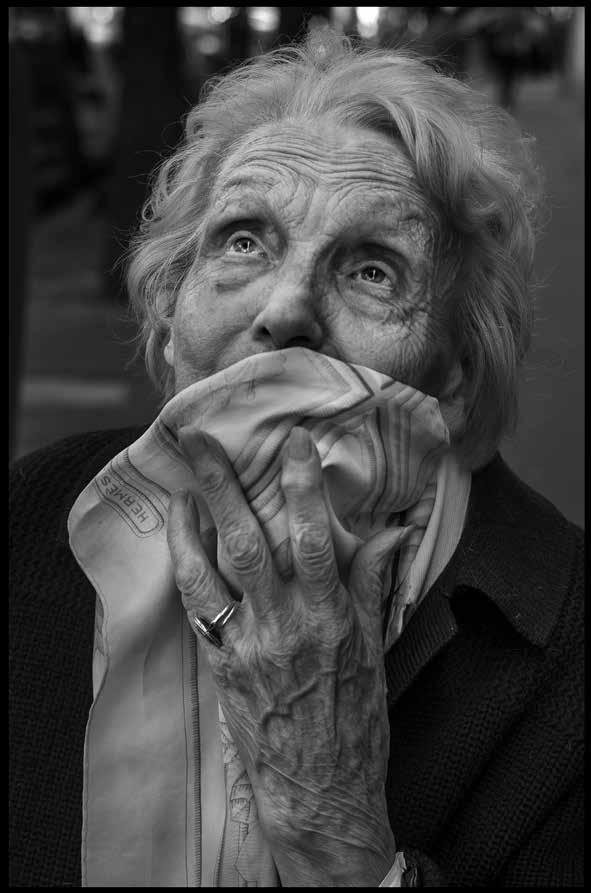
Printed in China ISBN: 978-0-578-74750-7
